
VOLUME 13.1
 Ulrich Krauer
General Manager Halekulani
Ulrich Krauer
General Manager Halekulani
It has been an interesting year, one that’s granted us the time to reflect, endure, and become stronger. We are pleased to present the latest edition of Halekulani Living, focusing on the past, change, and restoration.
In this issue, we remember Hawai‘i’s golden age of tourism through the postcards and other travel memorabilia that helped shape the islands’ reputation as a paradise of the Pacific. Catch a glimpse into the ongoing restoration efforts at ‘Iolani Palace, the only royal palace in existence in the United States. Follow along on a walk in the forest and learn how the state’s trail and access system, Nā Ala Hele, connects isolated places in the islands and brings hikers closer to Hawai‘i’s native landscapes and cultural heritage.
Also in this issue, we celebrate pā‘ū riders— wahine horseback riders in all their elaborate pageantry—both past and present, and step inside the studio of local artist Yvonne Cheng, known for her strong female portraits portraying full-figured women as regal and powerful subjects in her paintings.
In addition to inviting you to enjoy this highly anticipated issue of Halekulani Living, we also invite you to experience our restored Halekulani, which reopened on October 1 after undergoing renovations vital to perpetuating our legacy as we head into our second century. The project was both meticulous and wide ranging, encompassing the hotel’s infrastructure and public spaces, guest rooms, and suites. Our iconic House Without A Key restaurant has been reimagined to include a redesigned entry, a state-of-the-art exhibition-style glass kitchen, and contemporary furnishings. The Halekulani Fine Arts Collection will be introduced and exhibited throughout the hotel for guests to view and experience. Lastly, the landscaping has been renewed and enhanced to evoke a sense of serenity throughout the property.
Welcome back to our “House Befitting Heaven!”
この一年は、振り返り、耐え、強くなる時間を与えられた感慨深い一年 でした。このような時代にふさわしい、過去、変化、そして復興をテーマ にしたハレクラニリビングの最新号についてご案内します。
この号では、太平洋の楽園ハワイのイメージ構築に一役買ったハ ガキや旅行にまつわる記念品を通してハワイ観光の黄金時代を振り返 り、米国唯一の王宮であるイオラニ宮殿で進行中の修復作業について も触れています。ハワイ諸島の孤立した場所を結びハイキングを通して ハワイの原生林や文化遺産に親しむことのできるハワイ州のトレイル 情報源「ナ・アラ・ヘレ」についてもご紹介しています。
過去と現在のパウライダー(華やかな伝統衣装をまとった女性騎 手)を讃えるストーリー。またふくよかな女性の美しさを堂々と力強く描 く女性の肖像画で知られる地元のアーティスト、イボンヌ・チェンのスタ ジオに足を踏み入れます。
休刊していたハレクラニリビングを再びお楽しみいただけること を大変嬉しく存じます。そして創業第2世紀に向けて私たちのレガシー を永続させるために、その要となった改修工事を終えて2021年10月1 日にリニューアルオープンした新生ハレクラニでのひとときを存分にお 楽しみください。
今回の改装プロジェクトは、ホテルの基礎構造と公共スペース、 客室、スイートの広範囲におよぶもので、細心の注意を払って行われま した。ハレクラニを代表するレストランのハウス ウィズアウト ア キーは 入口のデザインを刷新し、最新のガラス張りのオープンキッチンとコン テンポラリーな家具を取り入れました。新しい「ハレクラニ ファイン ア ート コレクション」をはじめ、ホテル随所に展示される優れた芸術作品 をご堪能いただけます。敷地全体の造園デザインも、敷地内全体を静け さで包み込むように一新されました。
私どもの「天国にふさわしい館」へ再びお迎えできますことを、スタッフ 一同心よりお待ち申し上げております。
Halekulani Living 2
WELCOME
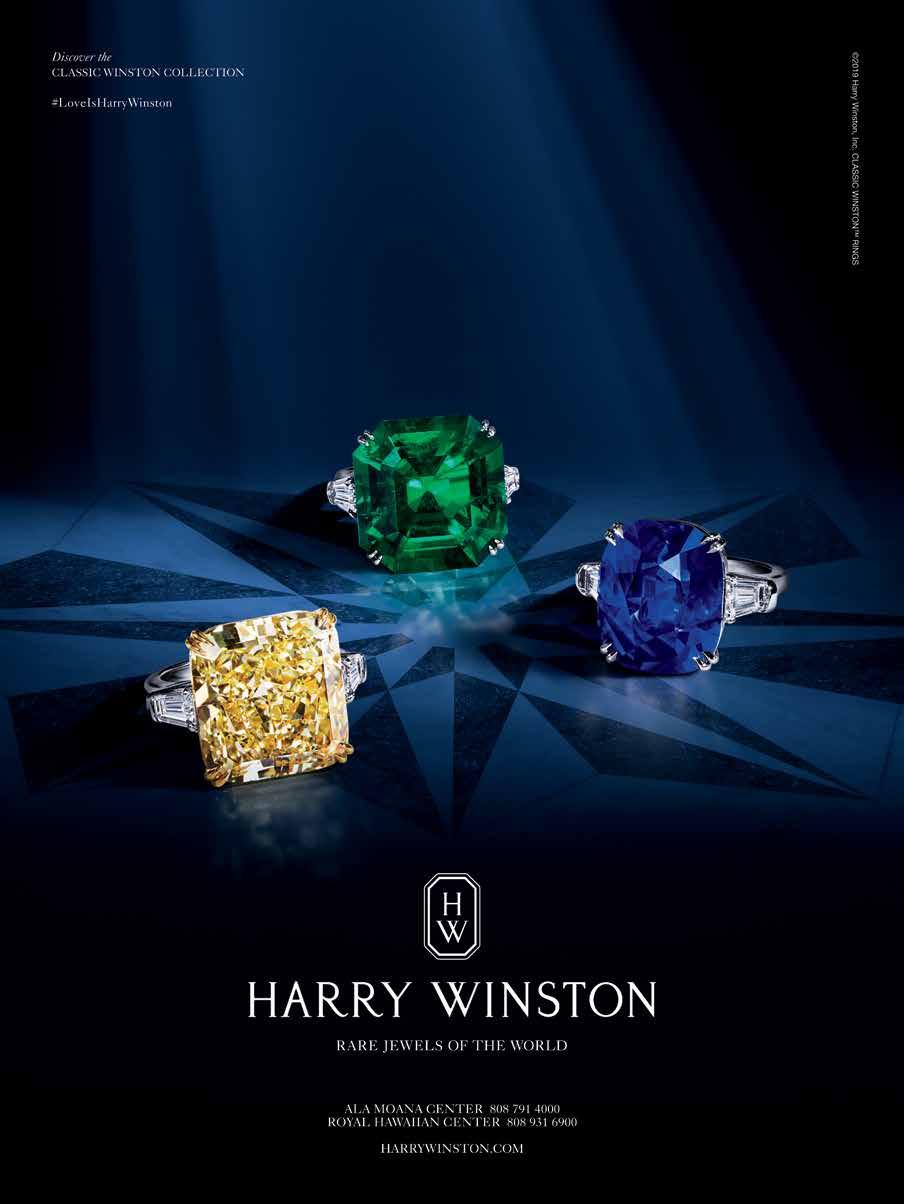
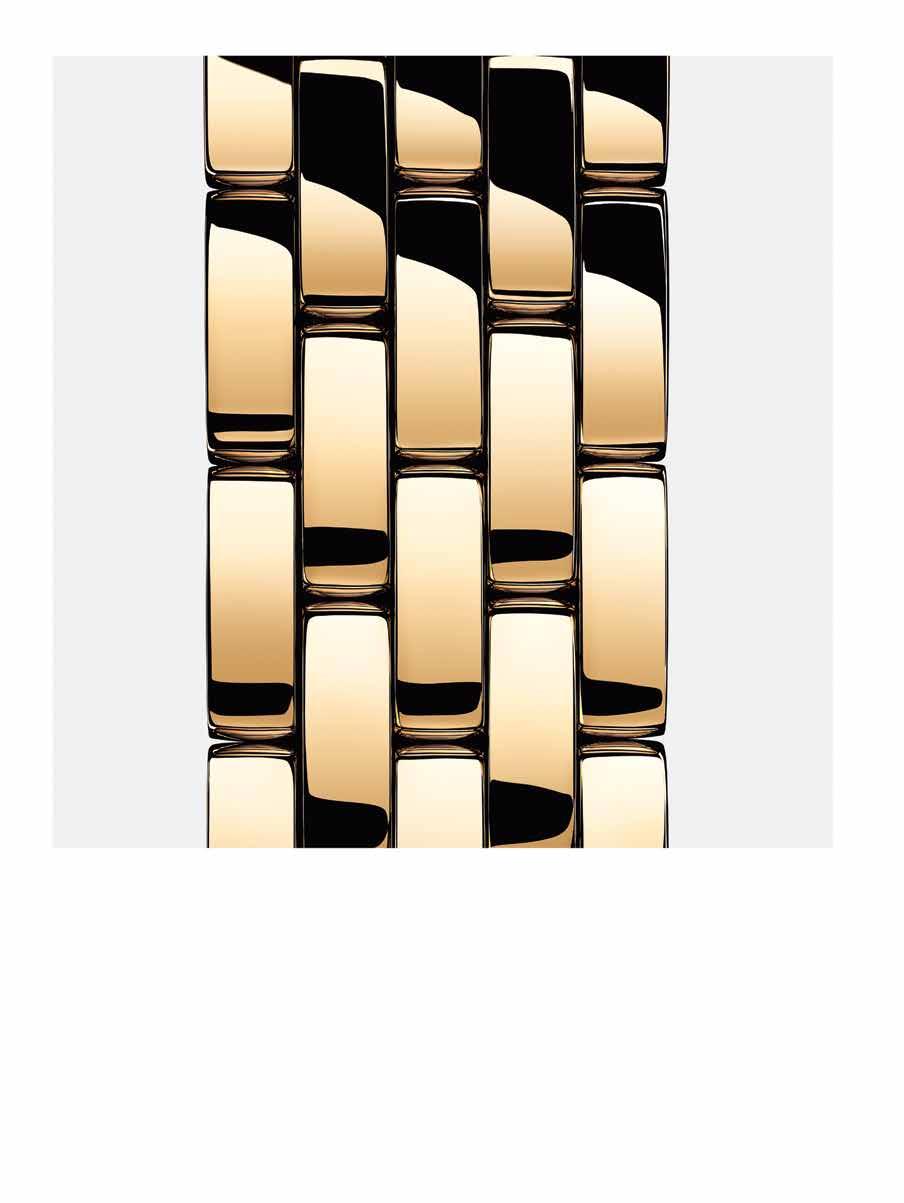
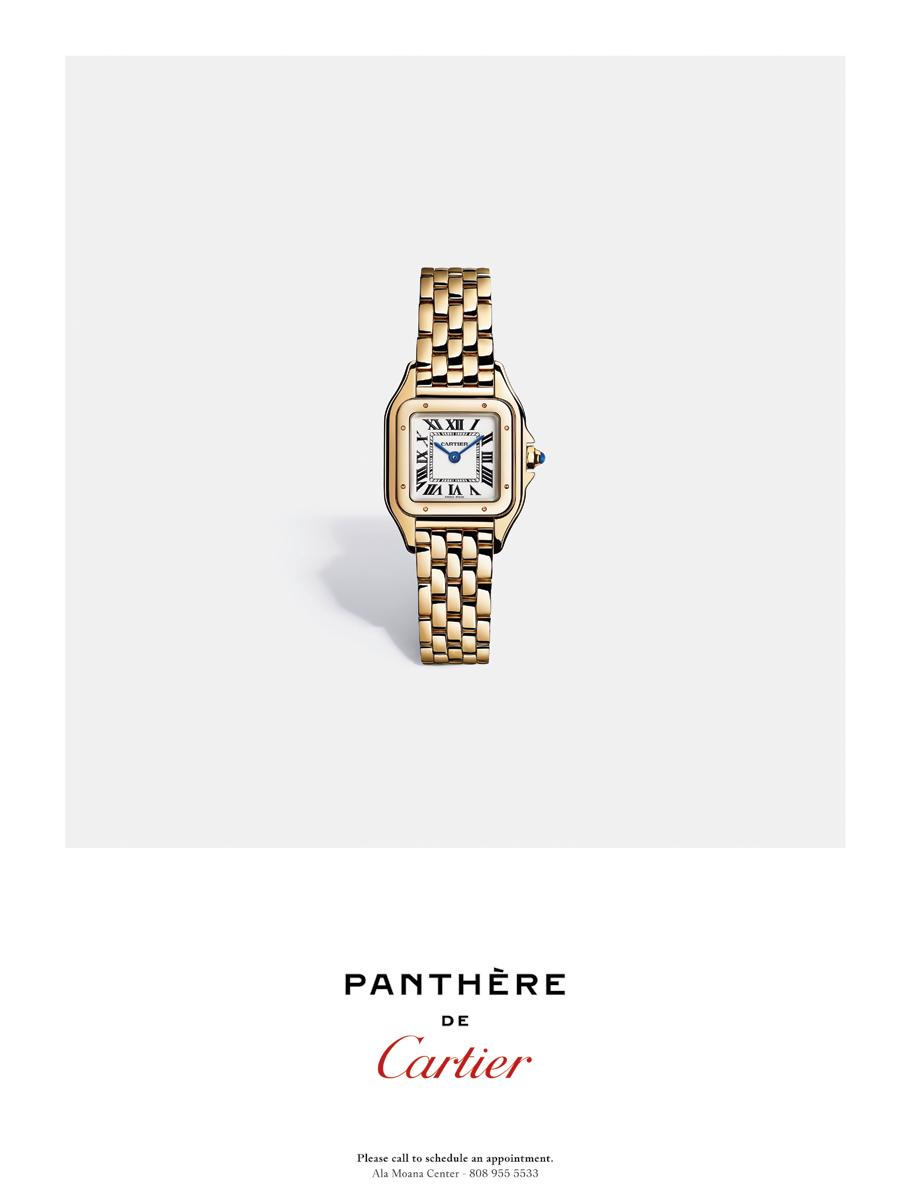

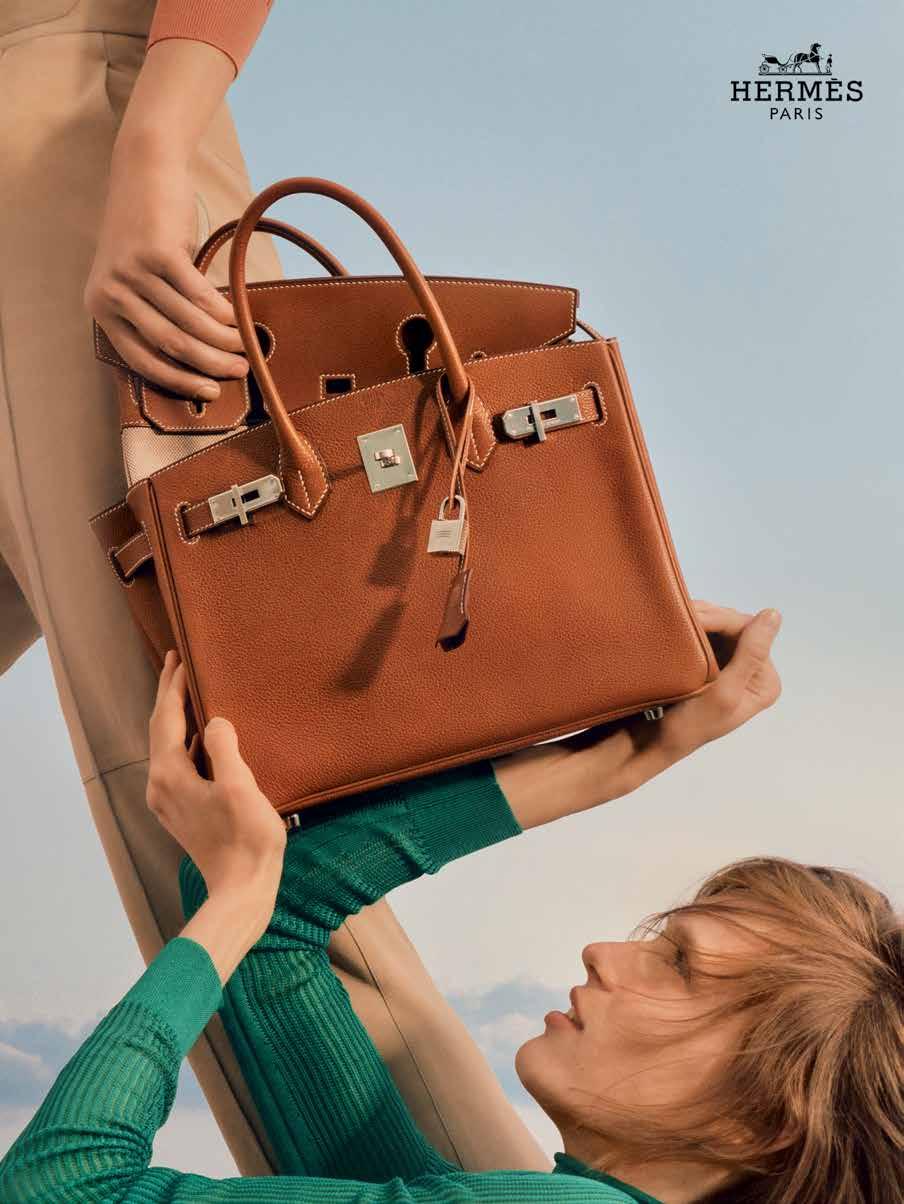

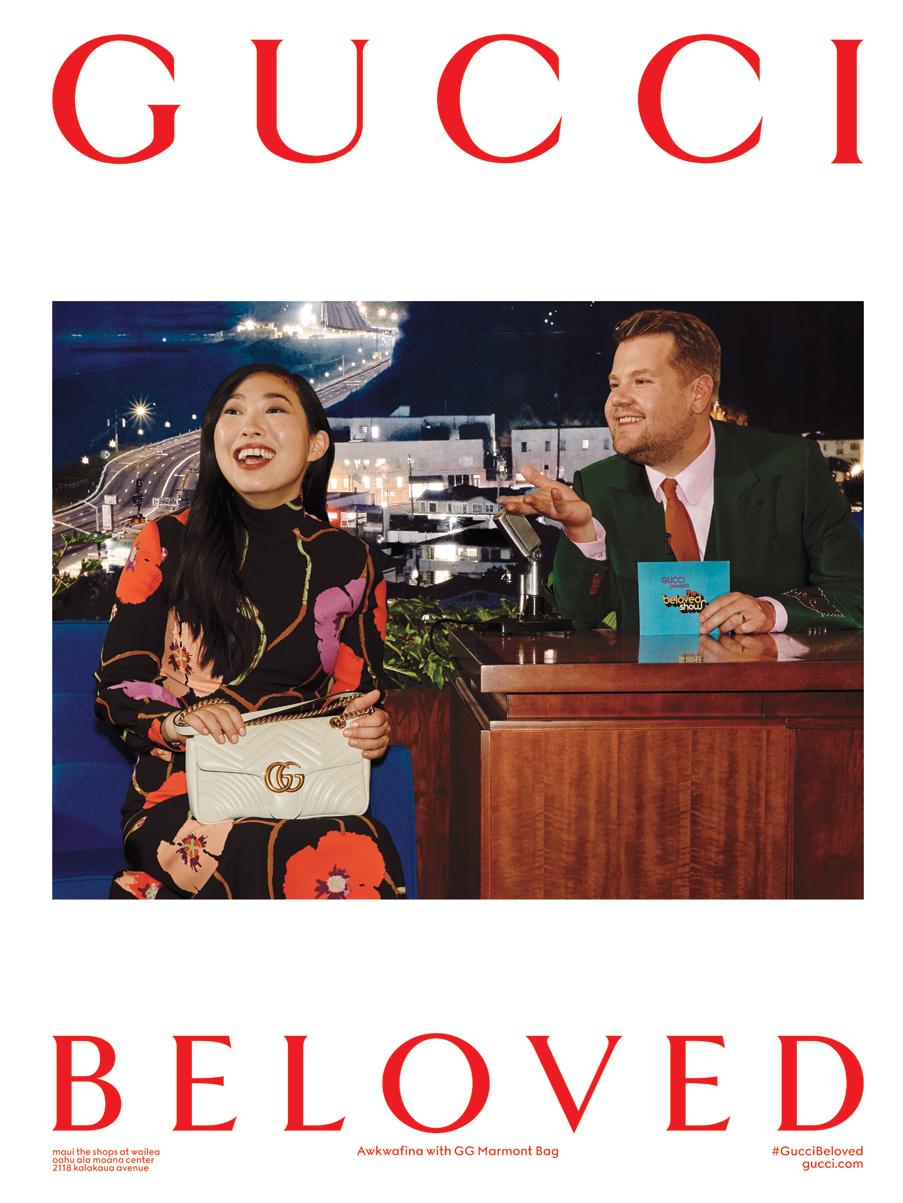
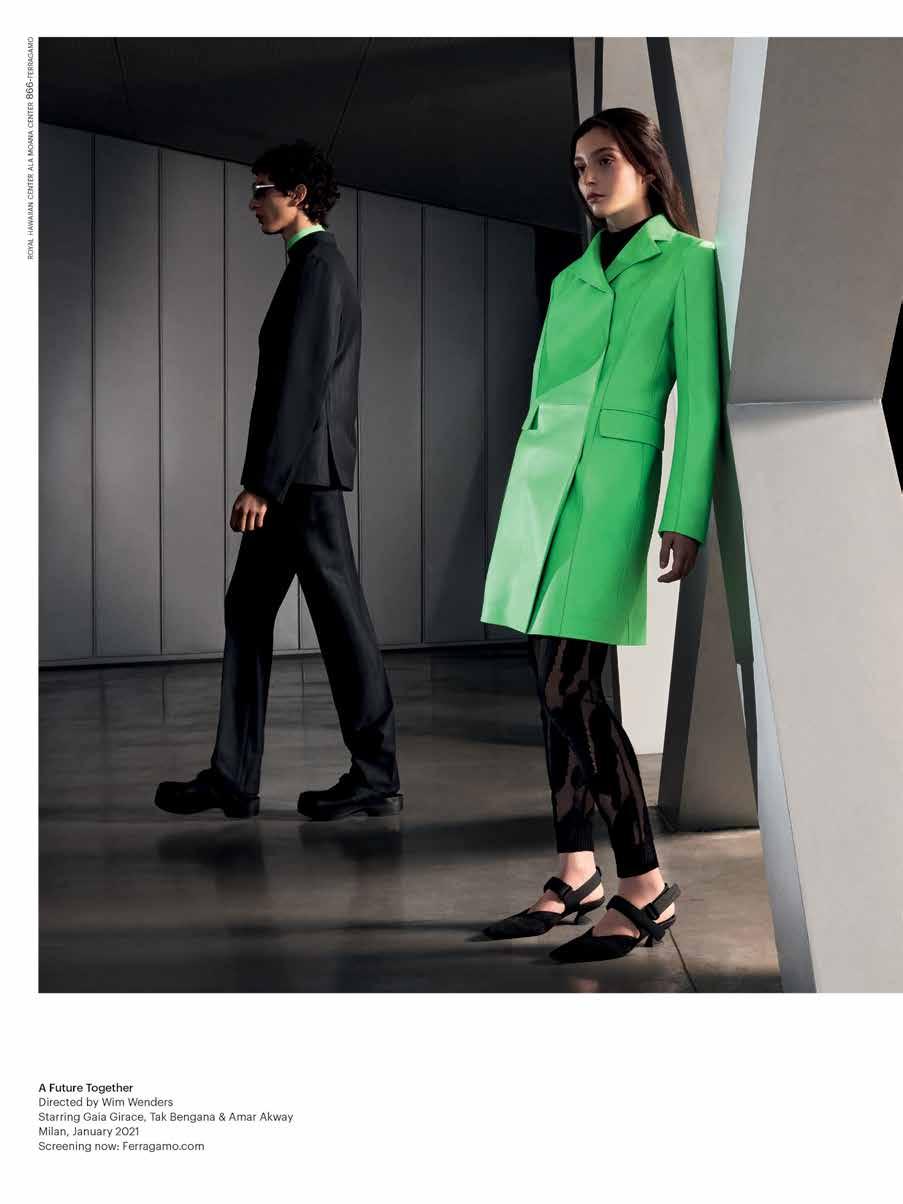

 Chanel
Chanel
Chanel

HALEKULANI CORPORATION
CHIEF OPERATING OFFICER
PETER SHAINDLIN
CHIEF EXECUTIVE ADVISOR
PATRICIA TAM
GENERAL MANAGER, HALEKULANI
ULRICH KRAUER
DIRECTOR OF SALES & MARKETING
GEOFF PEARSON
HALEKULANI.COM
1-808-923-2311
2199 KALIA RD. HONOLULU, HI 96815
CHIEF EXECUTIVE OFFICER
JASON CUTINELLA
GENERAL MANAGER, HAWAI‘I
JOE V. BOCK
JOE@NMGNETWORK.COM
VICE PRESIDENT, BRAND DEVELOPMENT
ARA LAYLO
EDITORIAL DIRECTOR
LAUREN MCNALLY
PUBLISHED BY NMG NETWORK
36 N. HOTEL ST., SUITE A HONOLULU, HI 96817 NMGNETWORK.COM
© 2021 by Nella Media Group, LLC. All rights reserved. No part of this publication may be reprinted without the written consent of the publisher. Opinions are solely those of the contributors and are not necessarily endorsed by NMG Network.
14 MASTHEAD Halekulani Living
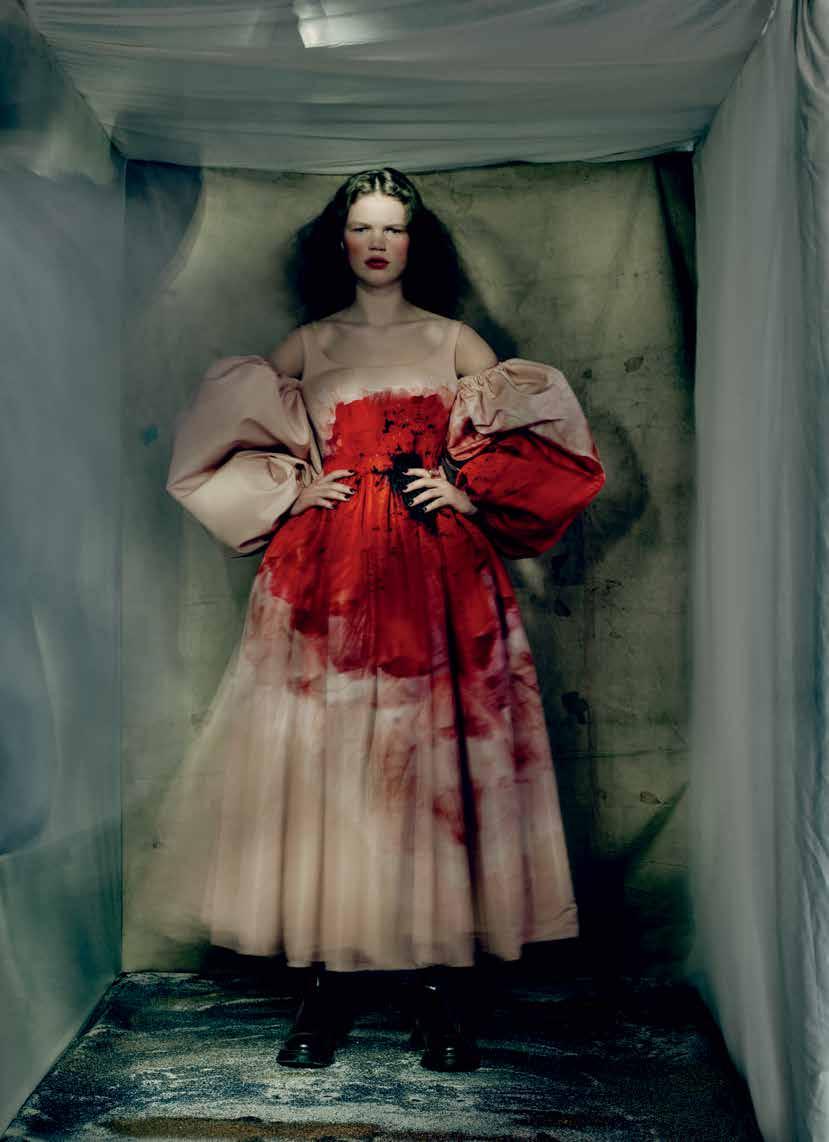
Softness meets splendor at Shangri La Museum of Islamic Art, Culture, and Design.
シャングリラ回教美術 館には穏やかさと豪華 さが融合している。

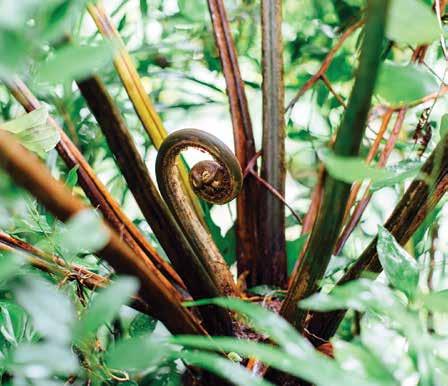
ARTS 24
TABLE OF CONTENTS
Picturing the Past 32
Preserving the Kingdom 44
Beauty and Batik
CULTURE 62
Hibiscus Hybrids 74
Nā Wahine Holo Lio
WELLNESS 88
Into the Green FASHION 98
Sanctuary by the Sea CITY GUIDES 118
Loving Lyrics 128
The Morning Catch 133
Cartier
Nā Ala Hele is a treasure trove of intel on Hawai‘i’s many glorious hikes.
ハワイの魅力あふれるハイ キングコースの情報が満 載のナ・アラ・へレ。
ABOUT THE COVER:
Photographer Mark Kushimi captures a moment at Shangri La Museum of Islamic Art, Culture, and Design with the museum’s executive director, Konrad Ng. View more on page 104, and wander the museum grounds alongside Ng on Living TV.
Halekulani Living
16
98 88

In old Hawai‘i, spirited horsewomen known as pā‘ū riders captured the popular imagination.
その昔、ハワイの人々の 心を捉えた颯爽とした女 性騎手のパウライダー。


62 ABOUT THE COVER:
TABLE OF CONTENTS
目次
ARTS 24
過去に想いを馳せて 32
王国の記憶を後世へ 44 バティックの美 CULTURE 62
ハイブリッドのハイビスカス
74
ナ・ワヒネ・ホロ・リオ
Hibiscus hybrids are unique creations that might not look anything like their parent flowers. 74
ハイビスカスの配合種は時 としてその両親の花とはまっ たく似つかない個性的な花 になる。
写真は写真家のマーク・クシミが事務局長のコンラッド・イング氏を撮影したシャングリラ回教美術館の風景。 詳しくは104ページをご覧ください。リビングTVではイング氏と美術館内の散策をお楽しみいただけます。
Halekulani Living 表紙について:
WELLNESS 88
大自然に飛び込もう FASHION 98
海辺の聖域 CITY GUIDES 118
愛しの歌 128
朝の釣果 133
カルティエ
18

Living TV is designed to complement the understated elegance enjoyed by Halekulani guests, with programming focused on the art of living well. Featuring cinematic imagery and a luxurious look and feel, Living TV connects guests with the arts, style, and people of Hawai‘i. To watch all programs, tune into channel 2 or online at halekulaniliving.tv.
客室内でご視聴いただけるリビング TVは、ハレクラニならではの上質な寛 ぎのひとときをお過ごしいただくため、 豊かで健康的なライフスタイルをテー マにしたオリジナル番組をお届けして います。臨場感溢れる映像で芸術や ファッション、食文化、ハワイの人々に ついてのストーリーをお楽しみくださ い。すべての番組は、2チャンネルまた はhalekulaniliving.tv からご視聴い ただけます。
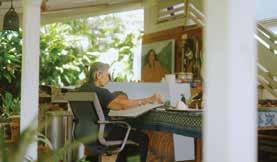

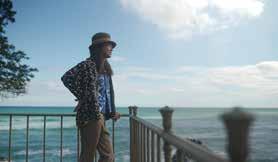
BEAUTY AND BATIK
バティックの美
Step inside the open-air studio of artist Yvonne Cheng, renowned for her powerful depictions of Polynesian women.
ポリネシアの女性を力強く描写した作品で知られるアーティス ト、イボンヌ・チェン氏のオープンエアスタジオを訪ねる。
HIBISCUS HYBRIDS
ハイブリッドのハイビスカス
An all-women team of horticulturists create one-of-a-kind flower hybrids at the Hibiscus Lady Nursery in Mokulē‘ia.
モクレイアのハイビスカスレディ植物園では園芸家の女性グルー プが世界に一つかないハイブリッドの花の新種を作り出している。
SANCTUARY BY THE SEA
海辺の聖域
The executive director of Shangri La Museum of Islamic Art, Culture, and Design roams the opulent former estate in style.
シャングリラ邸宅の事務局長が洗練された装いで豪華な旧邸宅 の敷地内を散策する。
watch online at: halekulaniliving.tv
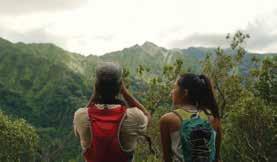
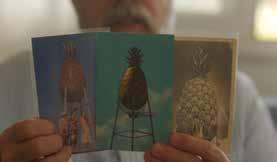
INTO THE GREEN
大自然に飛び込もう
Journey along the Mānoa Cliff Trail in this primer on Nā Ala Hele, Hawai‘i’s official trail and access program.
ハワイの公式トレイル&アクセスプログラム「ナ・アラ・ヘレ」の案 内でマノアクリフトレイルを旅する。
PICTURING THE PAST
過去に想いを馳せて 収集家がヴィンテージポストカードと旅の入場券や切符などの の膨大なコレクションの一部を公開する。
A collector offers a glimpse into his extensive assortment of vintage postcards and travel ephemera.
WHAT TO WATCH
20

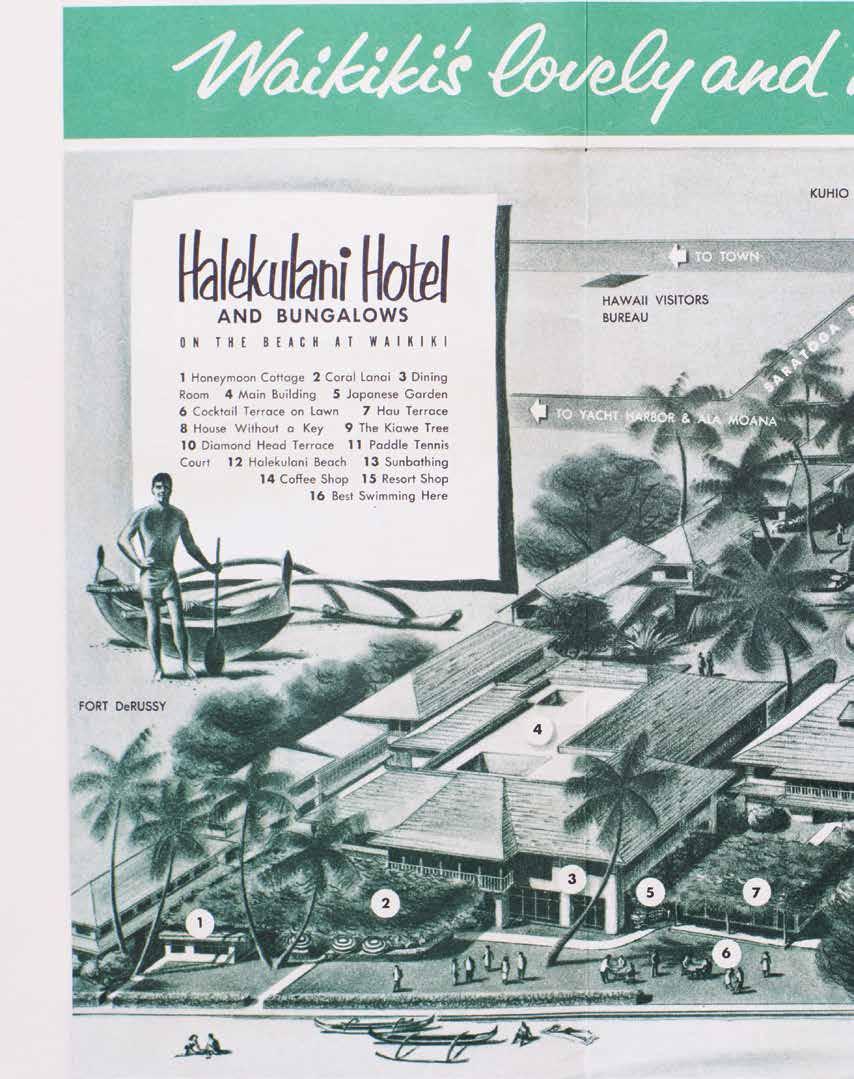 IMAGE BY JOSIAH PATTERSON
IMAGE BY JOSIAH PATTERSON
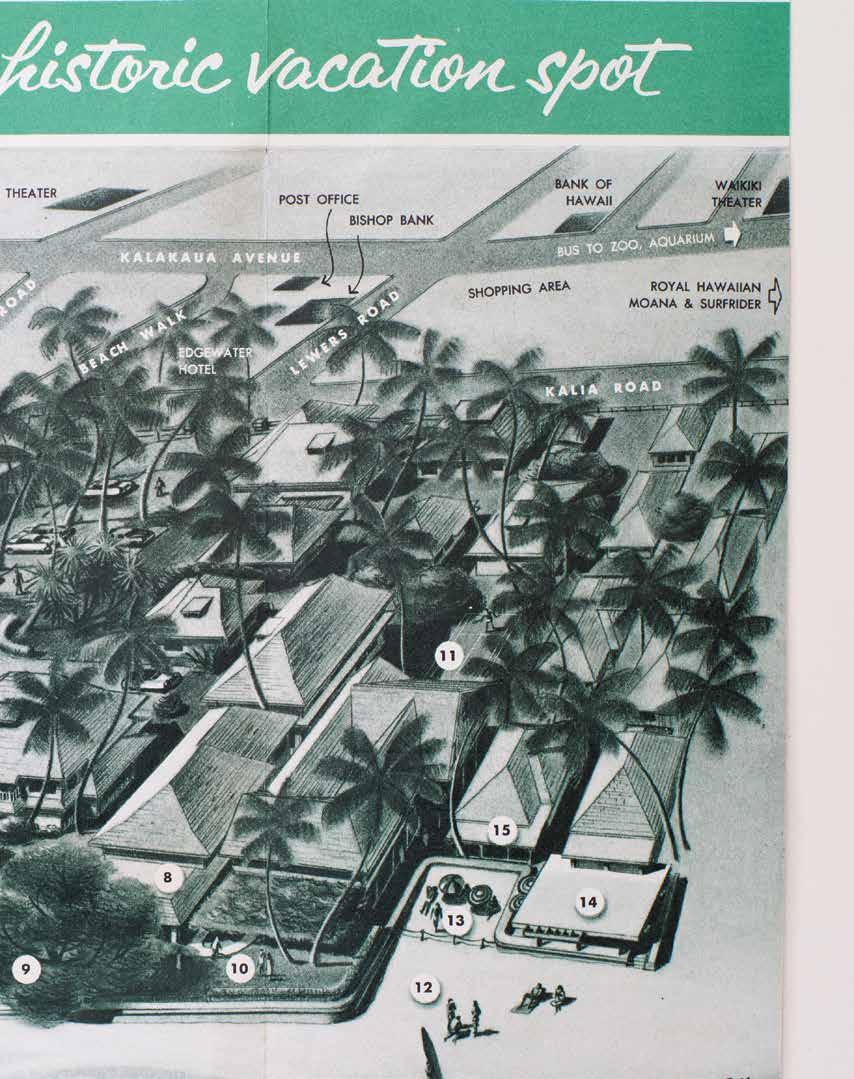
ARTS
TEXT BY LINDSEY KESEL
IMAGES
BY
JOSIAH PATTERSON
文=リンジー・ケセル
写真=ジョサイア・パターソン
PICTURING THE PAST
過去に想いを馳せて
A
growing
collection of vintage postcards and travel ephemera offers a peek at Hawai‘i’s golden era of tourism.
ハワイ観光の黄金時代が垣間見れるヴィンテージ絵葉書や旅行にまつわるエフェメラのコレクション
A collector’s rare postcards are portals back in time to Hawai‘i’s early days as a tourist destination.
コレクターの珍しいポストカ ードは、観光地となって間も ない初期のハワイへと誘って くれるポータルだ。
Hunting down postcards and other printed memorabilia with detective-like doggedness, Spencer Tolley is fascinated by the iconic Waikīkī of old. A corporate travel agent with a background in historic preservation, Tolley began searching for tokens of Hawai‘i tourism after he moved from Miami to Honolulu in 2012. Diving into local ephemera fed his lifelong passion for collecting and let him explore the rich history and architecture of his new home. “Postcards were ideal for showing the evolution of Waikīkī through the decades and the genesis of how it was marketed to tourists,” he says. “You could have people dining, sitting on the beach, or being entertained by singers and hula dancers, and other activities that promoted the area’s best attributes.”
Tolley is a deltiologist—a collector of postcards— but he’ll take just about anything that sparks nostalgia and reflects Hawai‘i’s image as an exotic travel destination before the 1980s.
Known for his Instagram handle @fotoaloha, where he curates and catalogs his findings, Tolley scours eBay and collectible shows to acquire shareworthy relics. He has upwards of 3,000 items, most of which are postcards but which also include brochures of bygone resorts, maps, magazines, Kodachrome slides, matchbooks, menus, and luggage tags. Tolley’s two oldest postcards, from 1900 and 1901, feature Art Nouveau vignettes of the Hawaiian Hotel (which stood where the Hawai‘i State Art Museum is now) and various Waikīkī landmarks. Among his most unusual acquisitions is a bar of hand soap from the Waikikian Hotel, the last of the tiki-style hotels of the 1950s, which met its demise in 1996 to make way for a high-rise condominium.
古き良きワイキキに魅せられたスペンサー・トリーさんは、ポストカー ドや記念用印刷物の熱心なコレクターだ。史跡保護分野での経験を 持つ法人向け旅行エージェントのトリーさんは、2012年にマイアミ からホノルルに引っ越して以来、ハワイ旅行の記念アイテムを収集し ている。地元の入場券や切符などの収集の世界にはまり込み、幼いこ ろからの収集熱に火がついたという彼はコレクションを通して、ハワ イの豊かな歴史と建築について学んでいるという。「この数十年間の ワイキキの移り変わりや観光地としてどのようなイメージで宣伝され てきたか、ポストカードを通してその歴史を目で見ることができます。 そこには食事やビーチ、歌手やフラダンサーのショーを楽しむ人々の 姿、そしてハワイの壮大な自然を満喫できるアクティビティが写ってい ます」と話す。
トリーさんは主に絵葉書の収集家だが、ハワイがまだエキゾチ ックな旅行先だった1980年代以前のイメージを反映した懐かしさを 感じさせるあらゆるアイテムを集めている。@fotoalohaのハンドルで 知られるトリーさんは、インスタグラム上で掘り出し物を収集し、見や すく分類して紹介する。eBayやコレクタブルショーの展示品を調べあ げ、希少なアイテムを落札する。彼は現在、3,000以上のアイテムを所 有している。そのほとんどが絵葉書だが、中には今はなきリゾートのパ ンフレットや地図、雑誌、コダクロームのスライド、紙マッチ、メニュー、 ラゲージタグといったものまである。彼のコレクションの中で一番古い 1900年と1901年の2枚のポストカードには、現在のハワイ州立美術 館の場所に建っていたハワイアンホテルのアールヌーヴォー様式の装 飾とワイキキのランドマークがいくつも描かれている。もっとも珍しい ものの一つに、1950年代最後のティキスタイルホテルだったワイキキ アンホテルの石鹸がある。高層マンション建設のため、1996年に解体 されたホテルだ。
Halekulani Living 24
ARTS

Tolley is especially interested in postcards and original photographs of four hotels that were trendsetters during Waikīkī’s rise: Halekulani Hotel, Coconut Grove Hotel (where the Imperial Hawaii Resort sits today), Seaside Hotel (replaced by the Royal Hawaiian hotel), and ‘Āinahau Court (now the site of Sheraton Princess Kaiulani hotel). The design vernacular of these bungalow-type properties influenced the entire Waīkikī streetscape from the 1910s to the late 1930s, including simple, craftsmanstyle architecture, outdoor pavilions, and wood pergolas. The mass influx of tourists following World War II and an evolution in modern architecture trends eventually made this era of cottage-style accommodations “a thing of the past,” Tolley says.
One of the collector’s most cherished items is a Halekulani Hotel brochure that recalls the charm and elegance of Waikīkī hospitality in the late ’40s and early ’50s. Its cover photo shows smiling couples enjoying sunset social hour, highballs in hand, accompanied by text that reads: “With historic Diamond Head as a stately backdrop, guests enjoy traditional Halekulani service on the cool watersedge lawn at cocktail time.” Opened in 1917 at the intersection of Kalia Road and Lewers Street, Halekulani was among the first guest houses owned and operated by a sole proprietor, and the only one still operational today.
For his thrice-weekly Instagram posts, Tolley delights in sharing multiple finds united by a curious thread. In one post, he presents two 1950s postcards with nearly identical images of the coffee shop lānai at Halekulani Hotel. The photos were shot on the same day by Irving Rosen but deployed by different postcard makers. In another series of posts, he shares three items featuring the same photo of the Moana Surfrider hotel taken in 1952: a Pan American Airways postcard, a Bell System print ad, and a jigsaw puzzle.
トリーさんがとりわけ好んで集めているのがワイキキの台頭時 にトレンドセッターとなったハレクラニホテル、ココナッツグローブホ テル(現在のインペリアル・ハワイ・リゾートのある場所)、シーサイドホ テル(ロイヤル・ハワイアン・ホテルに変わった)、アイナハウコート(現 在のシェラトン・プリンセス・カイウラニホテル)の4つのホテルのポス トカードとオリジナルの写真である。シンプルで職人技が光る建築や 屋外パビリオン、木製のパーゴラといったこれらのバンガロースタイル のホテル独特のデザインは、1910年代から1930年代後半にかけて のワイキキの街並み全体に影響を与えた。やがて第二次世界大戦後 の観光客の大量流入と近代建築のトレンドの変化によって、この時代 のコテージスタイルの宿泊施設は時代遅れになっていった。
トリーさんの貴重なコレクションのひとつに、40年代後半から 50年代初頭のワイキキホテルの魅力と優雅さを思い出させるハレク ラニホテルのパンフレットがある。ハイボールを手に夕暮れ時の社交 を楽しむ笑顔のカップルの映る表紙の写真には「歴史と風格のあるダ イヤモンドヘッドを背景に、カクテルタイムの涼しい水辺の芝生で伝 統的なハレクラニのサービスを楽しむゲスト」という文章が添えられ ている。1917年にカリアロードとルーワーズ通りの角にオープンした ハレクラニは、個人事業主が所有・運営したハワイで最初のゲストハ ウスのひとつであり、そのうち今も営業している唯一のホテルだ。
トリーさんは週3回のインスタグラムの投稿で、複数の掘り出 し物に面白い共通点を見つけて楽しんでいる。その中に、ハレクラニ ホテルのコーヒーショップのベランダの酷似する2枚の写真を使っ た1950年代のポストカードがある。同じ日にアーヴィン・ローゼン氏 が撮影した写真を異なるポストカードメーカーが起用したものだ。別 の投稿では、1952年に撮影されたモアナサーフライダーホテルの同 じ写真を使ったパンアメリカン航空のポストカード、ベルシステムの チラシ、そしてジグソーパズルといった3種類のアイテムが紹介され ている。
Halekulani Living 26 ARTS
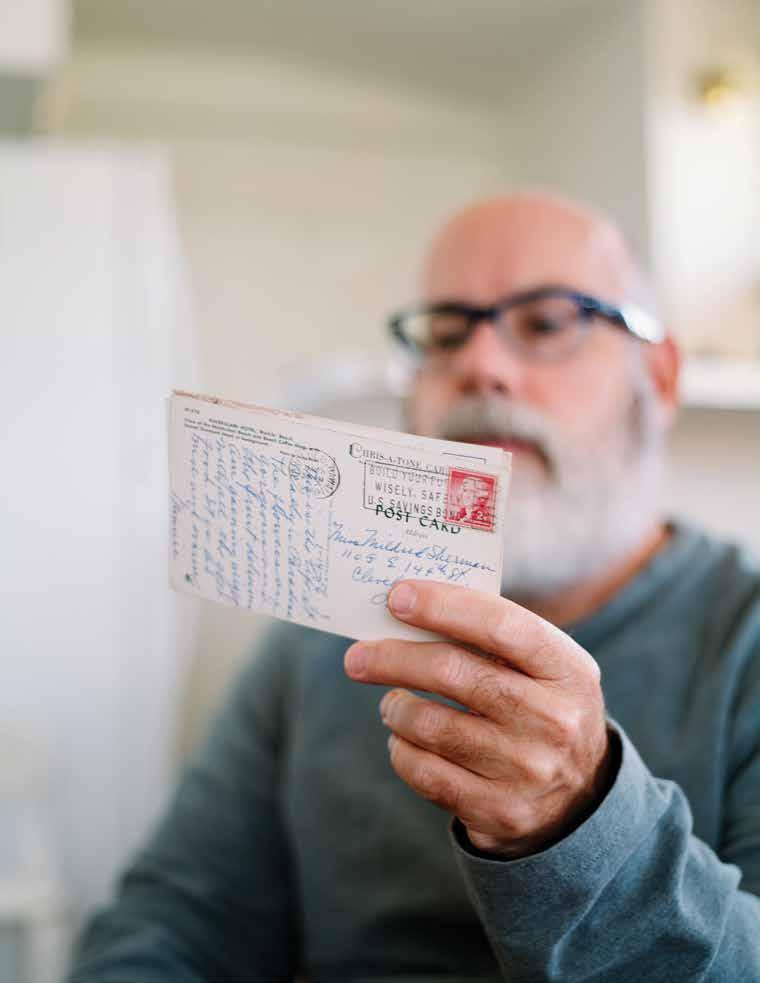
Spencer Tolley, the collector behind the Instagram account @fotoaloha, scours eBay and collectible shows to acquire share-worthy relics.
インスタグラム上で@fotoalohaのハンドルで知られる収集家、スペン サー・トリーさんはレアな逸品を求めてeBayやコレクタブルショーを 物色する。
27
One of the collector’s most cherished items is a Halekulani Hotel brochure that recalls the charm and elegance of Waikīkī hospitality in the late ’40s and early ’50s.
トリーさんの貴重なコレク ションのひとつに、40年代 後半から50年代初頭のワ イキキホテルの魅力と優 雅さを思い出させるハレク ラニホテルのパンフレット
がある。

A Coconut Grove brochure in Tolley’s collection reflects the dramatic shift in how Hawai‘i was presented to vacationers as the tourism industry ramped up. The mid-50s brochure features a bikini-clad woman with lei draped over her forearm greeting visitors on the cover, and brightly illustrated beach scenes. While earlier marketing took a more subdued approach, the brochure embodies the “new” Waīkikī aimed at attracting a younger, middle-class market. Readers are promised “complete relaxation and freedom from cares” and “cleanliness, courtesy, convenience and comfort ... unexcelled anywhere in Hawai‘i.”
トリーさんのコレクションにあるココナッツグローブのパンフレ ットを見れば、観光産業が急成長するにつれ、旅行者に訴求するハワ イのイメージが激変したことが分かる。50年代半ばのパンフレットの 表紙には腕にレイをかけて旅行者を迎えるビキニの女性と眩しいビー チの風景が描かれている。それ以前の広告はもう少し落ち着いた雰 囲気で、パンフレットは若い中流階級層にアピールする「新しいワイ キキ」をテーマに「究極のリラクゼーションと心の解放」、そして「清潔 さ、丁重なおもてなし、便利さと快適さで勝る場所のないハワイ」と謳 っている。
Halekulani Living 28 ARTS

Out of the four hotels that Tolley considers trendsetters during Waikīkī’s rise, Halekulani is the only one still operational today.
トリーさんがワイキキの台頭 時にトレンドセッターだったと いう4つのホテルのうち、ハレ クラニは現在も営業している 唯一のホテルだ。

Tolley’s rare postcards are instant portals to a time when Hawai‘i seduced adventure-seekers from around the globe with an air of enchantment. In an Instagram post is one such postcard from 1964 featuring a honeymooning couple relaxing in Halekulani Hotel’s tropical garden, their hands caressing a single red lei. Signed “Mary Belle and Norbert,” the inscription reads, “This is a fabulous place. The jet ride was grand. I can hardly believe this is real.” Careful to include both the front and back of the postcards and foregoing hashtags and narration, Tolley says, “I want the viewer to experience it the way the recipient did, and let the details tell the story.”
トリーさんの珍しいポストカードは、冒険を求める世界中の人 々を独特の魔力で魅了した時代のハワイにタイムスリップさせてくれ る。@fotoalohaのインスタグラムには、ハレクラニホテルのトロピカ ルガーデンでくつろぎ、一本の赤いフラワーレイを愛でるハネムーンカ ップルの映った1964年のポストカードの写真が載っている。裏にはメ アリー・ベル&ノーベルトという差出人のサインが入っていて「ここは 素晴らしい場所だ。ジェット機のフライトも最高だった。これが現実だ なんて信じられないほどだ」と書かれている。このポストカードの両面 の写真をあえてハッシュタグとナレーションなしで投稿したトリーさん は言う。「この絵葉書の受取人と同じ気持ちを味わって欲しいんだ。あ とはディテールが物語っているからね」。
Halekulani Living 30 ARTS

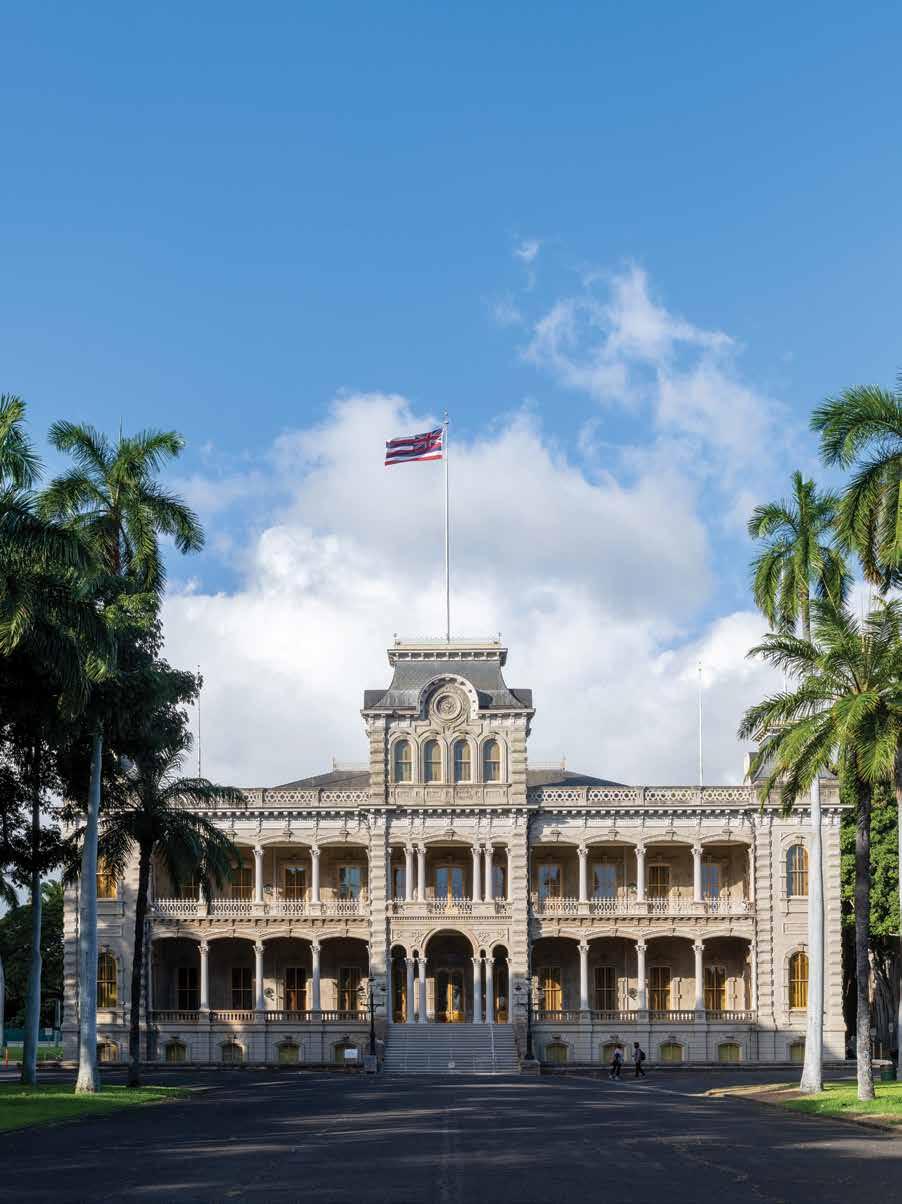
BY
TEXT
JACKIE OSHIRO
IMAGES BY CHRIS ROHRER
文=ジャッキー・オオシロ 写真=クリス・ローラー
PRESERVING THE KINGDOM’S MEMORY
王国の記憶を後世へ
The ongoing restoration of ‘Iolani Palace goes far beyond fixing floorboards.
床板の修理にとどまらないイオラニ宮殿の改修・保存プロジェクト

ARTS 33
Living
Halekulani
Stepping into the halls of ‘Iolani Palace, the sounds of downtown Honolulu fade away. The chandeliers above cast a warm light, giving a sepia hue to the ornate paneling and lush drapery that signify the status of the palace’s former residents. To all who enter, it is clear this was a place that held great power.
Less apparent is the effort involved in maintaining such a storied place. Behind each new floorboard and refurbished lock is an incredible amount of thought and consideration. Those working on the palace’s upkeep pay respects not just to the building but also to the former kingdom. ‘Iolani Palace is an emblem of Hawaiian sovereignty, and efforts to restore the palace serve to simultaneously preserve the memory of the Hawaiian Kingdom and immortalize the tragedy of its overthrow.
The current palace building was constructed between 1879 and 1882 under the reign of King Kalākaua, replacing an older building of the same name used by the four kings before him. In stark contrast to the old palace, which was a singlestory plantation-style house, Kalākaua’s palace was designed to evoke the grand palaces of Europe. Beneath its Italian Renaissance-inspired exterior, ‘Iolani Palace was shockingly modern for its time, with indoor plumbing, electricity, and telephones installed years ahead of the White House.
It is still debated whether Kalākaua’s approach to the palace was excessive, but his choices were deliberate. The palace, in all its extravagance, was a symbol of the nation, and with increasing American and European influence in the kingdom, the king intended to show that Hawai‘i rightfully belonged within the international community of sovereign states.
In 1893, however, just two years after Kalākaua’s passing, the monarchy was overthrown by 13 proAmerican businessmen looking to protect their profits. At the time, Kalākaua’s sister, Lili‘uokalani, ruled as queen and was working to restore authority to the Native Hawaiian people by overturning the 1887 constitution, which Kalākaua signed under duress and shifted significant power to the
イオラニ宮殿のホールに足を踏み入れると、ホノルルのダウンタウンの 喧騒が一気に遠のいてゆく。天井のシャンデリアは暖かい光を放ち、か つての宮殿の居住者の地位を象徴する豪華な羽目板とカーテンをセピ ア色に染めている。一歩中に入ればこの場所が偉大な影響力を持って いたことは誰の目にも明らかであろう。
だがこの歴史的建物を維持するための努力は一見しただけでは わかりづらい。床板の張り替えや錠の改修作業ひとつとっても、非常に 細やかな配慮がなされている。宮殿の維持管理を行う人たちは建物自 体のみでなく、旧王国に対して敬意を払うことを忘れない。なぜならイ オラニ宮殿はハワイの主権国家の象徴であり、宮殿を復元する取り組 みはハワイ王国の歴史を風化させず、その転覆の悲劇を永遠に伝える 役割を担っているからだ。
現在の宮殿の建物はカラカウア王の治世中、1879年から1882 年の間に建設され、歴代4人の王が使用していた同じ名前の古い建物 に取って代わった。平屋建てのプランテーションスタイルの家屋だった 旧宮殿とは全く対照的に、カラカウア王の宮殿はヨーロッパの壮大な パレスを想起させる設計であった。イタリアのルネサンス様式のような 外観のイオラニ宮殿は当時としては驚くほど近代的で、ホワイトハウス より何年も前に屋内配管や電気が通り、当時はまだ珍しかった電話も 設置されていた。
カラカウアの宮殿に対するアプローチが行き過ぎだったかどうか は未だに議論が続いているが、彼の選択は意図的なものであった。宮 殿はその贅沢さのすべてにおいて国の象徴であり、王国におけるアメリ カとヨーロッパの影響力が増すにつれ、国王はハワイが主権国家として 国際社会の一員であることを世界に示す必要があった。
それでもカラカウアの没後からわずか2年の1893年、ハワイの 君主制は私利を追求する13人の親米実業家たちによって打倒され た。当時、女王に即位していたカラカウアの妹のリリウオカラニはネイ ティブハワイアンの権利を取り戻すため、1887年憲法の改正を試み た。それは カラカウアが強制的に署名を強いられ、米欧支配の政権に 圧倒的な権限を与えるものだった。1895年、王政復古を目指すネイ ティブハワイアンの王族支持者が反乱を起こし、それに関与した疑い で逮捕されたリリウオカラニは、宮殿の2階の寝室に1年間にわたり幽 閉された。
Halekulani Living 34 ARTS

Behind each new floorboard and refurbished lock is an incredible amount of thought and consideration.
床板の張り替えや錠の改修作業ひとつとっても、非常に細やかな配慮がなさ れている。
35

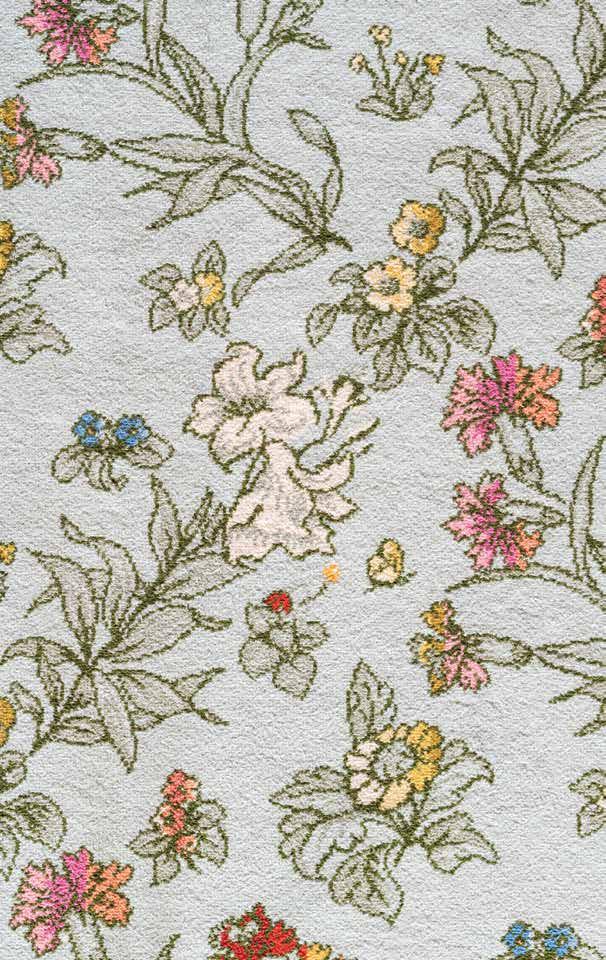
After the Overthrow of the Hawaiian Kingdom, walls and other modifications were added to ‘Iolani Palace, which obscured many of its original features.
ハワイ王国の転覆後、イオラ ニ宮殿は仕切り壁や改造など の手が加えられ、元のデザイ ンの多くが失われてしまった。

American- and European-controlled legislature. In 1895, a small faction of Hawaiian royalists attempted a counter-revolution. Lili‘uokalani was arrested for her alleged role in the uprising and placed under house arrest at the palace, where she was held for a year in a second-floor bedroom.
‘Iolani Palace was the center of the Hawaiian Kingdom for just 11 years, but within that short time, it witnessed the burgeoning potential of a sovereign people, and saw that crushed by the hand of capitalistic greed. It is this history and cultural importance that color the efforts to restore and upkeep the palace and its surrounding buildings today.
After the Overthrow, ‘Iolani Palace remained the islands’ seat of government as Hawai‘i transitioned into a U.S. territory and, later, a state. In 1969, with the completion of the Hawai‘i State Capitol building, the palace was retired after almost 90 years of continuous use. Over the years, the palace’s interior was altered
イオラニ宮殿がハワイ王国の中心的役割を担ったのはわずか11 年間であったが、宮殿はその短い歳月において主権たる国民が飛躍的 な発展を遂げる可能性を貪欲な資本主義者たちが握り潰す歴史を目 の当たりにした。現在進行中の宮殿と周辺建物の修復維持の取り組み には、この歴史と文化的意義が深く影響している。
王国の転覆後、ハワイが米国の領土に併合され、のちに州とな ってもしばらくの間イオラニ宮殿は政府の公式な所在地であり続け た。1969年にハワイ州議会議事堂が完成し、ほぼ90年間にわたって 使用された宮殿はその役目を終えた。その間、宮殿の内装は議会のニー ズにあわせて手が加えられた。仕切り壁が立てられ、改築されたために 元のデザインの多く失われてしまった。
1979年から宮殿の保存活動に携わり、最近では改修プロジェ クトの主任建築家を務めるグレン・メイソン氏は「州議会の下院が王 座の間、上院は食堂を使用し、知事執務室は2階にありました。当時の 建物を記憶している人は非常にみすぼらしかったと言います」と教え てくれた。
Halekulani Living 38
ARTS

Those working on the palace’s upkeep pay respects not just to the building but also to the former kingdom.
宮殿の維持管理を行う人たちは建物自体だけではなく、旧王国に対し ても敬意を払っている。
39
To all who enter, it is clear that ‘Iolani Palace was a place of great power.
イオラニ宮殿の中へ一歩足 を踏み入れれば、かつて偉 大な影響力を持つ場所であ ったことがわかる。
to accommodate the needs of the legislature. Walls and other modifications were added, which obscured many of its original features.
“The House of Representatives occupied the throne room, the Senate occupied the dining room, and the governor’s office was upstairs,” says Glenn Mason, who has worked on palace restorations since 1979 and serves as the lead architect on the palace’s more recent renovation efforts. “Anybody who actually remembers the building at that time will tell you that it just looked shabby.”
According to Mason, “Building the capitol is what emptied the palace and allowed it to be restored.” Once the building was no longer occupied, restorers were able to go through and conduct what Mason calls “exploratory surgery,” literally breaking through the supplementary walls to uncover the original layout and long-forgotten details.
With the palace’s original materials, however, restorers were much more careful. “If you look at the koa staircase today,” Mason explains, “you can see where the new pieces went in and termite damage was repaired. You can see the patches, but that’s just an illustration of [them] saving as much of the original material as possible. They really did a wonderful job.”
While the major restoration effort was completed in 1976, individual projects have continued. However, funding is irregular, and the more time passes between projects, the more difficult they become. Mason and his firm have overseen 11 restoration phases since 1985, including the restoration of the Coronation Pavilion, roofing improvements, and exterior plaster reconstruction. Throughout this time, Mason has noticed that the materials and expertise necessary are increasingly less available. The palace’s original gates, for example, were forged rather than welded, and at the time of the 1970s restoration, Hawai‘i had a forger who could refabricate damaged posts. Today, a similar project would require contracting work in another state.
「新たに州会議事堂が建てられ、議会が移転してから宮殿の復 元が可能になりました」。空いた建物内に修復士が入って調査し、メイ ソン氏が「探索的手術」と呼ぶ復元作業に取りかかった。後付けの仕切 り壁を除去して元のレイアウトを再現し、長い間隠れていたディテール を明らかにしていく作業だ。
修復士たちは宮殿の元の建材を生かすことにとりわけ気を使っ た。「今も残るコア製の階段を見ると、シロアリによる損傷を修繕するた めにどの部分に新しい資材が使われされたのか一目でわかります」とメ イソン氏は説明する。「ところどころに継ぎ目が見えるでしょう。これは できるだけ元の資材を残すためなのです。彼らは本当に素晴らしい仕 事をしています」。
大規模な修復作業は1976年に完了したが、個別のプロジェク トは今も続いている。資金調達には不確実性が伴い、プロジェクト間の 時間が長ければ長くなるほど資金調達は難しくなる。メイソン氏と彼 の会社は、戴冠式パビリオンの修復、屋根の改修、外装石膏の再建な ど、1985年以来11の復元プロセスを監督してきた。その間、必要な資 材と専門知識の確保が年々困難になっているという。たとえば宮殿にも ともとあった門は溶接ではなく鍛造されていた。1970年代の修復の時 点で、この傷んだ柱を再建できる鍛造工は州内に一人しかいなかった という。今日、このようなプロジェクトには州外から専門の業者を雇わ なければならない。
Halekulani Living 40 ARTS

41
While the major restoration effort was completed in 1976, individual projects have continued.
大規模な修復作業は1976 年に完了したが、個別のプロ ジェクトは今も続いている。

As the palace approaches its 140th birthday, there is still much to do. Paula Akana, executive director of the Friends of ‘Iolani Palace, notes that the current project list is more than 200 items long, and funding is less certain than ever, as the Covid-19 pandemic has greatly reduced visitor numbers. Paradoxically, this uncertainty cements the palace’s importance to the islands. ‘Iolani Palace stands as an embodiment of the determination of the former Hawaiian Kingdom. To preserve the palace is to preserve a piece of that strength within the people of Hawai‘i today.
宮殿が生誕140周年を迎えるにあたり、やるべきことはまだたく さんあるという。フレンズ・オブ・イオラニパレスのエグゼクティブディレ クターのポーラ・アカナさんは、現在のプロジェクトリストには200項目 以上あり、新型コロナウイルス感染症のパンデミックにより訪問者数が 激減した影響で、これまで以上に資金調達の不確実性が増していると 話す。逆を言えば、不確実であるからこそハワイにとってこの宮殿を残 す意義は大きい。イオラニ宮殿はかつてのハワイ王国の強い意志を具 現化するものだ。宮殿の保存は、今日のハワイの人々の中に秘められた 強さを後世へ伝えることを意味している。
Halekulani Living 42
ARTS
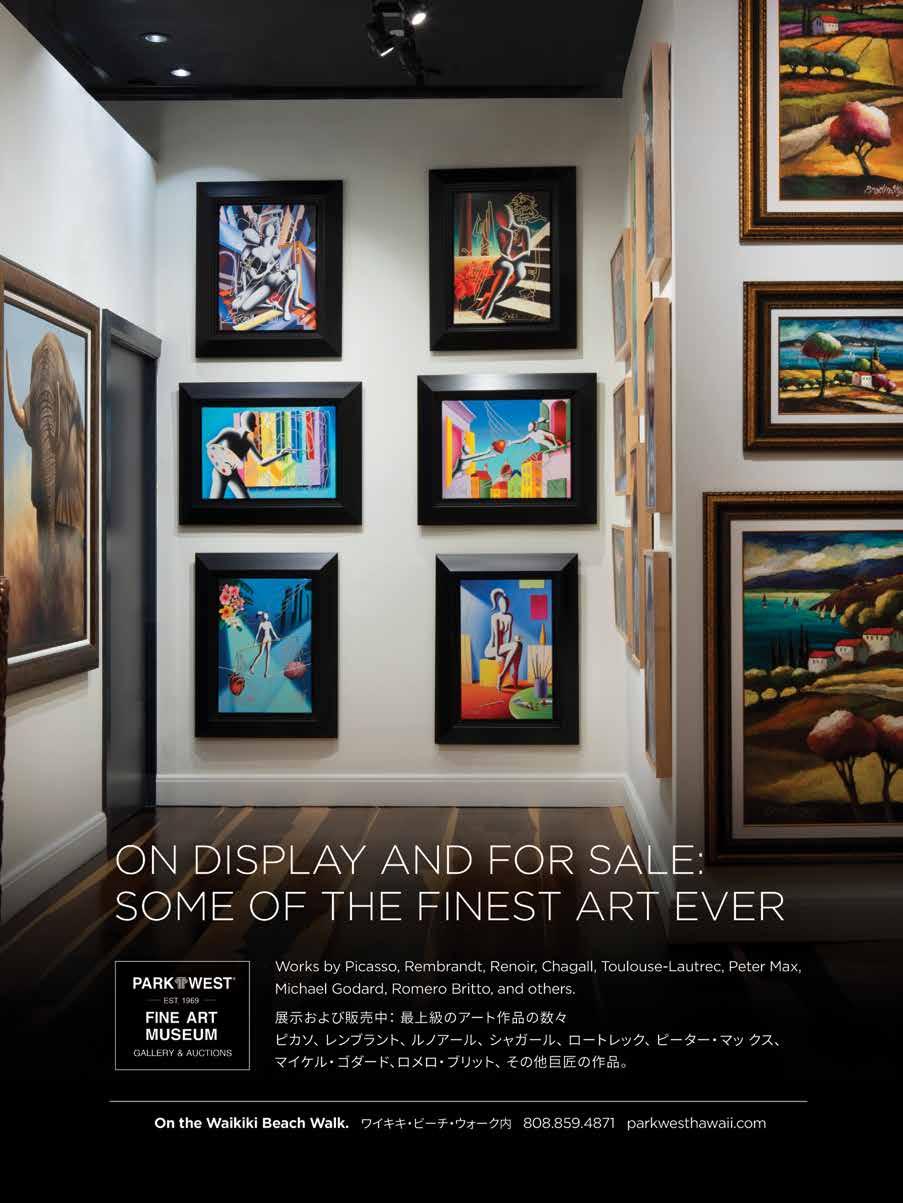 TEXT BY JOSH TENGAN
IMAGES BY MARK KUSHIMI BEAUTY AND BATIK
TEXT BY JOSH TENGAN
IMAGES BY MARK KUSHIMI BEAUTY AND BATIK
文=ジョシュ・テンガン
写真=マーク・クシミ
バティックの美
More than 50 years ago, the artist Yvonne Cheng took a batik class at Bishop Museum. Since then, she’s become one of the most enduring figurative painters in the islands.
半世紀以上前にビショップ博物館でバティック染めのクラスを受講したイヴォンヌ・チェンさんは、いまやハワイで最も愛される画 家の一人である。
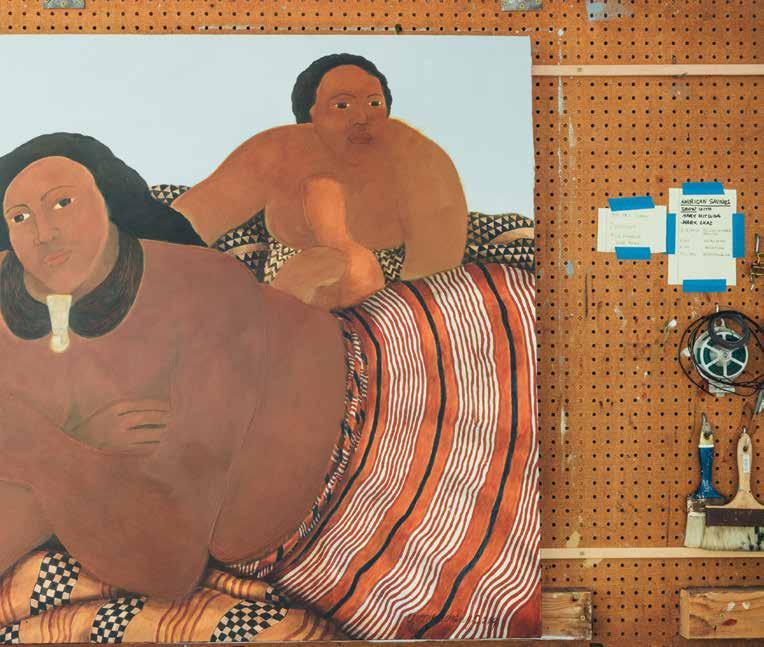
Living
Halekulani
ARTS 44

Yvonne Cheng’s artistry in Honolulu has many chapters. The 79-year-old artist is known best for her large-scale paintings of Polynesian women, some that have been rendered into public mosaic murals across the islands and purchased for private collections. But her career is also full of surprises, with projects including stained glass for a chapel at the Grand Wailea resort on Maui, textiles for Kahala Sportswear, and interior design for a local CEO’s offices and private jet.
A working artist for more than 50 years, she still finds herself painting most mornings at her garden studio in Mānoa. When I join Cheng at her home on a Saturday morning to talk story, the moment feels privileged. Cool Mānoa breezes sweep through the yard as we converse over pastries and tea, looking back on a life rich in art and experience.
Born in Surabaya, East Java, in 1941, Cheng was raised in Jakarta, Indonesia’s capital. The 1940s were tumultuous, beginning with the Japanese occupation of the country during World War II. One of Cheng’s earlier childhood memories was being taken to an internment camp set up by the Japanese. Following the war, Indonesia declared independence from the Dutch Empire, and after a bloody four-year revolution, it received formal independence from its colonizers in 1949.
After the war, Cheng spent her childhood and teenage years in Dutch schools, where she says her education was “very intense” and unsurprisingly Eurocentric. “The crazy thing is that we had to learn the entire history of Holland, but we learned very little of Indonesian history,” says Cheng, who began studying art and drawing at a young age. Her grasp of the human figure is no doubt partly due to close study of Dutch masters like Rembrandt, Vermeer, and Van Gogh. But it wasn’t until 1967, when Cheng and her then husband settled in Hawai‘i after a stint in Cambridge, Massachusetts, where they sought political refuge, that her art career began.
Upon moving to Honolulu, Cheng enrolled in a batik class at Bishop Museum. Batik, a textile tradition native to Java, is a part of Indonesia’s national dress and a tradition with which she was familiar. Learning the labor-intensive wax-resist dyeing technique thousands of miles away from her homeland was a re-education of sorts. Simultaneously, she became fascinated with Oceanic textiles found in the museum’s collections. Tapa, bark cloth typically made from wauke (the paper mulberry plant), is found throughout the Great Ocean.
イヴォンヌ・チェンさんのアートはホノルルで花開き、変化に富んだ道を たどってきた。大きな画面にポリネシアの女性たちを描く作品で知られ るチェンさんは、現在79歳。その作品はモザイクの壁画としてハワイの さまざまな公共建築を飾るものから、個人のコレクションとして購入さ れるものまでさまざまだ。チェンさんの仕事は絵画のみにとどまらず、 驚くほど多彩で、これまでに手がけたプロジェクトには、たとえば、マウ イ島グランド・ワイレア・リゾートのチャペルのステンドグラスやカハラ・ スポーツウェアのテキスタイル、とあるハワイ企業のCEOのオフィスと 専用ジェット機のインテリアデザインなどもある。
アーティストとして半世紀以上活動してきたチェンさんは、今も ほぼ毎朝、マノアにある庭のアトリエで制作に取り組んでいる。ある土 曜の朝、私はチェンさんを訪ね、涼しいマノアのそよ風が吹き抜ける庭 でペストリーと紅茶をいただきながら、アートと豊かな経験に満ちた半 生の物語に耳を傾ける機会に恵まれた。
チェンさんは1941年、東ジャワのスラバヤで生まれ、インドネシ アの首都ジャカルタで育った。1940年代は第二次大戦が勃発した混 乱の時代で、インドネシアは日本軍に占領された。幼かったチェンさん の記憶には、日本軍の強制収容所に連行されたことが刻まれているそ うだ。オランダ王国の植民地だったインドネシアは大戦後すぐに独立 を宣言し、4年にわたる血なまぐさい戦争を経て、1949年に正式に独 立を獲得する。
チェンさんは戦後も10代までオランダ式の教育を受けた。「非常 に厳格」で、当然ながらヨーロッパ中心の世界観にもとづいた教育だっ た。「 まったくおかしなことに、オランダの歴史はこと細かに勉強させ られたのに、インドネシアの歴史はほとんど教わらなかったんですよ」と チェンさんは振り返る。幼い頃から美術やデッサンに親しんでいたチェ ンさんの人物描写力には、レンブラント、フェルメール、ゴッホといった オランダの巨匠たちの作品をじっくり学んだ成果があらわれている。し かし、彼女のアーティストとしてのキャリアが開花したのは、当時の夫と 共にマサチューセッツ州のケンブリッジで政治難民の申請をし、1967 年に夫婦でハワイに身を落ち着けてからだった。
ホノルルで暮らし始めたチェンさんは、ビショップ博物館で行わ れていたバティックのクラスに参加した。バティックはジャワ島に伝わ る更紗で、インドネシアでは正装に用いられる。チェンさんにとっては 馴染み深いものだった。故郷から何千マイルも離れた土地でバティッ クという手間のかかるろうけつ染めの技術を勉強するのは、自らの伝 統文化を改めて学び直す体験だったという。チェンさんは同時に、ビシ ョップ博物館に展示されていたオセアニアの布地にも惹きつけられた。
Halekulani Living 46 ARTS

Through the 1980s, Cheng worked almost exclusively in batik before taking up painting on canvas.
チェンさんは絵筆をとってキャンバスに向かうまで、1980年代を通して バティック制作に打ち込んだ。
47


Upon moving to Honolulu, Cheng became fascinated with Oceanic textiles like tapa—bark cloth typically made from the paper mulberry plant.
ホノルルに引っ越して以来、 チェンさんはクワ科のカジノ キの樹皮から作られた布“ タパ”のようなオセアニアの 島々の不織布に魅了され ている。

In Sāmoa it is called siapo. In Tonga, ngatu. Fijians call it masi. In Hawai‘i, it is called kapa and was used for clothing, sleeping, religious ceremonies, and burial practices. Cheng was struck by the intricate geometric designs and the delicate textured watermarks beaten into the cloth itself, a signature of the practice in Hawai‘i. In the late 1960s through the 1970s, the second Hawaiian Renaissance was growing, and kapa, considered a lost art form since the 1890s, was being rediscovered by artists like Malia Solomon, Puanani Van Dorpe, Marie McDonald, and Moana Eisele. It was
おもにワウケ(紙の材料となるコウゾの仲間)の木の皮から作られる「タ パ」は、南太平洋諸島全域で見られる。サモアでは「シアポ」、トンガでは 「ンガトゥ」、フィジーでは「マシ」と呼ばれ、ハワイでは「カパ」という名 で、衣服や寝具として使われるほか、宗教儀式や埋葬にも用いられてい た。チェンさんは、精緻な幾何学模様のデザインと、叩く工程で布その ものに繊細な透かし模様をつけていくハワイのカパ特有の技術に目を みはったという。
1960年代後半から1970年代にかけて第二次ハワイアンルネッ サンスが興隆し、マリア・ソロモン、プアナニ・ヴァン・ドープ、マリー・マク
Halekulani Living 50
ARTS


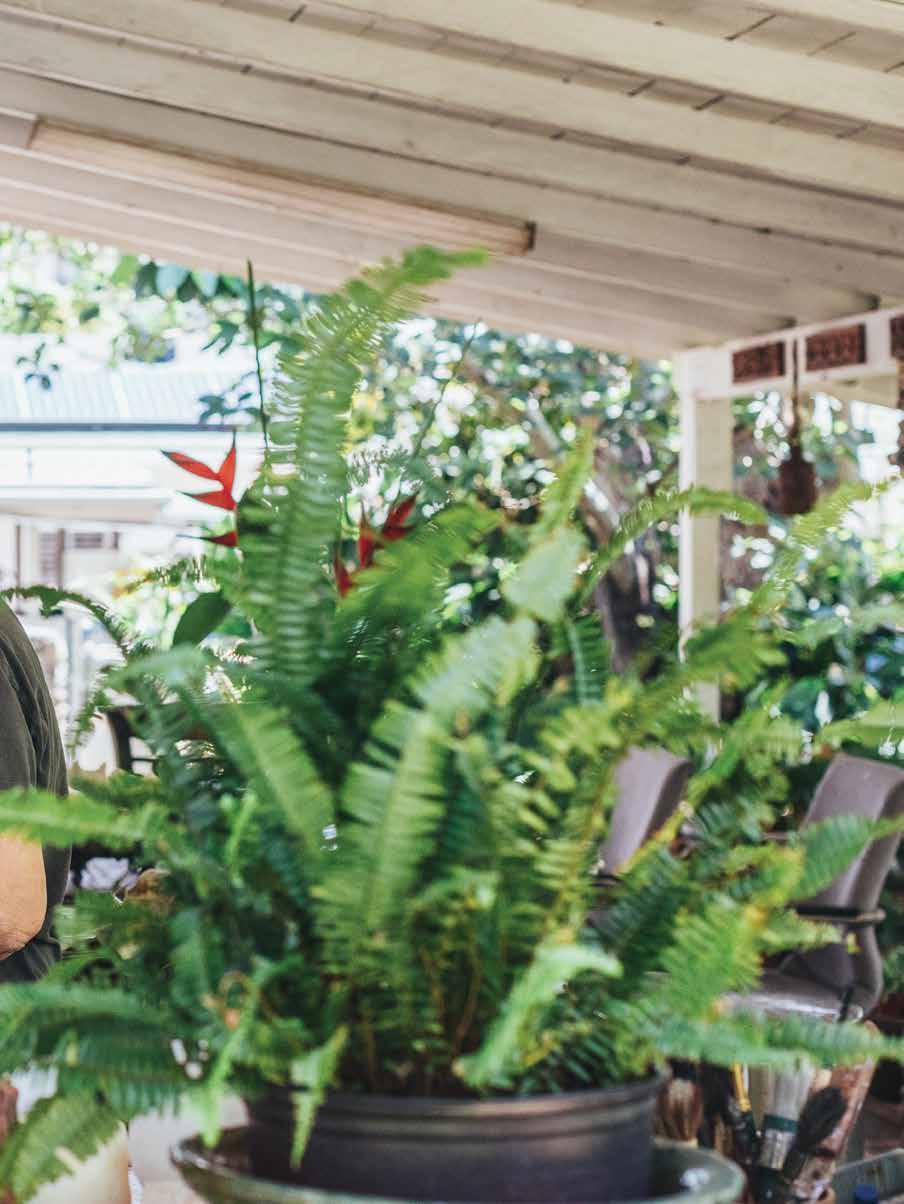
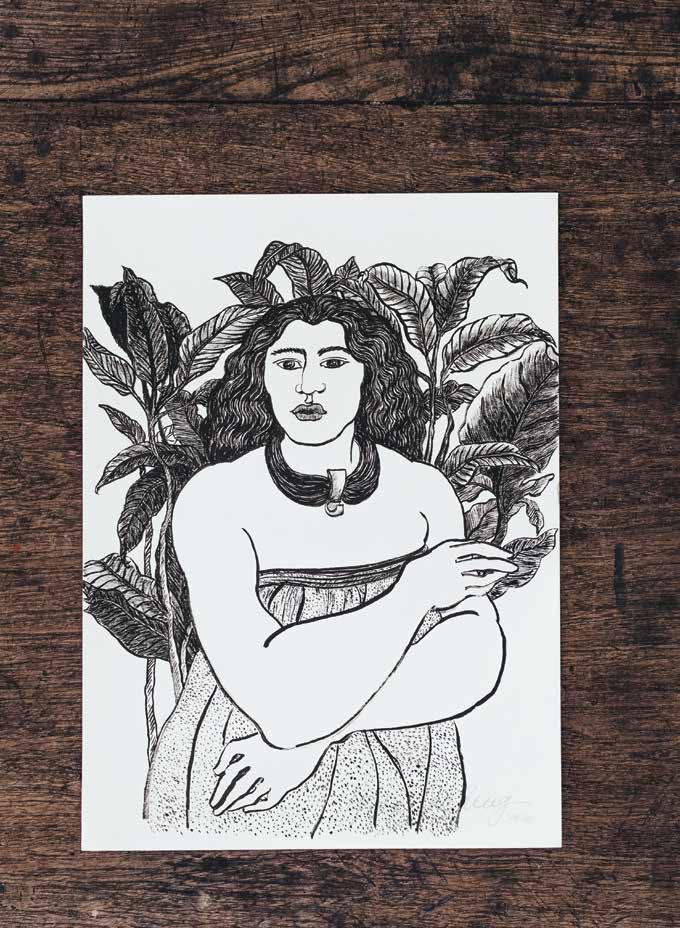
Cheng’s compositions almost always feature Polynesian women of a bygone era, often draped in swaths of kapa, tied across their bodies into pā‘ū (skirts), kīhei (capes), and kīkepa (sarongs).
チェンさんは、パウ(スカート)やキヘイ(ケープ)、キケパ(サロング)とい ったカパをまとった昔日のポリネシア女性たちを描き続けている。
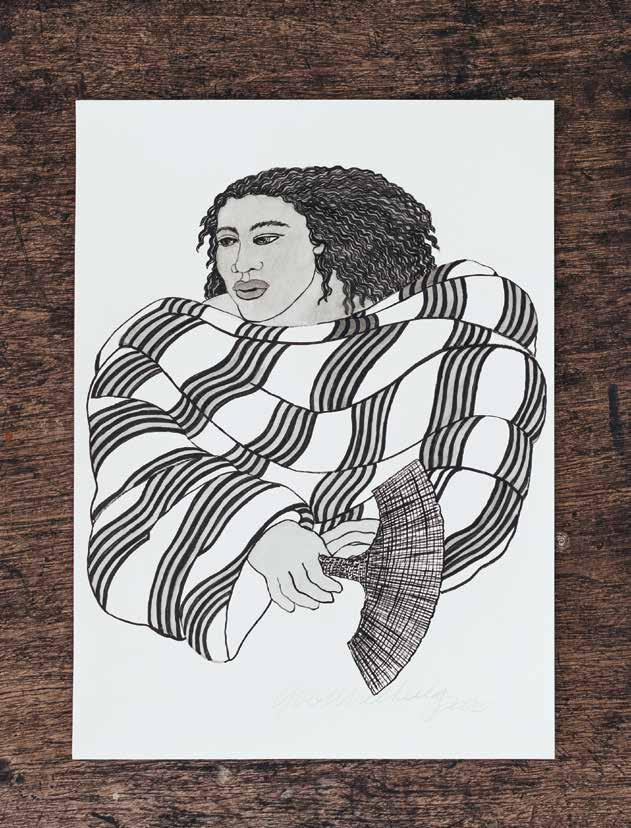
Like the akua wāhine of Hawaiian mythology, her figures exude a powerful sensuality, gracefulness, and dignity that is almost mystical, commanding the gaze of the viewer.
その姿は作品から浮き上がって見えるほど力強く、ハワイの神話に登場 する女神たちのように、官能的で優雅で、神々しいほどの威厳をもって見 るものの視線を釘づけにする。
A working artist for more than 50 years, Cheng still finds herself painting most mornings at her garden studio in Mānoa.
50年以上アーティストとし て活動するチェンさんは、 今もほぼ毎朝マノアのガ ーデンスタジオで絵を描い ている。

during the Renaissance that Cheng began to develop her own visual language. She celebrates the pattern work of tapa through the use of her native batik process. Stunning examples of her batik work can be found in the state’s Art in Public Places Collection and at the University of Hawai‘i Hamilton Library. She would work in batik through the 1980s before taking up painting on canvas as a less laborious process.
Till this day, Cheng’s compositions almost always feature Polynesian women of a bygone era, often draped in swaths of kapa, tied across their bodies into pā‘ū (skirts), kīhei (capes), and kīkepa (sarongs). The geometric designs cascade over powerful brown bodies, larger than life, buoyant, floating on the surface of the work. Like the akua wāhine of Hawaiian mythology, her figures exude a powerful sensuality, gracefulness, and dignity that is almost mystical, commanding the gaze of the viewer. Currently, she is working on a new painting in her studio for an upcoming show. On the easel sits a square 4-by-4 canvas depicting a Hawaiian woman in traditional dress with the verdant Ko‘olau mountains as a backdrop.
Mauka from her yard is a similar view without a cloud in sight, nor regal woman, whose face and body she paints from her imagination.
ドナルド、モアナ・アイズリーといったアーティストたちによって、1890 年代以降失われたと考えられていたカパ制作の技術が再発見された。 チェンさんが自らの芸術表現を磨いたのもちょうどそのルネッサンス期 で、チェンさんは故郷のバティック更紗にタパの美しいパターンを組み 合わせるスタイルを生み出した。そうした傑作の一部は現在、ハワイ州 のパブリックアートコレクションやハワイ大学のハミルトン図書館など に展示されている。1980年代を通してバティック制作に打ち込んだ 後、チェンさんは絵筆を取ってキャンバスに向かい、染めものに比べて 力仕事を必要としない絵画制作に取り組みはじめた。
以来、チェンさんは、パウ(スカート)やキヘイ(ケープ)、キ ケパ(サロング)といったカパをまとった昔日のポリネシア女性たちを描 き続けている。浅黒い肌の堂々たる女性の身体を、幾何学模様のカパ が包む。その姿は作品から浮き上がって見えるほど力強く、ハワイの神 話に登場する女神たちのように、官能的で優雅で、神々しいほどの威厳 をもって見るものの視線を釘づけにする。チェンさんが現在取り組んで いるのは、アトリエで行う個展のための新作だ。イーゼルにたてかけら れた4フィート四方の正方形のキャンバスには、緑豊かなコオラウ山脈 を背景に伝統的なドレスに身を包んだハワイの女性が描かれている。 チェンさんの庭から山々の方を望めば、雲ひとつない空の下、よく似た 景観が広がっている。チェンさんの目には、そこに彼女が想像の中から 呼び起こす風格ある女性たちの姿も映っているのかもしれない。
Halekulani Living 56
ARTS

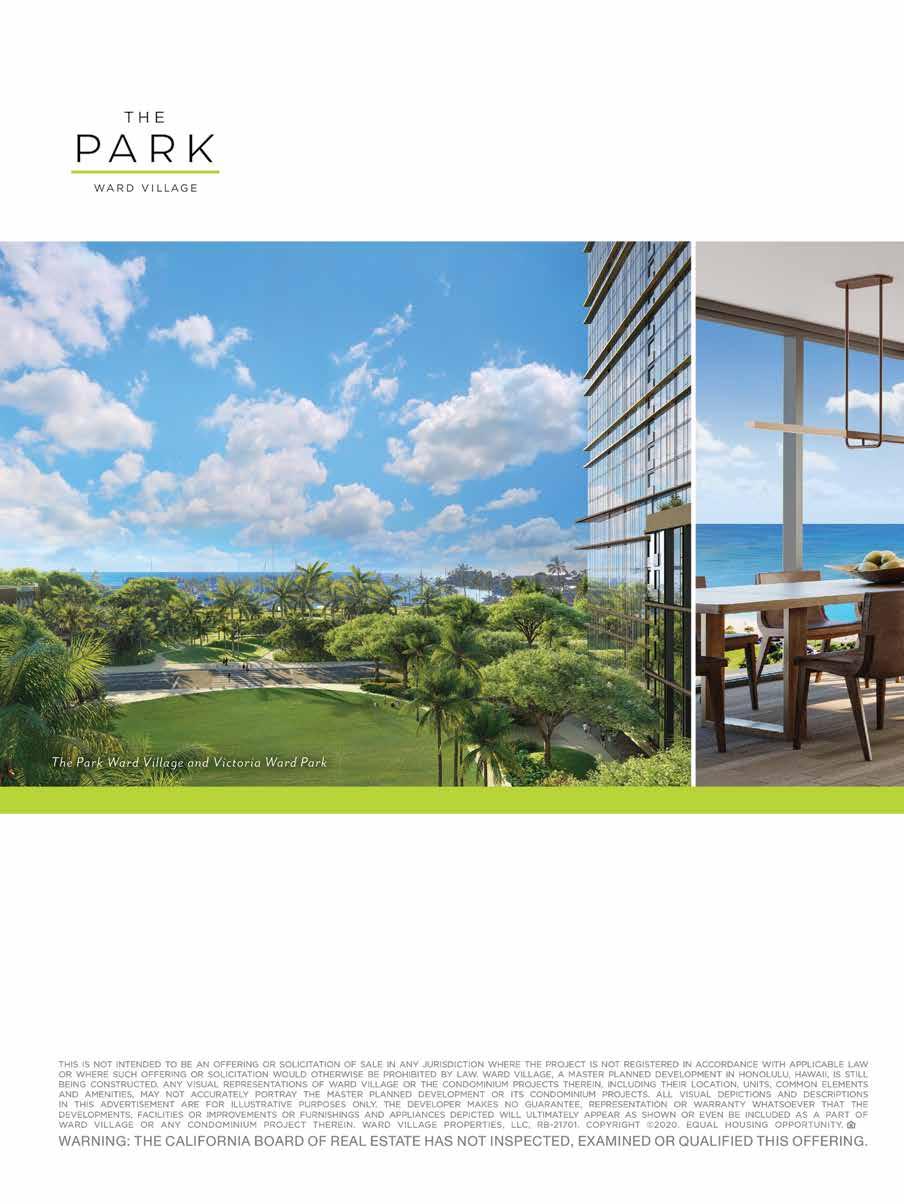
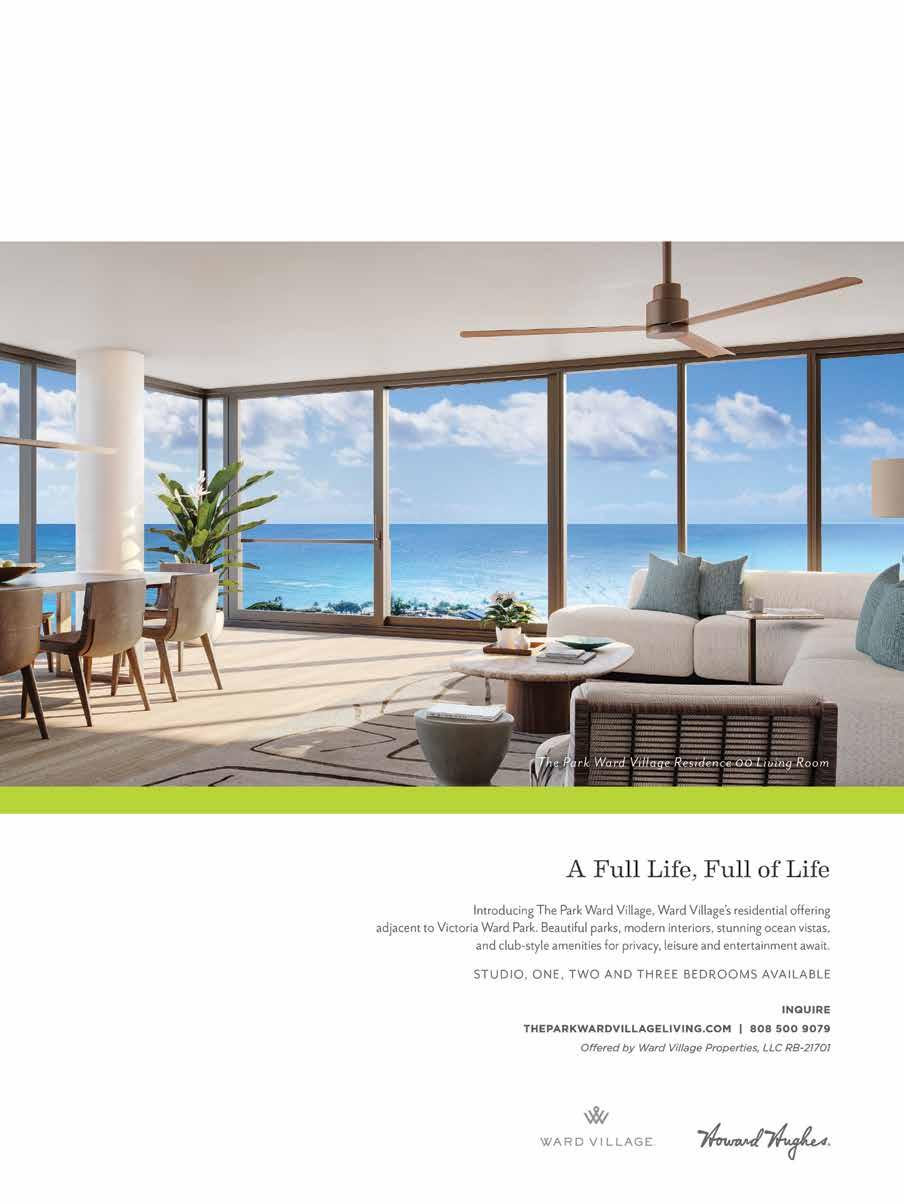
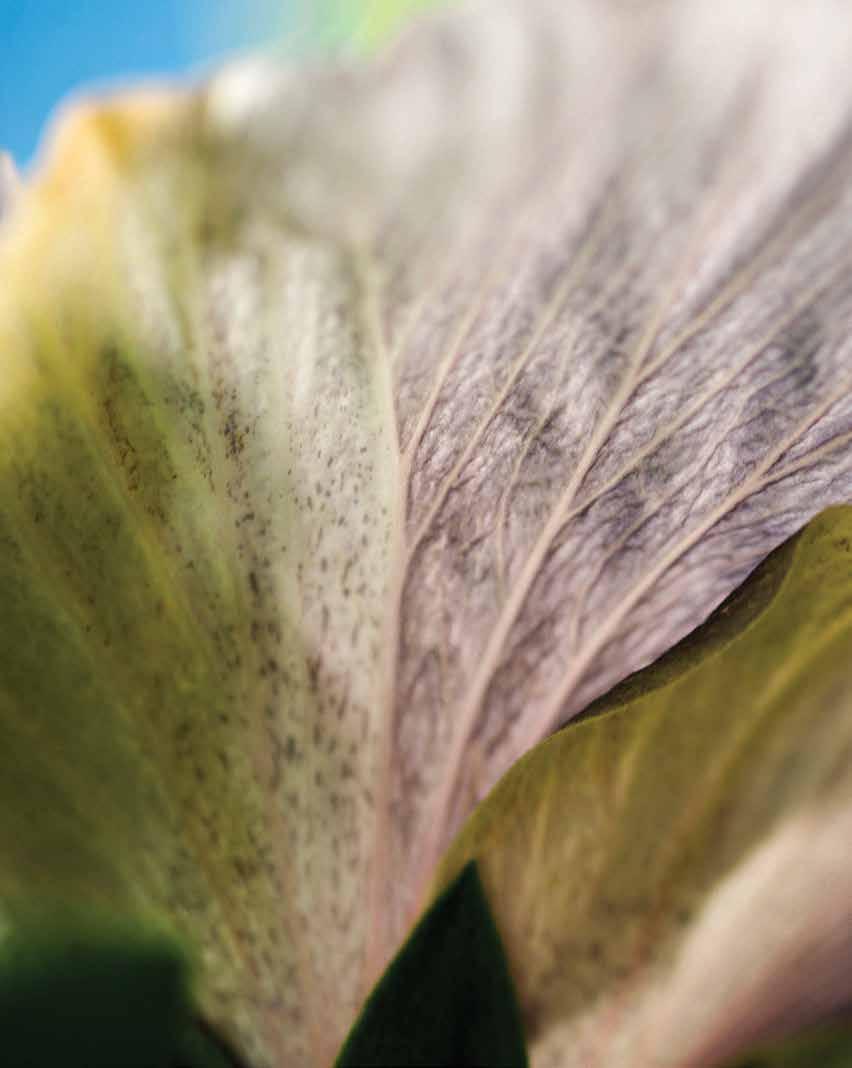

IMAGE BY
JOHN HOOK


CULTURE
TEXT BY MICHELLE BRODER VAN DYKE
IMAGES BY JOHN HOOK
文=ミシェル・ブロダ
ー・ヴァン・ダイク
写真=ジョン・フック
At the Hibiscus Lady Nursery, hibiscuses are cross-pollinated by hand to create stunning, complex hybrids.
ハイビスカスレディ植物園で は、ハイビスカスを手作業で 異花受粉させ、見事で複雑 な配合種を作っている。
HIBISCUS HYBRIDS
ハイブリッドのハイビスカス
The Hibiscus Lady creates one-of-a-kind flowers at her nursery in Mokulē‘ia.
世界に一つだけの花を作り出すモクレイアの「ハイビスカスレディ」
The hibiscus plant I got years ago from Jill Coryell, also known as the Hibiscus Lady, continued to bloom as regularly as the sun rose, despite a pandemic and the world seeming to fall apart. Staying home all the time, I watched each day as a new bud opened, revealing within its yellow petals a reddish pink and purple that blended together like a water-lily painting by Claude Monet. Coryell named the flower after the French Impressionist for this reason. Its blooms lasted for nearly 24 hours, with the colors transforming almost hourly. At no point in the day did this hibiscus look the same, but it was a masterpiece from start to finish.
Last summer, I drove to the Hibiscus Lady Nursery in Mokulē‘ia, where Coryell creates oneof-a-kind hibiscus hybrids with the help of a small all-women team of horticulturists. Amid hundreds of colorful hibiscuses, Coryell told me I am not the only customer to say her flowers have added beauty to their lives.
Before she earned her moniker, Coryell was a volunteer at Waimea Valley botanical gardens. She was asked to work with the hibiscuses and learned there are at least ten species found only in Hawai‘i, one of which was named the state flower in 1988. Inspired by the story of Princess Ka‘iulani’s father, Archibald Cleghorn, who hybridized the first hibiscuses in 1870, she started creating her own hybrid hibiscuses and was hooked. She launched her nursery in 2000 while working full time for United Airlines. “I just didn’t sleep a lot,” Coryell says.
「ハイビスカスレディ」という異名を持つジル・コリエルさんから何年 も前にもらったハイビスカスは、世界を根底から揺さぶるパンデミッ クの最中にも、昇る太陽に合わせて規則正しく咲き続けた。家にいる ことが多かったので毎日新しいつぼみが開くのを眺めることができ た。黄色い花びらの中から、赤みがかったピンクと紫が混ざり合った クロード・モネの『睡蓮』のような色合いが現れる。このハイビスカス にコリエルさんはフランスの印象派にちなんだ名前を付けた。花はほ ぼ24時間続き続け、その色は刻々と変化した。このハイビスカスは1 日を通して同じ表情を見せることがなく、最初から最後まで芸術的な 美しさだった。
去年の夏、私はモクレイアのハイビスカスレディの植物園を訪ね た。そこではコリエルさんが少数の女性たちで構成された園芸家グル ープの助けを借りて、世界に一つしかないハイブリッドのハイビスカス を栽培している。何百種類もあるカラフルなハイビスカスの中でも、彼 女の育てた花が日々の生活にとりわけ美しい彩りを与えてくれると感 じるのは私だけではないとコリエルさんはいう。
ハイビスカスレディと呼ばれるようになる以前、コリエルさんは ワイメアバレー植物園でボランティアをしていた。ハイビスカスの世話 を任され、ハワイにしかない品種が少なくとも10種はあると知った。そ のうちのひとつは1988年に州花に定められている。1870年にハイビ スカスの交配を始めたカイウラニ王女の父のアーチバルド・クレグホ ーン氏の話を聞いたコリエルさんは、独自のハイビスカス交配種を作 り始めるとすっかり夢中になった。その後、ユナイテッド航空でフルタ イムで働きながら2000年に植物園を開園した。「あの頃はほとんど寝 ていませんでした」とコリエルさんは当時を振り返る。
Halekulani Living 62
CULTURE
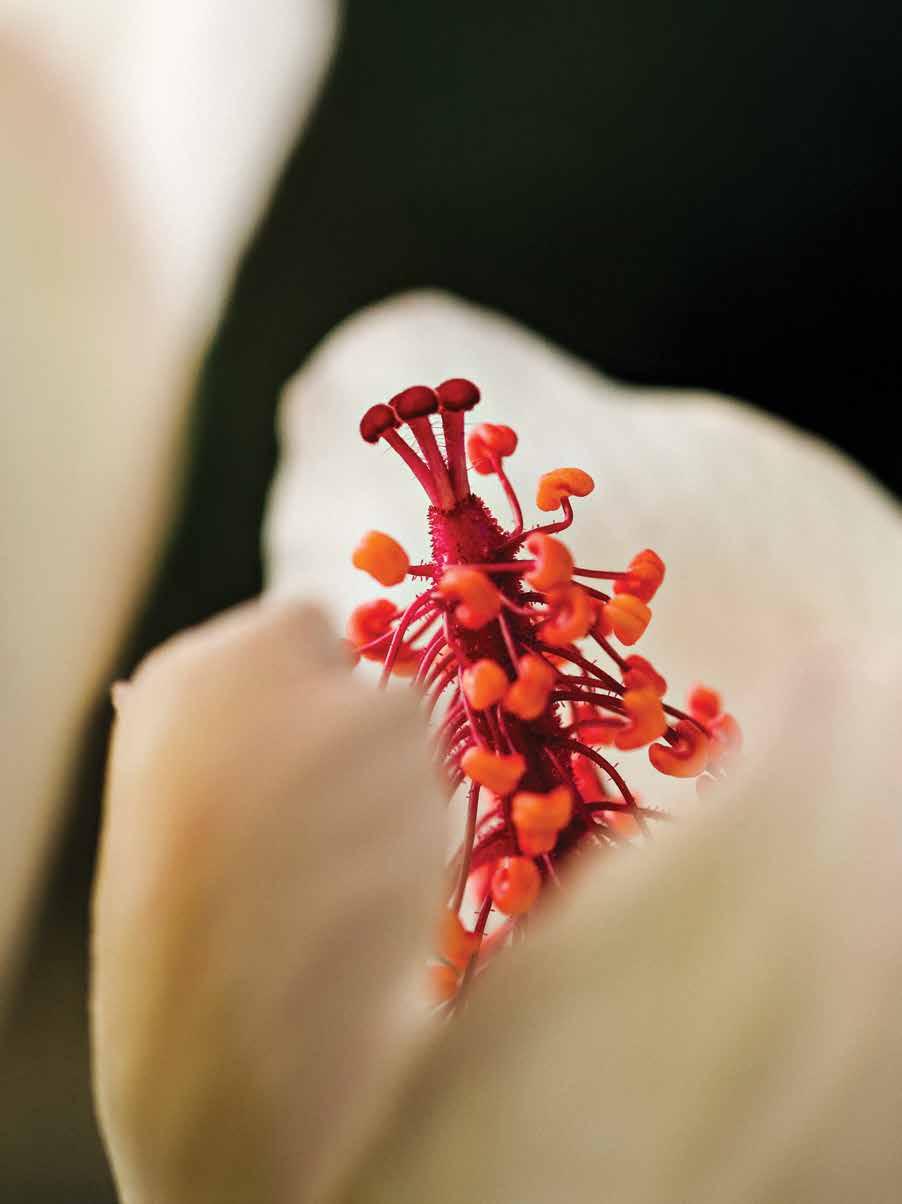





To make a new creation, Coryell considers the colors, fragrance, flower size, shape, and number of petals—usually, a hibiscus has five petals, but when they have ten or more petals, they are called “doubles.” She also notes whether the colors stay static or evolve over the course of a day. She picks two flowers she likes, dubbing them the mother and father.
“This is very complicated, which is why my 5-year-old granddaughter was able to do it,” she jokes, rubbing the pollen pads of the two flowers together. If successful, when the mother flower closes and falls off, a seed pod will be left behind. Each seed will produce a different flower—there are no duplicates—and it might not look anything like its parents. The entire process requires a great deal of patience; it takes at least a year for the first bloom to appear.
In the evenings, Coryell and her crew walk through the nursery and try to guess what the new flowers might look like in the morning, when they will be seen for the first time ever. “It’s like every day is Christmas,” Coryell says.
The Hibiscus Lady Nursery only keeps 3 percent of the new hibiscuses. The flower has to stop Coryell in her tracks and make her exclaim “Oh my goodness!” Anything less is composted. It’s also a democratic decision—her employees and family members create new hibiscus hybrids and they, too, get a say in what stays.
Each new bloom eventually receives a name. A voracious reader, Coryell keeps a running list of appealing words to pull from in addition to naming flowers after people she loves and respects. Drawing upon her knowledge of Hawaiian culture and ‘ōlelo Hawai‘i (Hawaiian language) as a former student of Hawaiian studies at the University of Hawai‘i at Mānoa, she also gives her creations Hawaiian names.
A lightly fragrant, hot pink and yellow double hibiscus is named after the late Pat Namaka Bacon, an ‘ōlelo Hawai‘i expert renowned for preserving language and culture. A bright orange double hibiscus with yellow tips, which expands from eight inches in diameter in the early morning to a foot wide by noon, is named Ho‘olaule‘a, meaning “joyous celebration.” “It certainly is a celebration,” Coryell says of the vibrant bloom. As for the delicate
交配によってハイビスカスの新品種を作るには、色、香り、花の サイズ、形、花びらの数といった花の特性を考慮するという。通常ハイ ビスカスには5枚の花びらがあり、10枚以上の花びらがある場合は「 ダブル」と呼ばれる。さらに色が同じままで咲くか、1日を通して変化す るかどうかを考える。交配させる好みの花を2つ選び、それらを “母” と“父”と呼ぶのだそうだ。
コリエルさんは2つの花のおしべとめしべをこすり合わせながら 「交配はとても複雑なのよ。だから5歳の孫娘にやってもらったわ」と 冗談を言う。受粉が成立すると、母の花は萎んで落ち、種子のさやだけ が残る。種子ごとに異なる花が生成され、一つとして同じものはできな い。親の花に全く似ていない場合もある。それは気の遠くなるようなプ ロセスで、最初の花が咲くまでに少なくとも1年はかかる。
夕方になるとコリエルさんとスタッフは植物園の中を歩き回り、 新交配種のハイビスカスが初めて開花する朝にどんな姿を見せるか 推測し合うのだという。「まるで毎日がクリスマスみたいなの」とコリエ ルさんは嬉しそうだ。
ハイビスカスレディ植物園で新たに完成したハイビスカスのう ち、実際に新種として認められるのはわずか3パーセントにしか満たな い。そのためには園内を回るコリエルさんの目に止まり、彼女が「なん て素晴らしいの!」と叫ぶほど美しくなけばならない。それ以下のもの は全て堆肥と化す。そして多数決で決まることもある。彼女のスタッフ や家族も新交配種を作っていて、どの品種を残すかについては彼らも 意見することができる。
新しい花には一つ一つに名前が付けられている。熱心な読書家 のコリエルさんは、彼女が愛し尊敬する人たちにちなんだ名前をつけ る以外にも、美しい言葉を常に書き出してリストにしている。ハワイ大 学マノア校でハワイアンスタディー学部の学生時代に得たハワイ文化 とオレロハワイ(ハワイ語)の知識を活用して、彼女が作った花にハワ イ語の名前を付けることもある。
ほのかに香るホットピンクと黄色のダブルハイビスカスは、ハワ イの言語と文化の保護で有名なハワイ語専門家の故パット・ナマカ・ ベーコン氏にちなんで命名した。花弁の端が黄色で鮮やかなオレンジ 色のダブルハイビスカスには、ハワイ語で“楽しい祝宴”を意味する「ホ オラウレア」という名がついている。早朝には直径20cmほどの大きさ の花は、正午には30cmにもなる。この色鮮やかなハイビスカスを指 し、「まさにお祝いっていう感じでしょう?」とコリエルさん。「セプテン バーモーニング」という名の繊細なピンクと白のハイビスカスについて
68 CULTURE
Living
Halekulani
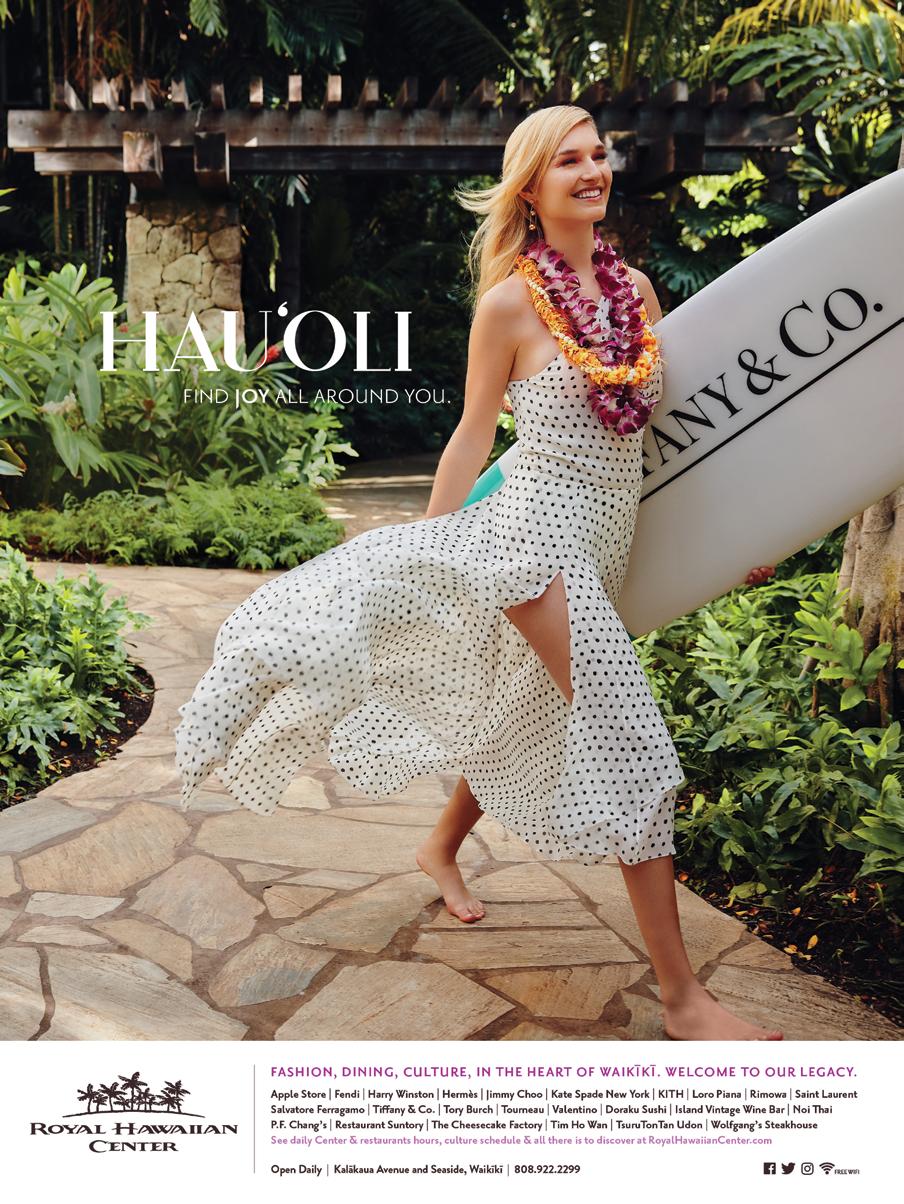


CULTURE
Jill Coryell, also known as the Hibiscus Lady, has been hybridizing hybiscuses for more than 20 years.
ハイビスカスレディとし
ても知られるジル・コリ エルさんは、20年以上
にわたってハイビスカス を交配している。

pink and white flower named September Mourning?
“That was my reaction to the horrors of September 11,” she says, having created it in honor of the flight attendants who lost their lives on that tragic day.
As a flight attendant, Coryell would regularly bring a hibiscus bud with her on her flight routes to Chicago. It would bloom in the Midwest during her layover, blossoming into a flower she could then wear in her hair on the return flight. At O’Hare Airport, people would stop her and exclaim “Hawai‘i!” No matter where she was, the hibiscus always tied her to the islands.
Even now, the Hibiscus Lady upholds the tradition of wearing her flower creations in her hair. “I like doubles for my hair—it’s just sassier,” Coryell says, referring to the frilly, double-petaled, yellow, pink, and purple hibiscus she wears behind her ear. “I can still be 74 and be sassy.”
「9月11日の米国同時多発テロの犠牲者への哀悼の意が込められて いるの」と語る彼女は、悲劇的な惨事で命を落とした客室乗務員への 敬意を表してこの花を作ったのだという。
客室乗務員として働いていたコリエルさんは、シカゴ行きのルー トには決まってハイビスカスのつぼみを持って搭乗した。花は乗り継 ぎのある中西部で咲きだし、帰りの飛行機の中で髪を飾るのにちょう どいい大きさに開花する。オヘア空港では、しばしば人々が彼女を止 めて「ハワイ!」と声を上げたという。彼女がどこにいても、ハイビスカス はいつも彼女と島を結んでいた。
ハイビスカスレディは自ら作った花を髪につける習慣を今も続 けている。「髪につけるのは派手なダブルがいいわね。このほうが色っ ぽいのよ」とフリルのきいた花びらが二重の黄色とピンクと紫のハイビ スカスを耳の後ろに挿してコリエルさんは言う。「74歳でもまだ色っぽ くいられるのよ」。
Halekulani Living 72

More Chefs. More Flavors.
Delight in globally-inspired culinary flavors at International Market Place, home to Waikiki’s largest collection of restaurants. With extraordinary eateries from award-winning chefs like Michael Mina and Roy Yamaguchi, the next chapter in your culinary journey is just around thecorner. Find the finest poke, indulge in sizzling cuts of premium steak, enjoy linecaught seafood, savor down home barbecue, pick the perfect pizza and do it all in the heart of Waikki. Bring your appetite and let your culinary story unfold.

Kala¯kaua Avenue



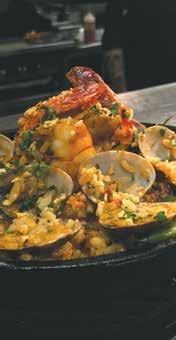

Eating HousE 1849 by Chef Roy Yamaguchi stripstEak by Chef Michael Mina
kuHio avE Food Hall
liliHa BakEry
sHorEFyrE
skyBox tapHousE
HErringBonE
Moani Waikiki
kona CoFFEE purvEyors MitsuWa

/ IntlMktPlace | /@ IntlMktPlace | /International Market Place | ShopInternationalMarketPlace.com
 TEXT BY EUNICA ESCALANTE
TEXT BY EUNICA ESCALANTE
IMAGES COURTESY OF THE HAWAI‘I STATE ARCHIVES
文=ユニカ・エスカランテ
写真=ハワイ州立公文書館
NĀ WAHINE HOLO LIO
ナ・ワヒネ・ホロ・リオ
In old Hawai‘i, spirited horsewomen known as pā‘ū riders captured the popular imagination.
その昔、ハワイの人々の心を捉えた颯爽とした女性騎手のパウライダー

75
Living CULTURE
Halekulani
Princess Lydia Lili‘uokalani Kawānanakoa rides pā‘ū style.
パウスタイルで馬に乗って いるリディア・リリウオカラ ニ・カワナナコア王女。
First came the beating of horse hooves. The cacophony of half a dozen steeds at full gallop reverberated over the thrum of newly arrived steam ships and crowds of disembarking tourists and harbor merchants hawking their wares. Then, a whirwind of color: silks in scarlet, orange, and white bedecked the riders, as if they were set ablaze in the midday sun.
The riders were congregated in downtown Honolulu for steamer day, when steam ships docked at Honolulu harbor to let off their passengers. Spectated by throngs of visitors and locals alike, their cavalcade charged through the city’s uneven avenues, racing one another at two or even three riders abreast. Their long riding skirts billowed behind them, whipping in the wind with their unbound hair and garlands of fresh lei.
At that time, horsemanship was considered the sole dominion of men. There were the American cowboys and their vaquero predecessors. There were the rodeomen, the ranch hands. In Hawai‘i, the term paniolo conjured images of commanding men atop their steeds. And yet, none of the riders racing that day were men.
They were pā‘ū riders, named after the unique riding skirts that became their trademark. They came to prominence in the 19th century, after the introduction of horses to Hawai‘i in 1803 made horseback riding the islands’ primary mode of transportation.
It wasn’t just their penchant for street races that made Hawai‘i’s female riders distinct from their European and American counterparts. They eschewed the sidesaddle, a Western method of riding meant to keep women modest, but which only succeeded in making the act more cumbersome. Instead, they rode astride. “The European style of riding sidesaddle did not appeal to the Hawaiian women, who felt this method too unstable when riding over the islands’ rough terrain,” wrote Virginia Cowan-Smith and Bonnie Domrose Stone in their 1995 book, Aloha Cowboy
With this riding style came a quandry, however. The popular dress of the day, with its full, floor-length skirts, made riding astride uncomfortable; women’s trousers weren’t socially acceptable until the late 1800s. Enter the pā‘ū skirt. Up to 25 yards of fabric were wrapped and folded to form a flowing, culottestyle garment that acted as a riding habit, fastened atop the outfit—often times a holokū—to protect it
リズミカルな蹄の音が近づいてくる。フルギャロップの6頭の馬の不協 和音が、到着したばかりの蒸気船から下船する観光客と商品を売り歩 く港の商人の人混みの間に響き渡る。すると赤、オレンジ、白のシルクを 身に纏った女性騎手たちの姿とともに、真昼の太陽の下で燃えさかる ような色の旋風が巻き起こった。
蒸気船が乗客を降ろすためにホノルル港に停泊する汽船の日、 女性騎手たちはホノルルのダウンタウンに集まっていた。たくさんの訪 問者や地元の人々の視線を浴びながら、彼女たちの騎馬隊はでこぼこ した街道を颯爽と駆け抜け、2人あるいは3人ずつ並んで互いにスピー ドを競い合った。長い乗馬用スカートは後ろで膨らみ、結んでいない髪 と新鮮なレイの花輪とともに風になびいている。
当時、馬術は男性だけのものと見なされていた。アメリカのカウボ ーイやその元となったヴァケロ、牧場の働き手だったロデオマンなどが その例だ。ハワイの“パニオロ”という言葉からも馬上から指揮する男性 のイメージが浮かぶ。にもかかわらずこの日レースをしているライダー の中に男性は一人としていなかった。
彼女たちはトレードマークになっているユニークな乗馬用スカー トにちなんで“パウライダー”と呼ばれた。1803年にハワイに馬が持ち 込まれ、乗馬が島内の主要な交通手段となって以降、パウライダーは 19世紀に最盛期を迎えた。
ハワイの女性騎手たちがヨーロッパやアメリカの騎手たちと異な ったのはストリートレースを好んだことだけではなかった。彼女たちは あえてサイドサドル(横鞍)をしなかった。控えめな女性像を保つための 西洋の乗り方は乗馬をかえって面倒なものにした。彼女たちはサイドサ ドルの代わりに跨って馬に乗った。バージニア・コワン・スミス氏とボニ ー・ドムローズ・ストーン氏は、1995年の著書『アロハ・カウボーイ』で、 「ハワイの女性ライダーたちは不安定なサイドサドルは起伏の多い島 の地形に不向きと考え、ヨーロッパ式のこの乗馬方法を好まなかった」 と書いている。
だがこの乗り方には一つ問題があった。当時人気のあったドレス は床まで届く丈の長いスカートで、馬に跨るのは乗り心地が良くなかっ たのだ。女性がズボンを履くことは1800年代後半まで社会的に受け 入れられていなかったこともあり、そこで誕生したのがパウスカートだ。 長さ23メートルにもなる生地を巻き付けて折りこんだ流れるようなキ ュロットスタイルのスカートは乗馬服として機能した。ホロクなどの正 装ドレスの上に着用すれば、乗馬中には埃や汗、雨から衣服を守り、社 交の場に到着すると脱ぐことができた。
Halekulani Living 76 CULTURE

They were called pā‘ū riders, named after the unique riding skirts that became their trademark.
彼女たちはトレードマークと なったユニークなライディン グスカートにちなんで“パウ ライダー”と呼ばれた。

from the dust, sweat, and rain while on horseback and taken off upon arrival at the social function.
At first, the pā‘ū was simple, the fabric choices modest. They were manufactured from tapa, a material made from the inner bark of paper mulberry trees, soaked in kamani oil to render it waterproof. Later, imported fabrics like cotton, calico, and gingham were favored for their sturdiness. The skirt was treated much like how we use raincoats today, a garment of pure practicality.
That changed as horses became more accessible and riding them became a form of leisurely recreation. Riding parties, groups of men and women on horseback touring through the countryside, were popularized by Hawai‘i’s monarchy. There was the Hui Holo Lio a Lili‘uokalani, led by Queen Lili‘uokalani when she was still a princess, and Prince Jonah Kuhiō Kalaniana‘ole’s beloved riding club, immortalized in mele (song). On these hours-long excursions, the pā‘ū was more than a shield protecting the outfit underneath. The pā‘ū was the outfit.
初期のパウはシンプルで、生地も質素なものだった。カジノキの樹 皮から作った布をカマニオイルに浸して防水加工したタパが使用され た。のちに綿、更紗や格子柄の綿織物といった丈夫な輸入生地が好ま れるようになった。パウスカートは、今日のレインコートと同じように実 用的な衣服として扱われていた。
馬がより身近になり、乗馬が娯楽やレクリエーションとなるにつ れてそれは変化していった。男女のグループで馬に乗って田舎を散策 する乗馬パーティーがハワイの王族によって広まった。リリウオカラニ 女王がまだ王女だった頃に結成した「フイ・ホロ・リオ・ア・リリウオカラ ニ」もその一つだ。ジョナ・クヒオ・カラニアナオレ王子がメレ(歌)に残 すほど愛した乗馬クラブでもある。何時間にもおよぶ遠出の乗馬では パウは下の衣服を保護するためのものではなく、パウ自体が衣服とな っていった。
Halekulani Living 78 CULTURE

“The girls put on all the finery they can scare up on Saturday afternoon,” wrote Mark Twain during his visit to Hawai‘i in 1866. “They fill the markets and the adjacent streets with their bright presences.”
「土曜の午後になると、女性たちはあらゆる装飾品をかき集めて身に着 ける」と1866年にハワイを訪れたマーク・トウェインは書き残している。 「彼女たちの存在で、通りや市場がパッと華やぐ」。
79
Simple fabrics gave way to the ornate. Yards of satin and silk in striking colors were folded in various styles, bustles and pleats fastened into place with kukui nuts by expert pā‘ū drapers. “That must have been such a beautiful sight to see all the different printed pā‘ū and the leis they made to show off,” says Kimo Alama, a modern-day pā‘ū draper.
By the late 1800s, the pā‘ū rider was a common sight in both town and country. For Western observers, she may have signified liberation—an eschewing of patriarchal customs, an act of revolt not unlike that of Lady Godiva. Here was a woman, untethered to a man, riding free in the streets.
In reality, Alama says, pā‘ū riders were not resisting anything. They were simply Hawai‘i women enjoying themselves. “We never had a damsel in distress in Hawai‘i,” Alama says. “Women in Hawai‘i held a lot of power—more freedom than their American or European counterparts. If a woman in old Hawai‘i wanted to put on her pā‘ū and gallop, she would just tell her husband and that would be the end of the discussion.”
But the age of the pā‘ū rider soon came to an end. At the turn of the 20th century, motorized transportation took over Hawai‘i’s roads. Horseback riding through Honolulu’s streets was outlawed to keep them clear for cars and trams. “The Pā‘ū Skirt—R.I.P.,” declared a headline in the Paradise of the Pacific.
Pā‘ū riders would have quickly become a relic of old Hawai‘i if not for the parades. In 1905, a socialite by the name of Lizzie Pauahi organized a group of 40 horsewomen to ride pā‘ū style in a floral parade. A year later, Theresa Wilcox formed a second group of riders who began exhibition riding in colorful pā‘ū attire. Soon, the pā‘ū rider was a regular fixture in local parades. Women of high society— like Princess Lydia Lili‘uokalani Kawānanakoa, a descendant of the Hawaiian monarchy—commonly rode in parades in pā‘ū.
Today, the tradition continues with annual events like the Aloha Week Parade and the Kamehameha Day Parade, with each island represented by a princess and her accompanying pages. At the head is the pā‘ū queen, the highest honor bestowed upon a pā‘ū rider. The parades are a meaningful endeavor for modern pā‘ū riders, embodying the same gravitas as Merrie Monarch does for hula dancers. Preparations
そうしてシンプルだった生地は華やかなものに変わっていった。 パウの生地を専門に扱うパウドレーパーが様々なスタイルで折った鮮 やかな色のサテンとシルクの生地のスカートに腰当てとプリーツを作っ てククイナッツで留めていく。「たくさんの種類の美しいプリントのパウ とそれに合わせて作った華やかなレイは、さぞかし美しい光景だったは ずです」と現代のパウドレーパーのキモ・アラマ氏は言う。
1800年代後半には、パウライダーは街中や田舎でも一般的に見 られるようになった。この光景を目の当たりにした西洋人たちは、家父 長制からの離脱やゴダイヴァ夫人のような抵抗行為に当たる解放運動 などと捉えたかもしれない。そこには男性に縛られず、馬に跨って自由に 通りを駆ける女性たちの姿があった。
実際のところ、パウライダーたちは何かに抵抗しているわけでは なかったという。彼女たちは純粋に人生を謳歌するハワイの女性たちで あった。「当時のハワイに苦難の乙女という概念はありませんでした。な ぜならハワイの女性たちは多くの権限を持っていてアメリカやヨーロッ パの女性たちよりも自由だったのです。昔のハワイの女性がパウとギャ ロップを身につけたければ、彼女は夫にそう言うだけでよかったのです。 議論の余地はありませんでした」と語る。
ところがパウライダーの時代はすぐに終焉を迎える。20世紀に入 るとハワイの道路には馬に代わって電動の乗り物が増え、やがて車や 路面電車が通行できるようホノルル市内の通りでの乗馬は違法とされ た。この頃の新聞「パラダイス・オブ・ザ・パシフィック」の表紙を『パウス カートよ、安らかに眠れ』という見出しが飾っている。
ハワイのパウライダーの伝統が今も廃れていない背景には、パレ ードの存在がある。1905年、リジー・パウアヒという名士が40人の女 性騎馬隊を組織し、フローラルパレードをパウスタイルで行進したのが 始まりだ。その1年後、テレサ・ウィルコックスが色とりどりのパウの衣装 を見どころとする2つ目の女性騎馬隊を結成した。まもなくしてパウライ ダーは地元パレードの名物となり、ハワイ王家の血筋を引くリディア・リ リウオカラニ・カワナナコア王女をはじめ、上流社会の女性たちがパウ 姿でパレードを行進するのが通例となった。
今日もアロハウィークパレードやカメハメハデイパレードのよう な毎年恒例のイベントでその伝統は続いている。各島を代表する王女 と側近が行進するパレードの先頭には、パウライダーに授けられる称号 でもっとも栄誉のあるパウクイーンがいる。
パレードは現代のパウライダーにとって、フラダンサーにとっての メリーモナークと同じくらい特別な意味を持つ晴れ舞台だ。その準備 には費用がかかり、期間も数か月に及ぶ。「観客がパレードで騎馬隊を
Halekulani Living 80 CULTURE


“When people see a pā‘ū unit in the parade, they don’t know how much time and resources it takes to put those two or three minutes in front of their eyes.”
— Kimo Alama, pā‘ū draper
観客がパレードで騎馬隊を目にするほんの2、3分間のために、どれだけの時間と労力が注がれているのか知る人は少ないでしょう。
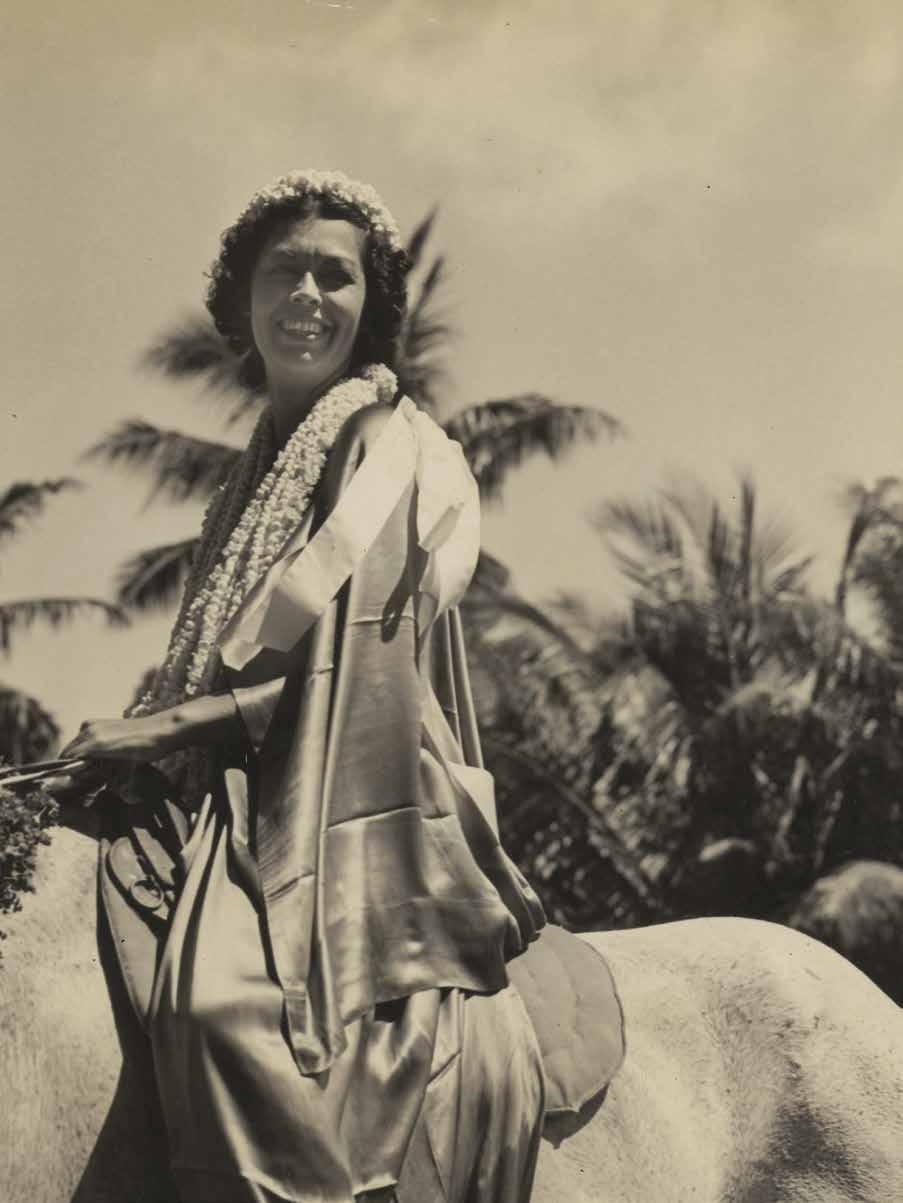
The pā‘ū rider was a regular fixture in local parades.
パウライダーは地元のパレ ードの名物であった。
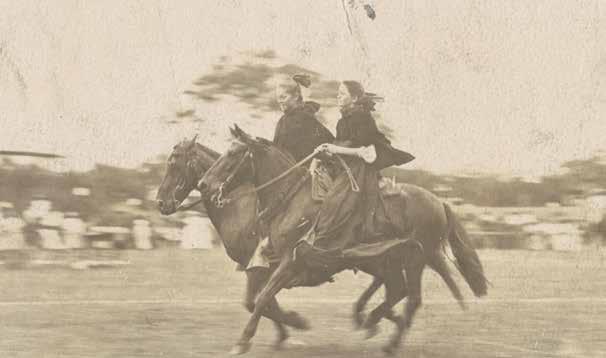
are a costly, months-long affair. “When people see a pā‘ū unit in the parade, they don't know how much time and resources it takes to put those two or three minutes in front of their eyes,” says Alama, who has for decades acted as the official pā‘ū draper for the Kamehameha Day Parade.
“I’ve trained my daughters since the age of three,” says Leiala Cook, who heads Hawai‘i Pā‘ū Riders, “just like how my mother did for me.” Pā‘ū riding is often multi-generational, with horsewomen like Cook training their daughters from a young age. In 2010, Cook became one of the youngest pā‘ū queens to ride in the King Kamehameha Day Parade. She hopes her eldest daughter, Heavenly, will one day receive the same honor. “That really makes me feel fulfilled,” she says. “It’s legacy that’s being handed down.”
From its spirited origins to the present day, pā‘ū riding is an enduring testament to Hawaiian showmanship and style. “I always tell people without pā‘ū riders, you don’t have a Hawaiian parade. You just have a parade,” Alama says. “This is what makes Hawai‘i nowhere else in the world. And that’s important to me—to keep a sense of place here in Hawai‘i.”
目にするほんの2、3分間のために、どれだけの時間と労力が注がれてい るのか知る人は少ないでしょう」と数十年にわたってカメハメハデイパ レードの公式パウドレーパーを務めるアラマ氏は言う。
「私は3歳の時から娘たちを訓練しているわ。母が私にしてくれ たのと同じようにね」と話すのは、ハワイパウライダーズを率いるレイア ラ・クックさん。パウライディングは多世代にわたることが多く、クックさ んのような騎手は幼い頃から娘たちを訓練する。2010年、クックさん はキングカメハメハデイパレードに出馬する最年少パウクイーンの1人 に選ばれた。長女のヘブンリーさんがいつか同じ栄誉を授かることを望 んでいるという彼女は、「パウライディングは私をとても満たされた気 分にしてくれるの。レガシーを受け継ぐことができるのだから」と語った。
その活力に満ちた起源から現在に至るまで、パウライディングは ハワイアン生粋のショーマンシップと独自性の象徴だ。アラマ氏はこう 語っている。「私はよくパウライダーのいないパレードは単なるパレード で、ハワイアンパレードではないと言います。それはハワイが世界で唯 一無二の存在である証です。ここハワイにしかないものを受け継いでい くこと。私にとってはそれが大切なことなのです」。
Halekulani Living 84 CULTURE
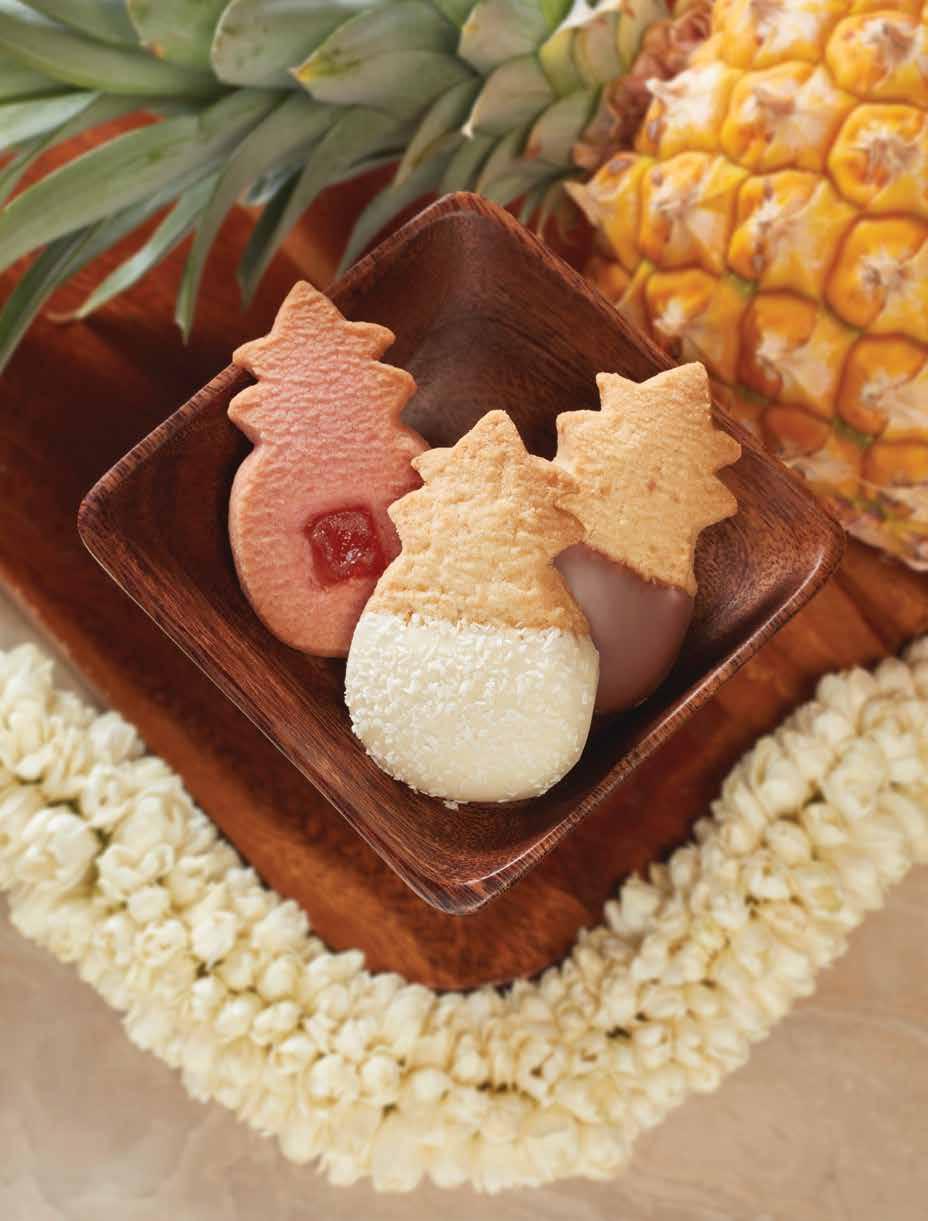
honolulucookie.com 1-866-333-5800 Sand Island Retail Store Royal Hawaiian Center Waikiki Beach Marriott Waikiki Beach Walk® Waikiki Shopping Plaza OAHU Ala Moana Center Hilton Hawaiian Village Hyatt Regency Waikiki International Market Place Outrigger Waikiki Beach Resort MAUI Front Street The Shops at Wailea LAS VEGAS The LINQ Promenade GUAM The Plaza Shopping Center

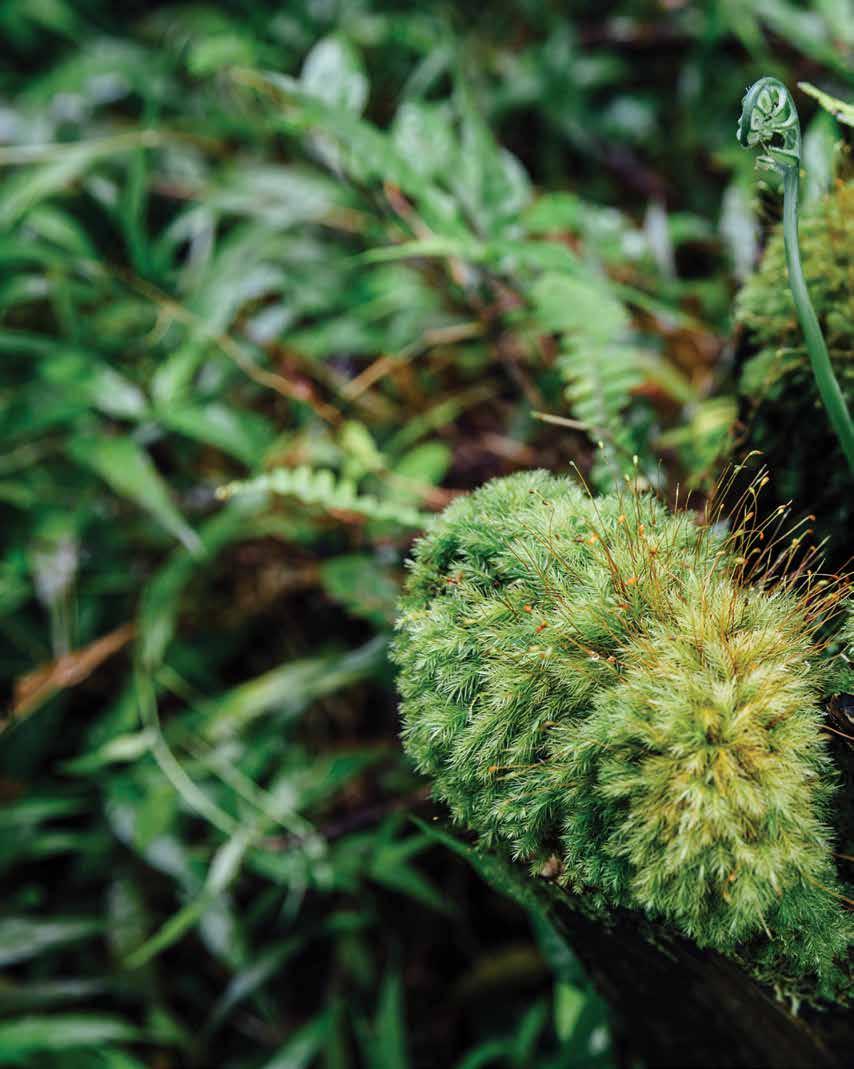
IMAGE BY MEAGAN SUZUKI
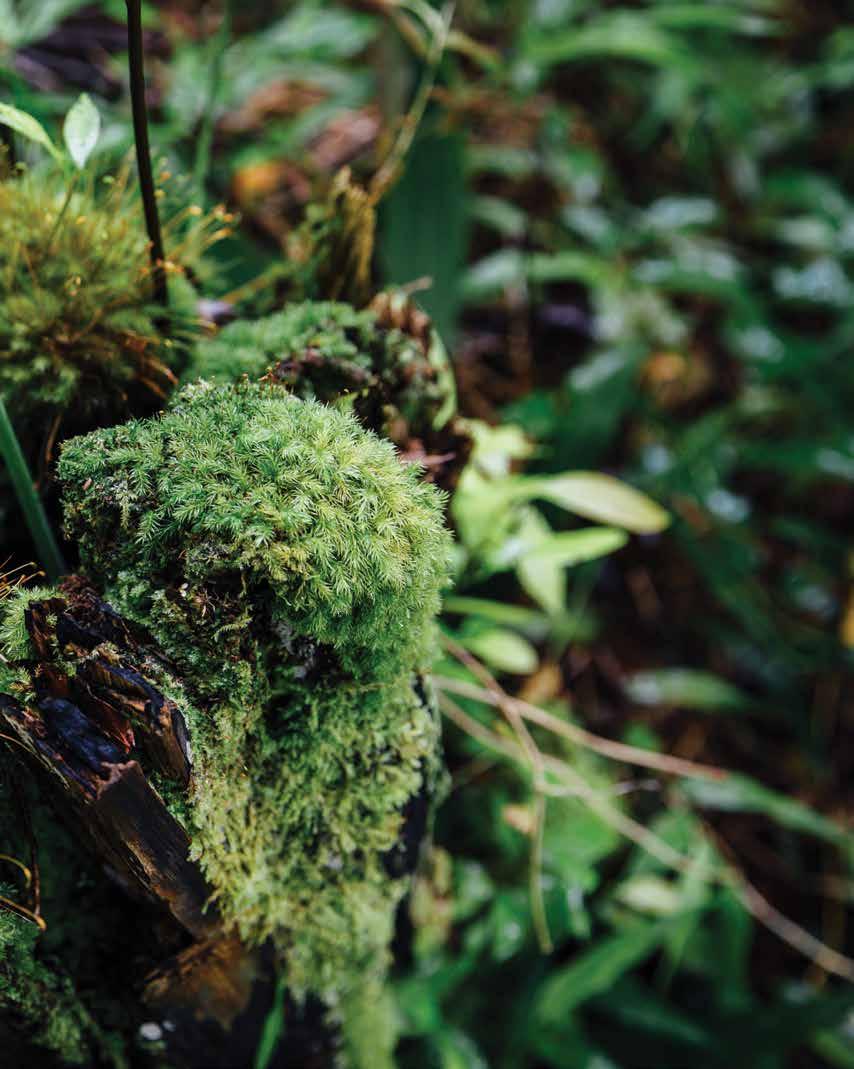
WELLNESS
TEXT BY
PETER KEALI‘I THOENE
IMAGES BY MEAGAN
SUZUKI
文=ピーター・ケアリイ・ソーン
写真=メーガン・スズキ
The state’s Nā Ala Hele trail and access program manages 77.5 miles of trails on O‘ahu.
ハワイ州のナ・アラ・ヘ レ・トレイル&アクセスプ ログラムは、オアフ島に
ある計124キロのトレイ ルを管理している。
INTO THE GREEN
大自然に飛び込もう
Nā Ala Hele is a treasure trove of intel on Hawai‘i’s many glorious hikes. Journey along a favorite of its trails in this guided tour.
ハワイの魅力あふれるハイキングコースの情報が満載のナ・アラ・へレ。このガイドツアーのお気に入りのトレイルを旅しよう。

At any given time and place in Hawai‘i, it is almost impossible not to know where the mountains and ocean are. This is especially true in Honolulu, a concrete city nestled between the looming green Ko‘olau mountain ridges and the dazzling blue, seemingly limitless Pacific Ocean.
When it’s time to relax or play, Honolulu urbanites head either mauka (inland) or makai (seaward). Those who crave the shade of a canopy such as myself often migrate to a mountainous area nicknamed Tantalus, where a web of trails offers anything from a short walk in the woods to an all-day adventure.
ハワイではいつどこにいても、辺りを見回せば山と海の方角が一目で分 かる。そそり立つコオラウ山脈の緑の尾根とどこまでも続く青くまばゆ い太平洋に挟まれたコンクリートの街、ホノルルにいればなおさらだ。
ホノルルの都会に住む人たちは、息抜きで行楽に出かけたければ マウカ(山側)もしくはマカイ(海側)へと向かう。私のように森の木陰を 好むタイプは、タンタラスと呼ばれる山岳地帯に住んでいたりする。タン タラスには森の中を気軽に散歩したり、一日中アドベンチャーを楽しむ ことのできる複数のトレイルが張り巡らされているからだ。
Halekulani Living 88
WELLNESS

Honolulu’s greenspaces are a welcome respite from the hustle and bustle of urban life.
ホノルルの緑地は、都会の喧 騒から離れることのできる憩 いの場だ。

The three pu‘u (hills) that make up the region— ‘Ōhi‘a, Kākea, and ‘Ualaka‘a—represent some of the last eruptive activity of the Ko‘olau volcano about 100,000 years ago. After hundreds of millenia of quiescence, Ko‘olau awakened and magma came bursting forth from numerous points. When the rock settled, what had been birthed were the pu‘u that form modern-day Tantalus. Other iconic features formed during this rejuvenated stage of volcanic activity in Honolulu are Le‘ahi (Diamond Head), Kohelepelepe (Koko Crater), and Hanauma Bay, to name a few.
この地域を構成する3つのプウ(丘)、オヒア、カケア、ウアラカア は、約10万年前のコオラウ火山の最後の噴火活動によって形成され た。何百年も休止状態だったコオラウが目覚め、マグマがあちこちから 吹き出した。その噴火岩が固まってできたのが今日のタンタラスを形成 しているプウだ。このホノルルの火山活動の活発化で形成された象徴 的な地形に、レアヒ(ダイヤモンドヘッド)、コヘレペレペ(ココクレータ ー)、ハナウマ湾などがある。
Halekulani Living 90 WELLNESS

Such explosive origins laid fertile groundwork. Around 1,000 CE, the most competent seafaring society the world has ever seen discovered the islands and found them teeming with flora and fauna. They settled and farmed crops like ‘uala (sweet potato) on top of Pu‘u ‘Ualaka‘a and kalo (taro) in Mānoa Valley. Eventually European explorers found Hawai‘i. Livestock was introduced, and without fences, ungulates roamed freely through the forests. In these forests, the prized native ‘iliahi (sandalwood) was logged for trade. By 1870, the once forested pu‘u were barren. Water wells dried up and streams filled with dirt runoff. The wisdom of the Native Hawaiians, “Hahai no ka ua i ka ulu la‘au” (Rain always follows the forest), seemed to have fallen to the wayside. In response to the water crisis, Hawai‘i’s government passed legislation between 1876 and 1880 codifying the protection of the forests from further development. A massive reforestation effort began.
In 1988, the state of Hawai‘i created Nā Ala Hele, a trail and access program, in response to concern about loss of access to trails winding through the forests and threats to trails from development. Today, the program manages 77.5 miles of trails on O‘ahu. Nā Ala Hele trails are well documented and legal, which means you don’t have to scour blogs or worry about getting ticketed to enjoy an afternoon hike.
One Nā Ala Hele trail I turn to often is Mānoa Cliff Trail. When I want a forest adventure, it’s simple enough to park on the shoulder of the road next to the trailhead, and within 15 minutes of hiking, I am peeking off the edge of the steep trailside into the quiet neighborhood streets of Mānoa Valley.
At first, on this hike, I see mostly plants that were introduced to O‘ahu to save the watersheds. At the peak of reforestation efforts in the 1930s, nearly two million trees were planted annually. Unfortunately, the trees chosen were fast growing non-natives such as the albizia and varieties of ficus, resulting in sparse forests containing fewer species. Then I arrive at a gate designed to protect native plants from invasive feral pigs. Stepping through, I notice a dramatic change in vegetation. The forest beyond is a multi-layered, species-rich habitat. A group of dedicated volunteers has been working since 2006 to remove alien species and plant natives. Hiking here, I can imagine being one of the first humans to step foot on O‘ahu.
これらの噴火は、大地を肥沃にしてくれた。西暦1,000年頃、世 界一優れた航海術を持つ海洋民族がハワイ諸島に到達し、動植物に溢 れていることを発見した。彼らは島に定住し、プウ・ウアラカアの頂上で はウアラ(サツマイモ)や、マノア渓谷ではカロ(タロイモ)といった作物 を栽培した。やがてヨーロッパの探検家たちがハワイを発見し、家畜が 持ち込まれ、それらの動物が柵なしで森の中を自由に歩き回るようにな った。森林では、値打ちの高いハワイ固有のイリアヒ(ビャクダン)が輸 出のために伐採され、1870年までにはかつて森林に覆われていたプウ は不毛の地と化していった。井戸は乾き、小川には泥水が流れた。「ハハ イ ノ カ ウア イ カ ウル ラアウ」(雨は常に森に続く)というハワイ先住 民の知恵は忘れ去られてしまったかのようだった。やがて島が水危機に 陥いると、その対策としてハワイ政府は1876年から1880年にかけて さらなる開発から森林を守る法律を可決した。これが大規模な植林活 動のきっかけとなる。
1988年にハワイ州は、森林の中を曲がりくねるトレイルへのアク セスを確保し、開発による森林破壊から守るためにトレイル&アクセス プログラム「ナ・アラ・ヘレ」を立ち上げた。今日、このプログラムはオア フ島内の計125キロにおよぶトレイルを管理している。ナ・アラ・ヘレの トレイルはきちんと解説がされていて、アクセスも合法なので安心だ。 午後のハイキングを楽しむのにブログを検索する必要も罰金を課され る心配もない。
私がよく行くナ・アラ・ヘレのトレイルのひとつに、マノア・クリフ・ トレイルがある。森の中でアドベンチャー気分を味わいたいときにもっ てこいだ。トレイル入口のある道路の路肩に駐車できるのでアクセスも 便利で、歩き出してから15分以内に、トレイル脇の切り立った崖からマ ノア渓谷の静かな街並みを垣間見ることができる。
このハイキングコースの最初の部分で目にする植物は、分水界を 守るためにオアフ島に持ち込まれたものがほとんどだ。1930年代の植 林活動のピーク時には、年間200万本近くの木が植えられた。残念なこ とにこのとき選ばれた樹木はネムノキやイチジク科といった成長の早 い非在来種であったため、多様性に乏しく木々がまばらな森になってし まった。さらに森の奥へ進むと、侵略的外来種の野生ブタから在来植物 を保護するために建てられたゲートにたどり着く。中に足を踏み入れる と、植生の劇的な変化に気づかされる。その先の森には、多層で多様な 種類の植物が茂る豊かな生息地が広がっている。献身的なボランティ アグループが2006年以降、外来種を除去し、固有植物の植樹に取り組 んでいるのだ。ここでハイキングしているとオアフ島に最初に足を踏み 入れた人類の気分すら想像することができる。
Halekulani Living 92 WELLNESS




DISCOVER HAWAI‘I’S MUSEUM OPEN DAILY 9 am–5 pm Closed Thanksgiving & Christmas Day LIVING CULTURE | NATURAL SCIENCE | IMMERSIVE PROGRAMS 1525 Bernice Street, Honolulu, Hawai‘i 96817 | bishopmuseum.org | 808.847.3511
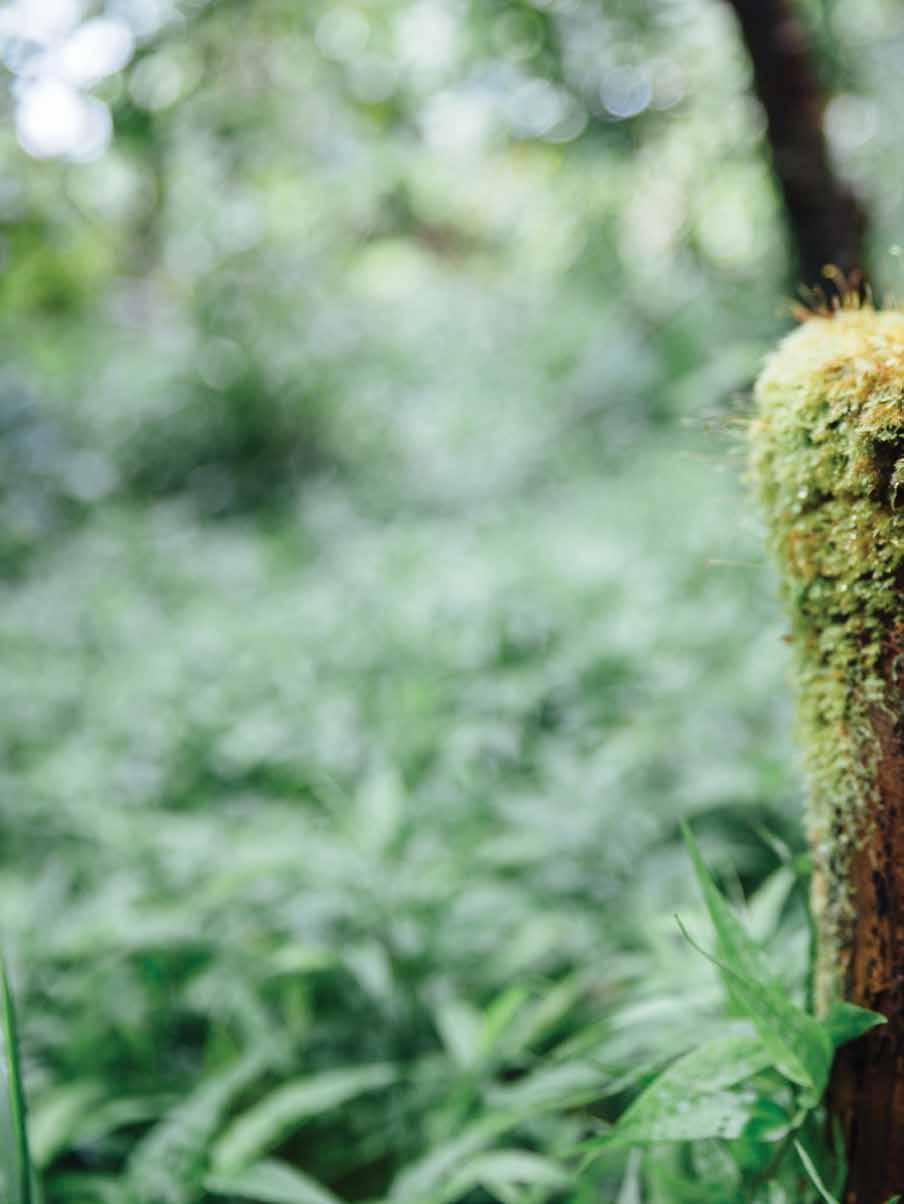

In 2005, volunteers secured a permit through Nā Ala Hele to restore native plant growth on a six-acre section of the Mānoa Cliff Trail.
2005年、ボランティアは ナ・アラ・ヘレを通じて、マノ アクリフトレイルの6エーカ ーの区画で在来植物の栽 培と保護を行う許可を取 得した。
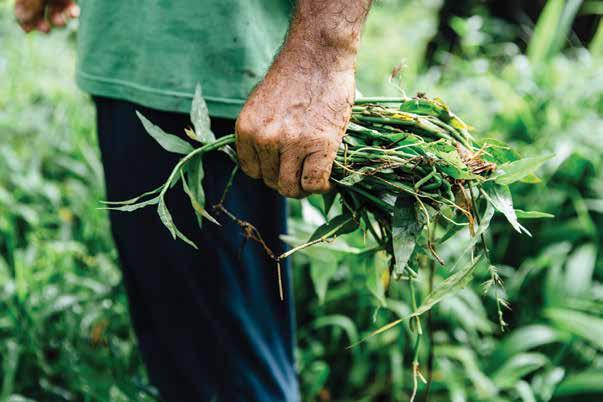
The trail splits in the middle of the restoration area, and I take the upper Pu‘u ‘Ōhi‘a trail. Heading out of the gated native habitat, I enter a bamboo thicket. After a short climb, I find myself on the top of Pu‘u ‘Ōhi‘a, next to a modern cell phone tower that now adorns the peak and makes it hard to imagine fountains of lava shooting skyward. Continuing along the Pu‘u ‘Ōhi‘a trail, I descend for a time before arriving back at the road I parked on.
The transition back to the human landscape can be jarring. City life can take a toll on my psyche, and I feel lucky that Honolulu has greenspace to escape to. These forests were exploited, replanted, and then protected again. Today, beyond being a mechanism to recharge the islands’ aquifers, forests are spaces to connect with what the Native Hawaiian people continue to recognize: Forests are divine. They are wao akua, the realm of the gods. We dive into the forest to feel what it means to be a human on this planet.
トレイルは修復エリアの真ん中で分かれていて、そこから上に向 かうプウ・オヒア・トレイルを進む。ゲートで囲われた在来種の生息地を 出て竹の茂みに入り、少し登るとプウ・オヒアの頂に出る。その横の山頂 には電波塔がそびえ、この場所にかつて溶岩が噴き上げていたとは想 像し難い。プウ・オヒア・トレイルをそのまま歩き続け、下り坂を降りると 車を駐めた道路に戻る。
人工的な光景に戻ると違和感を覚える。都会での生活にはスト レスがつきものだ。ホノルルは現実逃避できる緑地に恵まれている。伐 採され、植樹され、保護されてきた森林。今日、ハワイの森林は島の帯水 層をリチャージするメカニズムである以上に、「森林は神聖なものであ る」というネイティブハワイアンの人々が今も抱く畏敬の念に触れられ る場所でもある。それは“ワオ・アクア”と呼ばれる神々の領域だ。この惑 星に住む人間であることの意味を感じるため、私たちは今日も森に飛 び込んでいく。
Halekulani Living 96 WELLNESS
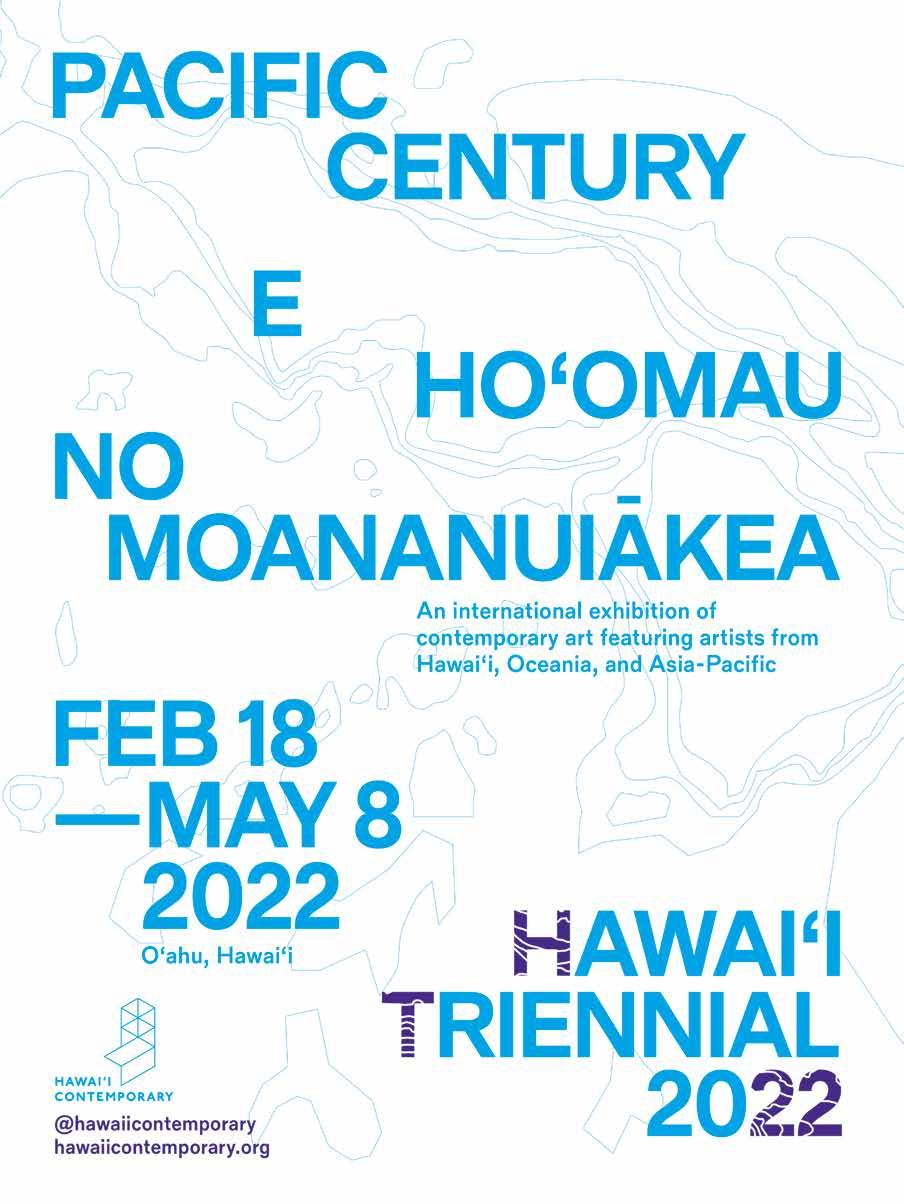
IMAGES BY MARK
KUSHIMI
STYLED BY
ARA LAYLO
HAIR + MAKEUP BY TAMIKO HOBIN
MODELED BY KONRAD NG
写真=マーク・クシミ
ヘア&メイク= タミコ・ホビン
モデル=コンラッド・イング

SANCTUARY BY THE SEA
Soft linens and muted layers conjure travels through North Africa, the Middle East, and South Asia, where philanthropist Doris Duke sourced the eclectic collections on view at Shangri La Museum of Islamic Art, Culture, and Design. 海辺の聖域
柔らかいリネンと落ち着いた装飾品が北アフリカや中東、南アジアの旅を彷彿と させる。慈善家のドリス・デューク氏は、これらのエリアからシャングリラ回教美 術館に展示されているコレクションを調達した。
98 FASHION
スタイリング=アラ・レイロー

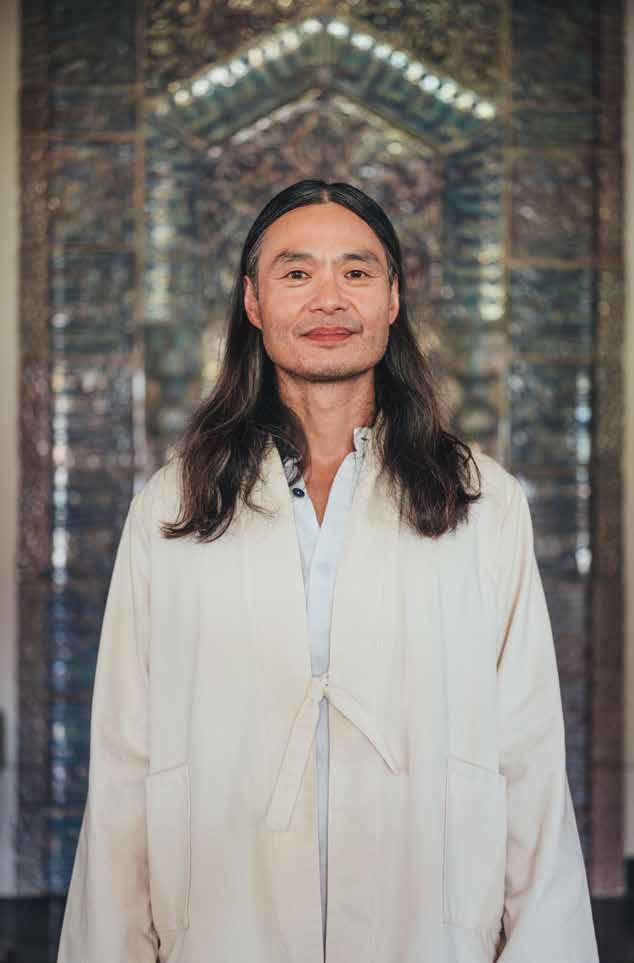 CYC big shirt dress from Bās Bookshop. Matt Bruening Kennedy jacket.
CYC big shirt dress from Bās Bookshop. Matt Bruening Kennedy jacket.

 Maile aloha shirt in Sage and Joey Trisolini jacket, both from Salvage Public.
Maile aloha shirt in Sage and Joey Trisolini jacket, both from Salvage Public.

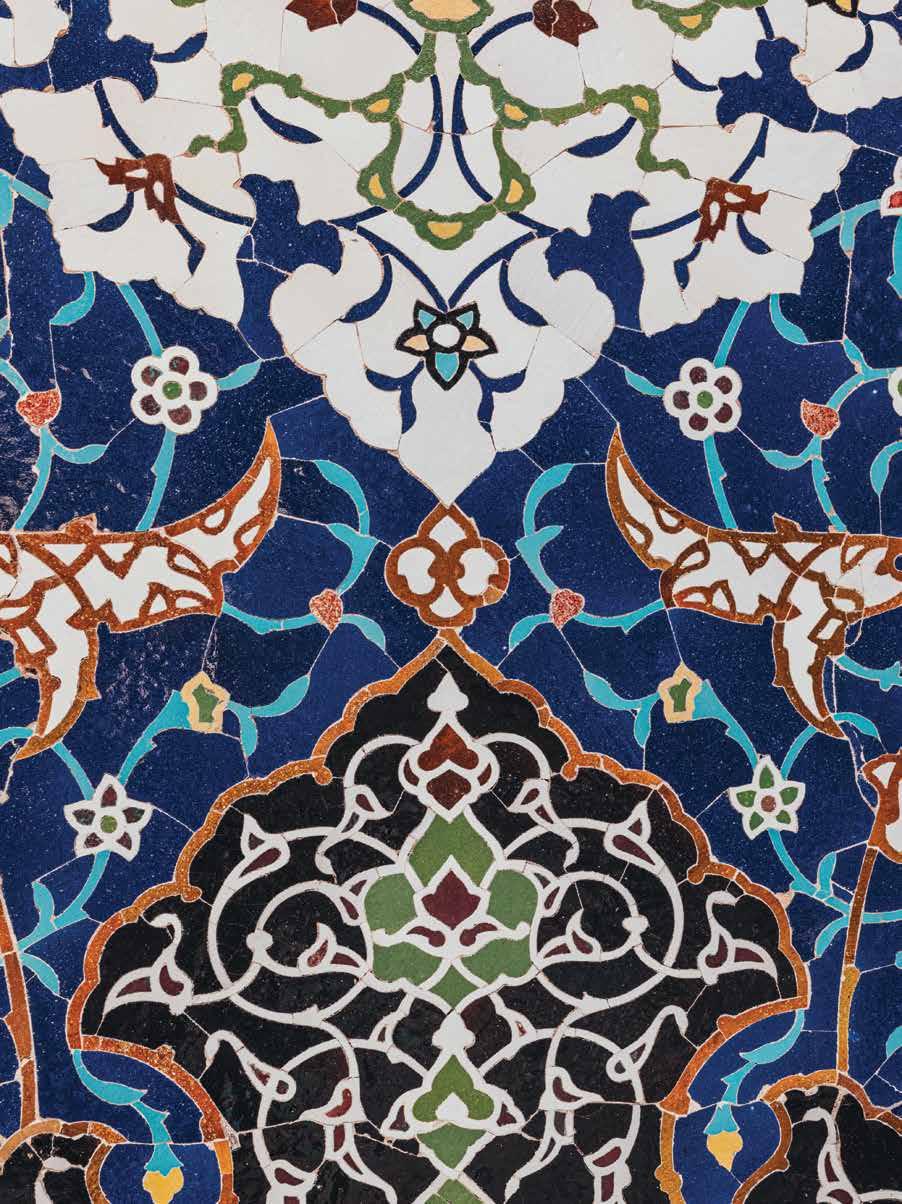

’
Purple woven jacket from Brunello Cucinelli. Moss tee and trouser in Moody, both from TOQA. Tiffany HardWear link necklace in 18K gold from Tiffany & Co.

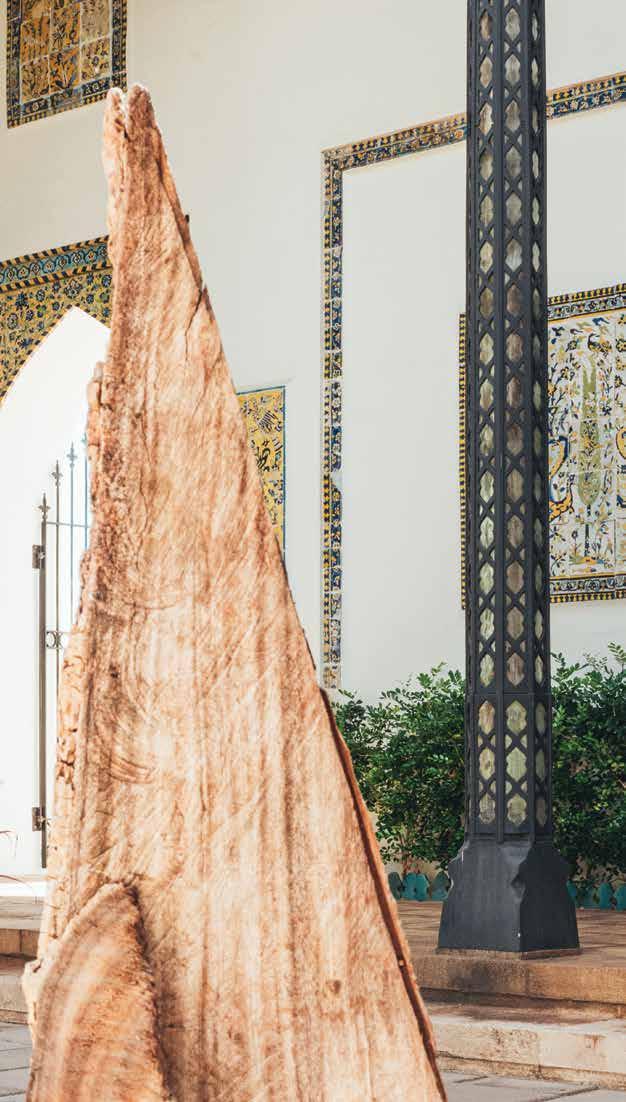
107
CYC big shirt dress, layered top, and pleat maroon silk slice full pant from Bās Bookshop. Tiffany HardWear link necklace in 18K gold from Tiffany & Co.



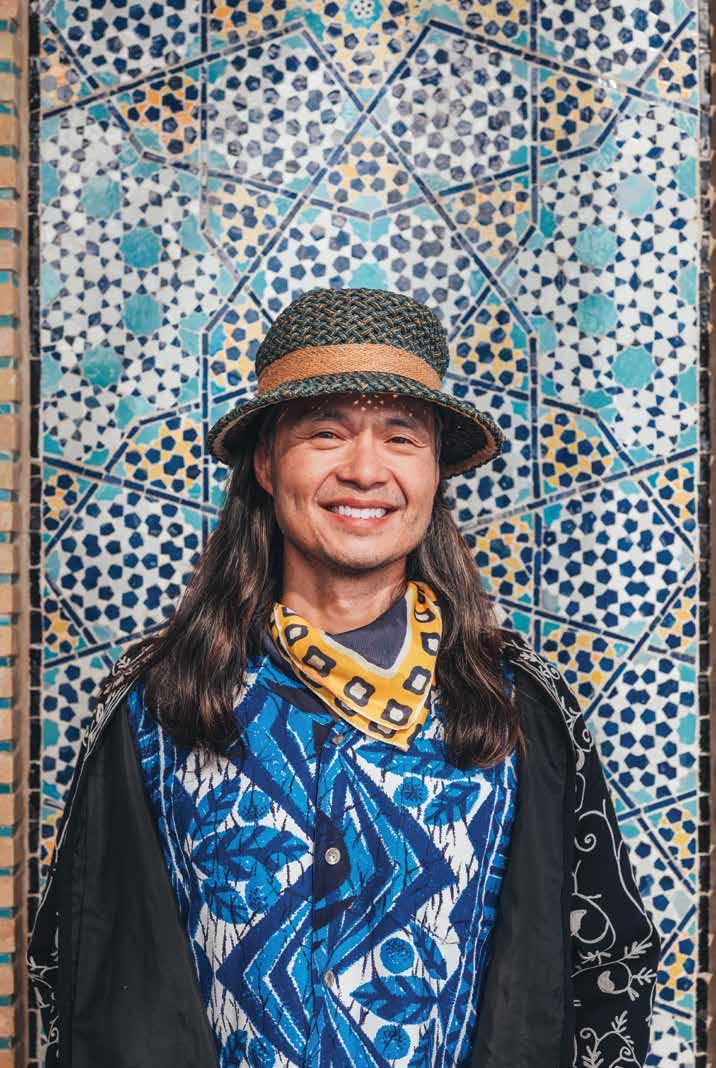 Hat, bandana, shirt, and jacket from Single Double.
Hat, bandana, shirt, and jacket from Single Double.
 Hat from Single Double. CYC x KarloBuenobello jacquard vest and CYC pleated shirt dress from Bās Bookshop.
Hat from Single Double. CYC x KarloBuenobello jacquard vest and CYC pleated shirt dress from Bās Bookshop.
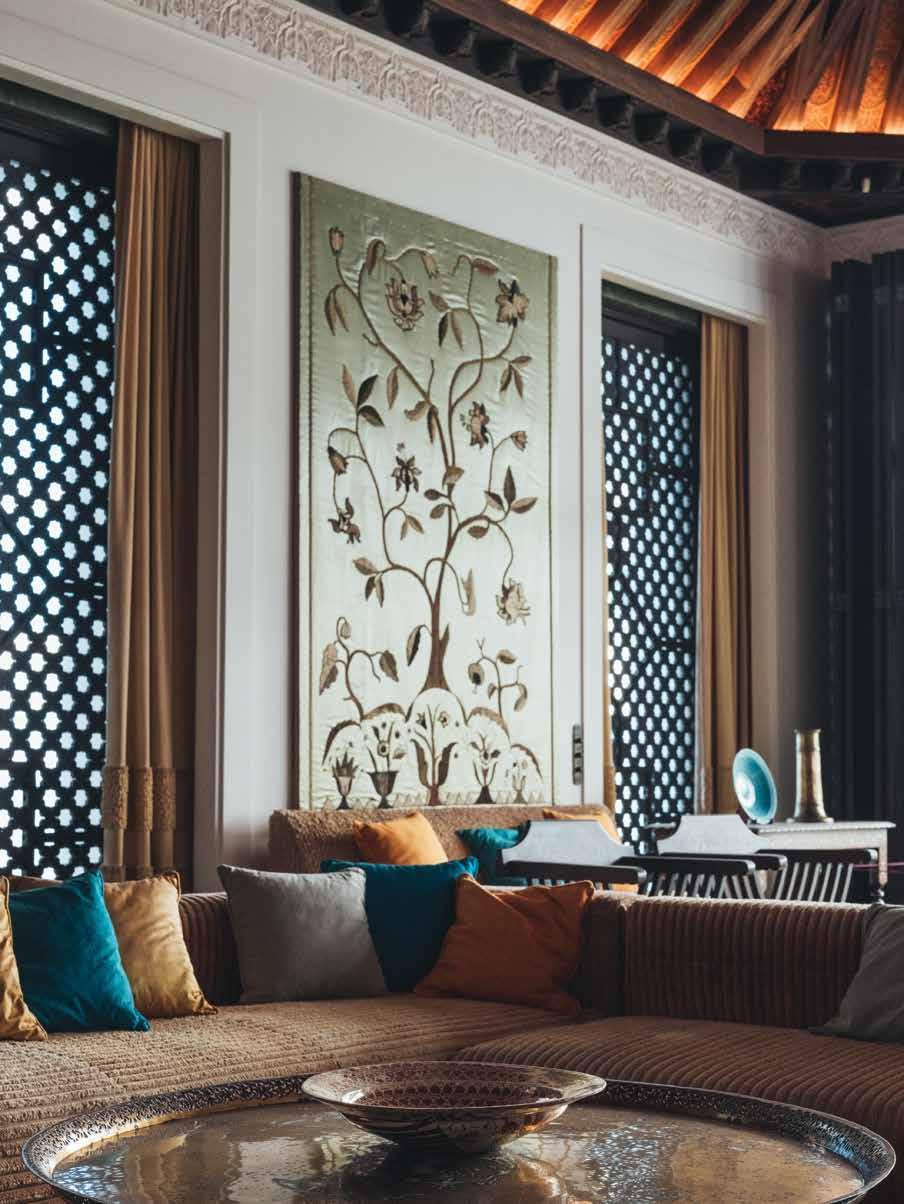
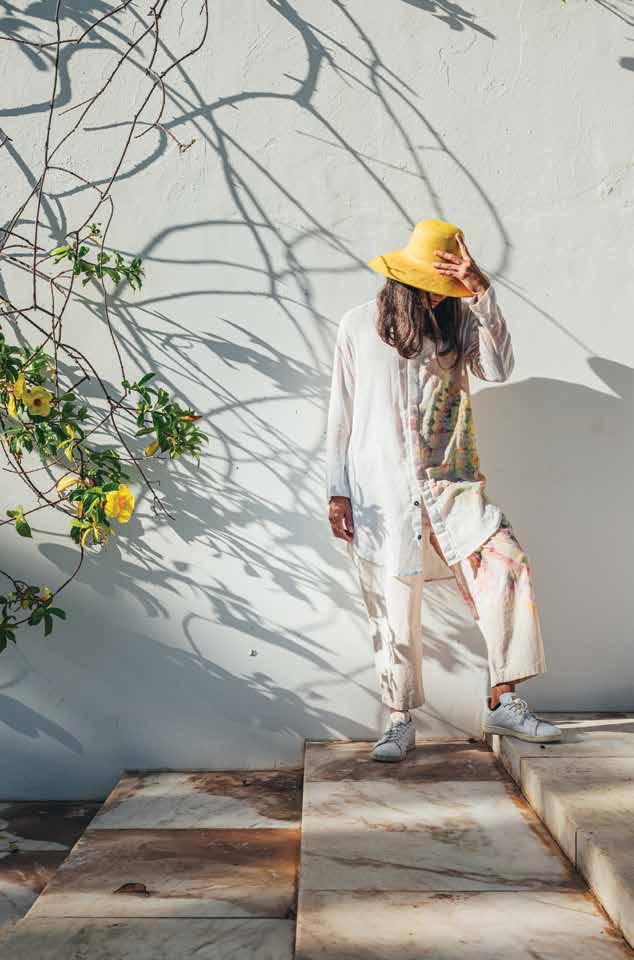 CYC kaleidoscope dye khadi pants and dress shirt from Bās Bookshop. Hat from Single Double.
CYC kaleidoscope dye khadi pants and dress shirt from Bās Bookshop. Hat from Single Double.



IMAGE BY
CHRISTIAN NAVARRO
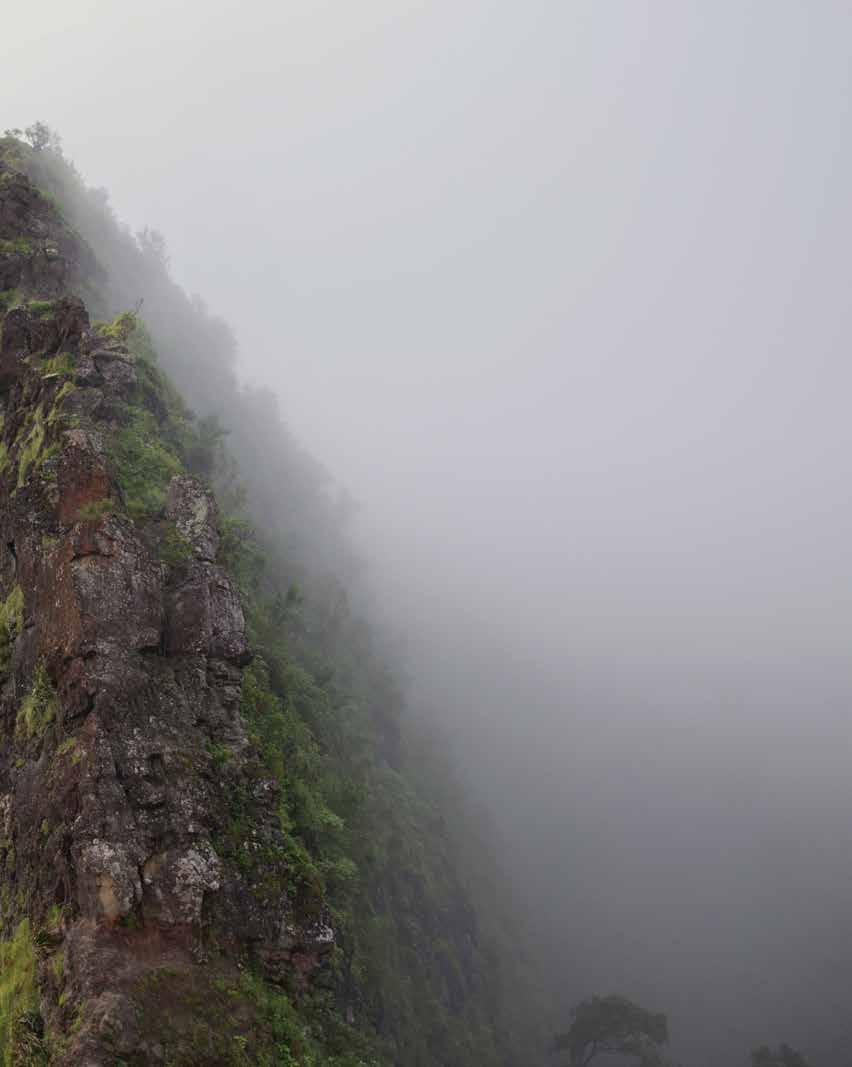
CITY GUIDES
LOVING LYRICS
MORNING CATCH
ALA MOANA CENTER
 TEXT
TEXT
BY
CHRISTINE HITT
IMAGES BY CHRISTIAN
NAVARRO
文=クリスティン・ヒット
写真=クリスチャン・ナヴァロ
LOVING LYRICS
愛しの歌
Enrich your understanding of famed places around O‘ahu through Queen Lili‘uokalani’s original songs.
リリウオカラニ女王が作曲した歌を通して学ぶオアフ島の名所
A prolific composer, the last monarch of the Kingdom of Hawai‘i penned more than 160 songs and chants that are still celebrated today.
ハワイ王国の最後の君主であっ た多作な作曲家は、今も歌われ ている160以上の曲とチャント を残している。
Queen Lili‘uokalani, the last ruling monarch of the Kingdom of Hawai‘i, reigned from 1891 to 1893. She was a talented songwriter who wrote more than 160 songs and chants during her lifetime. Her songs were inspired by important places she lived or visited; in them she reflected on the natural beauty of her surroundings. They also speak often of love, and greatly portray her appreciation to the land.
ハワイ王国最後の君主のリリウオカラニ女王は、1891年から1893年 までハワイを統治していた。才能ある作詞家であった女王は、生涯を通 じて160曲以上の歌とチャントを残している。その多くが住んだ場所や 心に残った訪問先について書かれた歌で、彼女を取り巻く自然の美し さを賛美している。愛について語るものや、ハワイという土地への感謝 が込められた歌もある。
118
CITY GUIDES
Halekulani Living
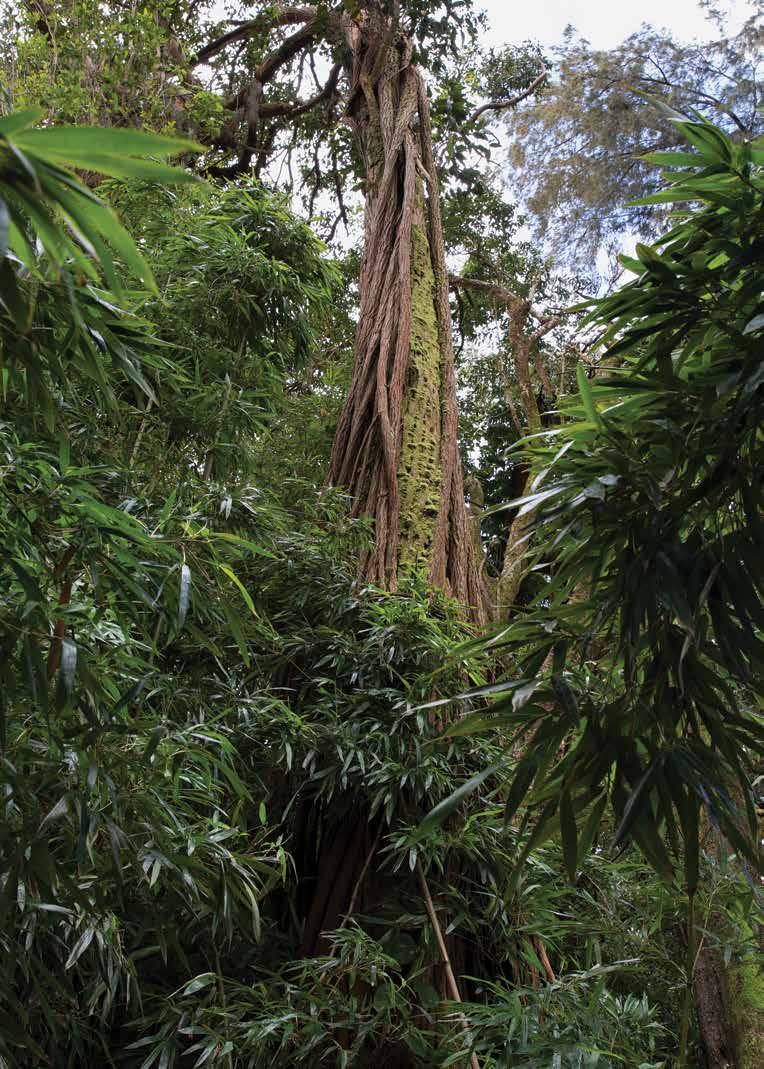
119
Queen Lili‘uokalani’s songs were inspired by important places she lived or visited and reflect on the natural beauty of her surroundings.
リリウオカラニ女王の歌は、彼 女が住んだ場所や心に残った 訪問先、彼女を取り巻く自然の 美しさを賛美している。
paoakalani, waikīkī
During her eight-month imprisonment at ‘Iolani Palace, Lili‘uokalani penned “Ku‘u Pua I Paoakalani,” an ode to her principal estate, Paoakalani, in Waikīkī. It was built on her lands in the district of Hamohamo, which ran inland from Kalākaua Avenue to what is now the Ala Wai Canal. (On a present-day map, that’s approximately between Lili‘uokalani and ‘Ōhua Avenues, near Paoakalani Street.)
“Hamohamo is justly considered to be the most lifegiving and healthy district in the whole extent of the island of O‘ahu,” she wrote in her memoir, Hawai‘i’s Story By Hawai‘i’s Queen. “There is something unexplainable and peculiar in the atmosphere of that place, which seldom fails to bring back the glow of health to the patient, no matter what disease suffering.”
Lili‘uokalani had much affection for her land at Hamohamo, which is forever etched in her song: “‘Ike mau i ka nani o nā pua, O ka uka o Uluhaimalama, ‘a‘ole na‘e ho‘i e like, me ku‘u pua i ka la‘i o Paoakalani.” (“I’ve often seen those beauteous flowers that grew at Uluhaimalama, but none of those could be compared to my flowers that blooms in the fields of Paoakalani.”)
ko‘olau
“Nani Nā Pua Ko‘olau” is a love song composed by Lili‘uokalani in 1860 at the age of 22. The romantic song, which she published in both Hawaiian and English, describes the beautiful flowers of Ko‘olau and the search for the “fairest of all fair ones”—the ‘ōhi‘a lehua. “The lehua flower whose ardent sweetness, overpowers the wanderer over the lea, and I cry ‘Where are you, my loved one,’ my spirit wants to be with you,” the song yearns.
Lili‘uokalani’s life at the time included suitors from William Lunalilo to John Dominis, whose proposal she accepted the same year she wrote the song. (She married Dominis two years later.) This tribute to nature and the desire to find a lehua blossom mirrors the longing between two lovers, and the bliss felt when reunited.
パオアカラニ、ワイキキ
リリウオカラニはイオラニ宮殿での8か月におよぶ幽閉中、ワイキキに ある邸宅のパオアカラニの美しさを讃える『クウ・プア・イ・パオアカラ ニ』を作曲した。この邸宅は、女王の所有地であったカラカウア通りか ら現在のアラワイ運河までの内陸部のハモハモ地区に建っていた。(現 在の地図上ではリリウオカラニ通りとオフア通りの間のパオアカラニ通 り近くにあたる)
女王の回想録『ハワイの女王によるハワイの物語』には、「当然の ことながら、ハモハモはオアフ島全体で一番の活気と健やかさに満ちた 土地と考えられている。何とも言えない独特の雰囲気のこの場所には、 いかなる病を患った患者をも輝きを取り戻し健康にさせる力が宿って いる」と綴られている。
リリウオカラニはハモハモの土地を心から愛していた。その思い は「ʻIke mau i ka nani o nā pua, O ka uka o Uluhaimalama, ʻaʻole naʻe hoʻi e like, me kuʻu pua i ka laʻi o Paoakalani」(ウ ルハイマラマで育った美しい花をよく見かけるけれど、パオアカラニの 畑に咲く私の花とは比べものにならない)という彼女の歌に永遠に刻 まれている。
コオラウ
『ナニ・ナ・プア・コオラウ』は、1860年に22歳のリリウオカラニが作曲 したラブソングだ。ハワイ語と英語の両方で書かれたロマンチックな曲 は、コオラウの美しい花と“全ての美しい花の中で最も美しい”オヒアレ フアの花を探す歌だ。「草原をさまよう者がその甘い香りに酔いしれる レフアの花、そして私は叫ぶ。あなたはどこにいるの。私の愛する人。私 の心があなたを求めているの」。
当時のリリウオカラニは、ウィリアム・ルナリロやジョン・ドミニス から求婚されていた。彼女はこの曲を書いた年にジョン・ドミニスのプ ロポーズを受け入れ、二人は2年後に結婚した。恋人同士の互いを切望 する思いと再会時の喜びを、自然への賛美とレフアの花が見つかるよう にという願いに重ねている。
120 CITY GUIDES Halekulani Living
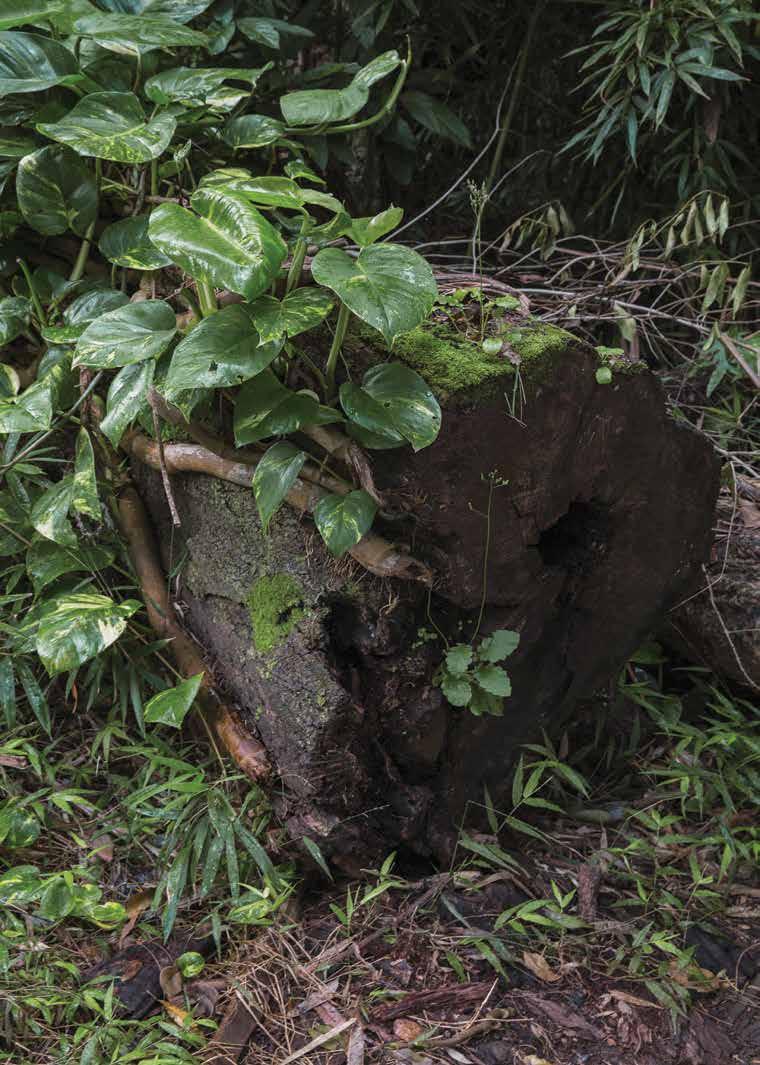
121
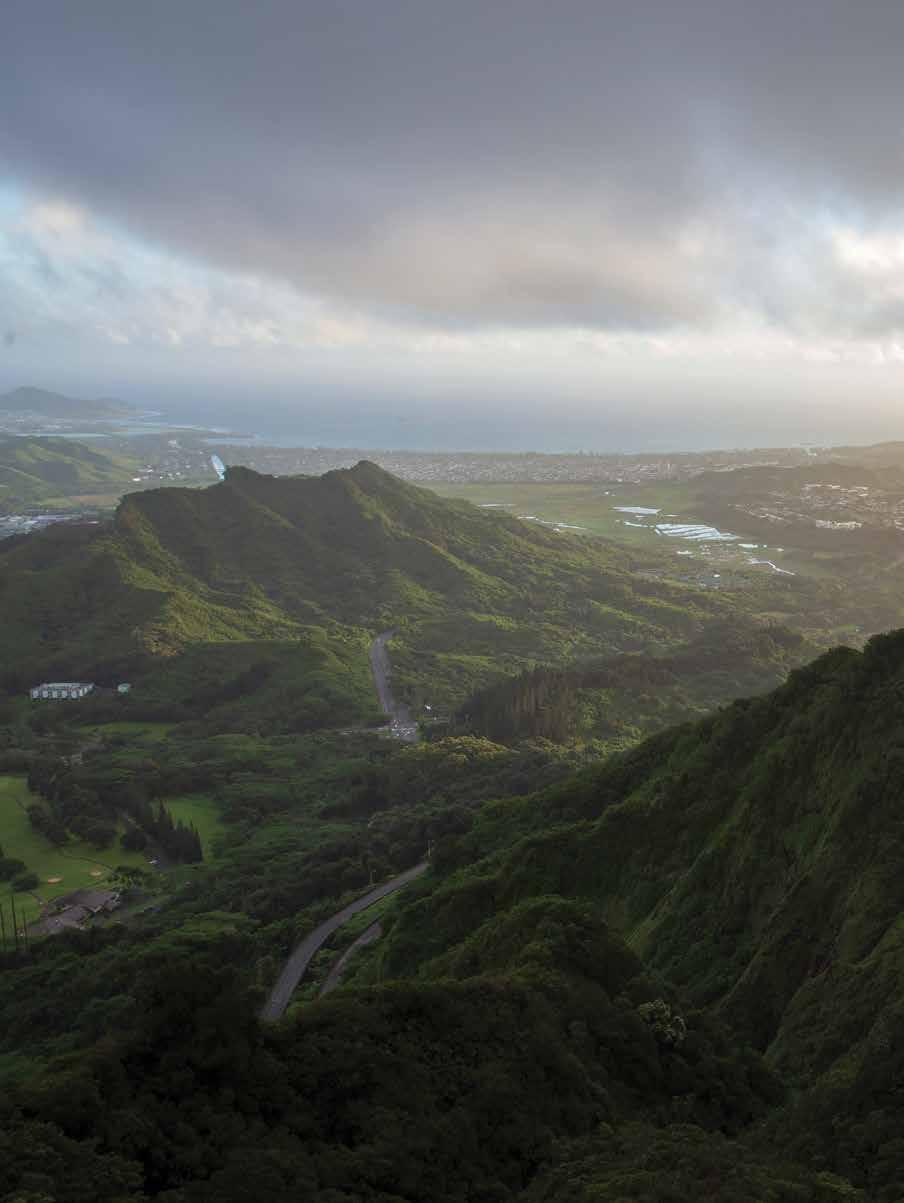

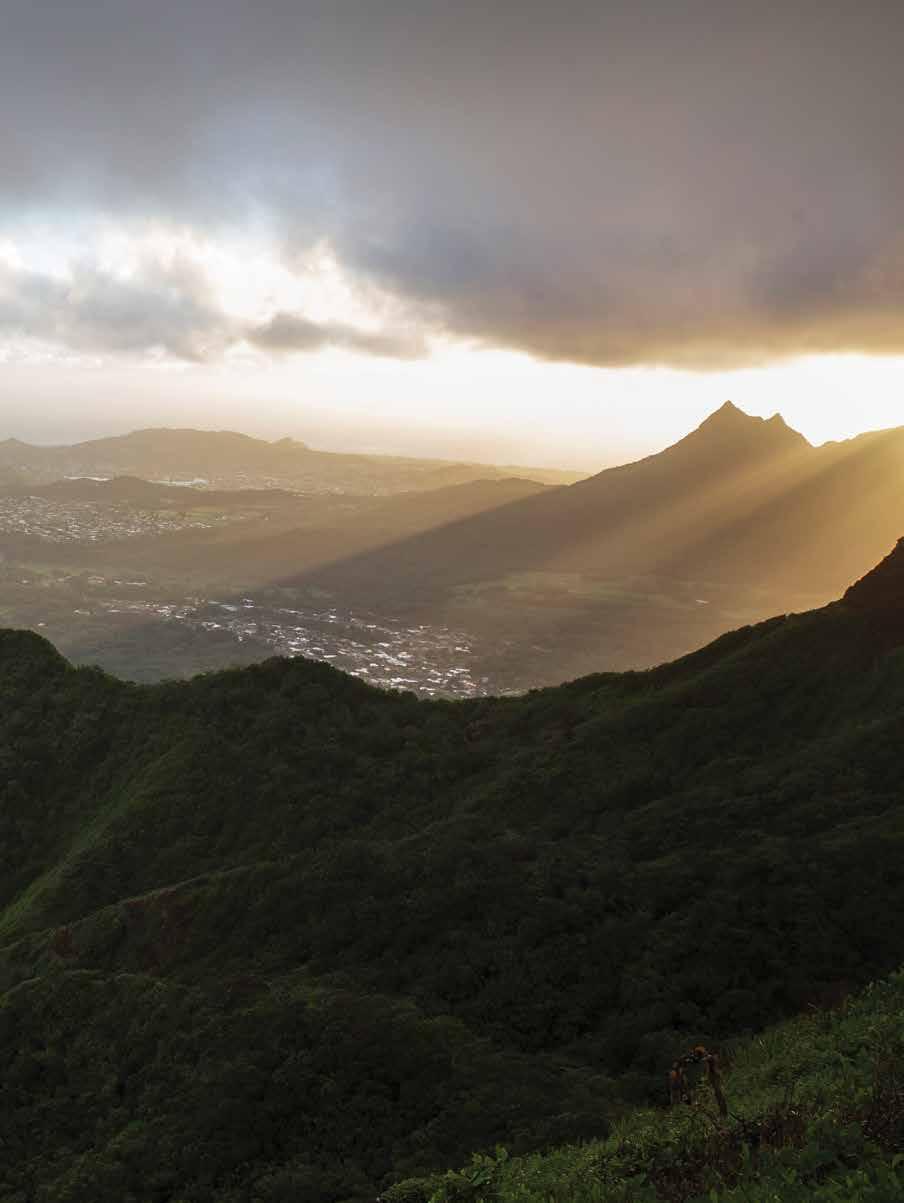
Lili‘uokalani composed her most famous song on the horseback ride home from a visit to Maunawili.
リリウオカラニは、マウナウィリ
からの帰路の馬上で最も有名 な曲を作曲した。

maunawili valley
Nestled below Mount Olomana, the fertile wet land of Maunawili is the backdrop for Lili‘uokalani’s composition “Aloha ‘Oe” (“Farewell To Thee”). In the 19th century, people traveled by horseback from Honolulu to the windward side through Nu‘uanu Valley and over the Nu‘uanu Pali, or by way of Waimānalo through Maunawili, which is what the royal party did on several occasions.
At Maunawili, Lili‘uokalani often visited the estate of the Boyds, a prominent Hawaiian-British family. It was during one such visit in 1878 that the then-princess was inspired by an affectionate farewell between Colonel James Boyd of her party and a young woman from Maunawili.
On the journey back to Honolulu, Lili‘uokalani formulated the words and melody of “Aloha ‘Oe” in her head. With the lyrics “one fond embrace, until we meet again,” it would become one of Hawai‘i’s most famous songs.
マウナウィリバレー
オロマナ山の麓にあるマウナウィリの肥沃な湿地帯は、リリウオカラニ 女王の作曲した『アロハ・オエ』(お別れの歌)の背景となっている。19 世紀当時の人々はホノルルからヌウアヌ渓谷を通りヌウアヌパリを越 え、またはワイマナロ経由でマウナウィリを通って、島のウィンドワード 側に馬に乗って移動した。それは度々王室が用いたルートでもあった。
リリウオカラニはマウナウィリにあるハワイアンと英国人の血を 引く名家のボイド家邸宅をよく訪れた。当時はまだ王女だった彼女が 同行者のジェームズ・ボイド大佐とマウナウィリの若い女性との切ない 別れに感銘を受けて曲を書いたのも、1878年にこの場所を訪れた時 のことだった。ホノルルまでの帰り道、リリウオカラニは頭の中で『アロ ハ・オエ』の歌詞とメロディーを作り上げた。「また会えるその時まで、最 後にもう一度あなたを抱きしめたい」という歌詞のこの曲は、ハワイを 代表する名曲のひとつとなっている。
124
Halekulani Living

The songs and chants Lili‘uokalani wrote during her lifetime often speak of love and convey her appreciation for the land.
リリウオカラニが生前に書 いた歌やチャントには、愛に ついて語るものやハワイと いう土地への感謝が込めら れたものが多い。
lower nu‘uanu valley
Lili‘uokalani composed the hula “Tutu” (“Grandmother”) for a benefit program at Kaumakapili Church, where she served as president under King Kalākaua’s benevolent organization, Hooulu Lahui. She managed Hooulu Lahui’s operations in “the lower part of Honolulu, Kaumakapili, extending as far as Ma‘ema‘e, and embracing the district beyond Palama,” according to her memoir.
“Tutu” was sung and danced by seven young girls as the grandchildren and Maria Heleluhe as the endearing tutu who loses her glasses often and forgets they are on her head. Lili‘uokalani accompanied on guitar.
“There lives at Ka‘ala‘ala‘a my aged, dear old grandmother,” the hula begins. “Her days were full of numbers that she lived in this world of care.” Ka‘ala‘ala‘a is in Lower Nu‘uanu and was likely chosen by Lili‘uokalani for its connection to her charity. But Nu‘uanu Valley also holds great significance to the Hawaiian people: It’s where the first man, Wākea, was born, and where the gods built the first heiau, a traditional temple.
kapālama
Royal residences were not uncommon in Kapālama. The area was farmed by Kamehameha I to provide for his people, and the land was handed down to his descendants. In 1884, Lili‘uokalani, then a princess, was excited to buy a piece of property next to Princess Ruth Ke‘elikolani’s Kapālama residence. She spent months upgrading her new home and planting gardens that included roses.
After moving in, she wrote the song “Nohea I Mu‘olaulani” to praise the estate she affectionately named Mu‘olaulani, which means “innumerable royal buds.” Mu‘olaulani is now the approximate site of Mayor Wright Homes between King Street and Vineyard Boulevard.
ヌウアヌ渓谷の下流 リリウオカラニは、カラカウア王の慈善団体「ホオウル・ラフイ」の代表と して会長を務めていたカウマカピリ教会で開催されるチャリティプログ ラム用に、フラの曲『トゥトゥ』(祖母)を作曲した。彼女の回想録によれ ば「ホノルル南部のカウマカピリからマエマエまで、そしてパラマの先の エリアを含む」ホオウル・ラフイの活動を統括していた。
7人の少女が孫役を、マリア・ヘレルヘさんがおばあさん役を演 じ、リリウオカラニのギターの伴奏に合わせて『トゥトゥ』を歌って踊っ た。頭の上にあるメガネをしきりに探す愛らしいおばあさんの歌だ。
「私の年老いた愛しいおばあさんはカアラアラアに住んでいる の」とフラは始まる。「心配事の多い世の中でおばあさんは沢山苦労を してきたわ」。
リリウオカラニはおそらく慈善団体とゆかりのある場所として、ヌ ウアヌの低地にあたるカアラアラアを選んだのであろう。しかもヌウアヌ 渓谷はハワイの人々にとって大きな意味を持つ。そこは最初の神 “ワー ケア”が生まれたとされる場所であり、神々が最初のヘイアウ(伝統的 な寺院)を建てた場所でもある。
カパラマ
カパラマには王室の邸宅が点在している。この地域はハワイの人々の 食糧供給のためカメハメハ1世によって耕作され、その土地は王の子孫 に受け継がれた。1884年、当時王女だったリリウオカラニは、ルース・ ケエリコラニ王女のカパラマ邸の隣にある物件の購入を喜んだ。彼女 は何ヶ月もかけて新しい住まいを改築し、バラをはじめとする沢山の植 物を庭に植えた。
入居後、彼女は“無数の王家のつぼみ”を意味する「ムオラウラ ニ」という愛称で呼んだこの家を称賛する曲『ノヘア・イ・ムオラウラニ』 を書いた。ムオラウラニは、キング通りとヴィンヤードブルバードの間 にある現在メイヤー・ライト・ホームズ住宅公社が建っているエリアに あった。
126 CITY GUIDES
Halekulani Living
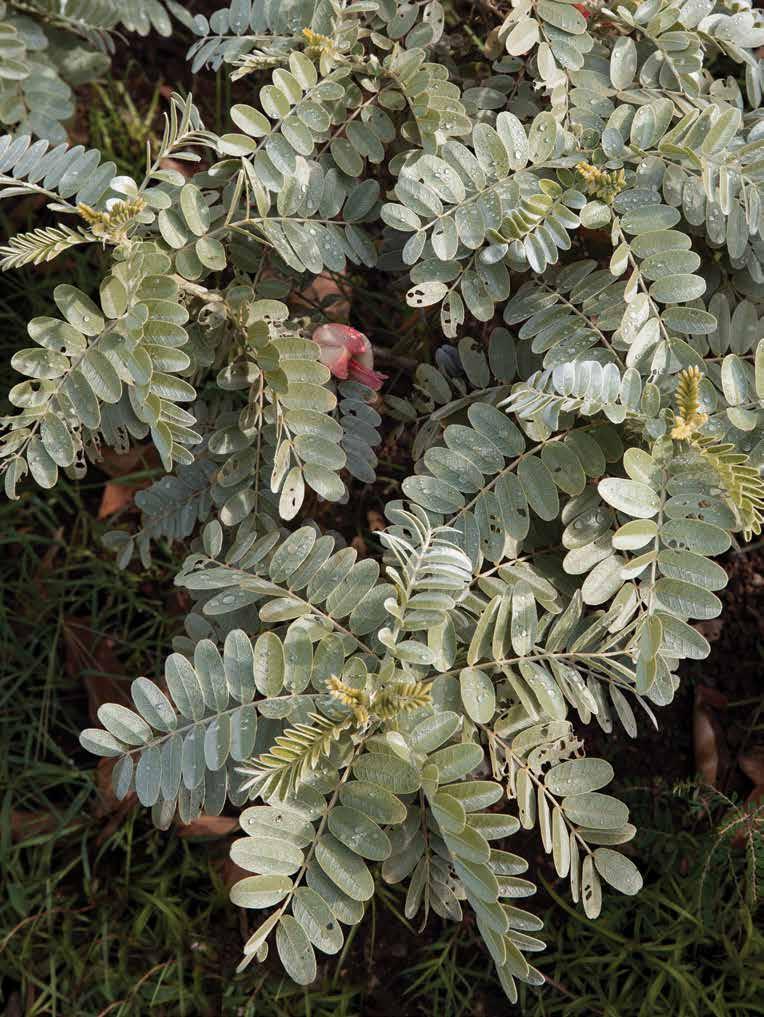
127
LOVING LYRICS
MORNING CATCH
ALA MOANA CENTER
TEXT BY ERIC STINTON
IMAGES BY
LILA LEE
文=エリック・スティントン
写真=ライラ・リー
THE MORNING CATCH
朝の釣果
For many cooped up at home during the pandemic, fishing is an excuse to get out of the house and out of one’s head.
パンデミックで家に閉じ込もっている多くの人にとって、釣りは最高の気分転換だ。
There are good reasons to go fishing early in the morning. Fish are more eager to eat after waking up, for starters. There are also fewer people around, an important corollary of those bleary hours just after dawn. The chance to take home some fresh food has always drawn people to the ocean, but the allure of an empty beach and open air has sparked a renewed interest in shoreline fishing during the pandemic. There is no better time than daybreak to be surrounded by fish and away from people.
Along the coasts of Waikīkī and Ala Moana, shore anglers cast for halalū, a small, silvery mackerel used primarily as bait but also enjoyed as a salty snack. When schooling as a large group, halalū resemble a dark cloud moving just beneath the surface. It can be an ominous sight, but not everything is as it seems. Take the pandemic, for example, when many have used their newfound downtime to slow down, change course, or pick up a new skill, like learning to fish.
Liminal moments are the best, most productive opportunities for fishing. When the morning tides shift from low to high, water rushes into tidepools and reefs, creating tidal currents that stir up sediment and attract small fish, which in turn attract bigger fish from deeper waters. Tides and moon phases, surface conditions and submarine seasonality—these are the languages newcomers must learn to successfully haggle with fish, those notoriously hard bargainers.
早朝の釣りにはもっともな理由がある。第一に目覚めたての魚たちは食 欲旺盛だ。そして夜が明けて間もない霞がかった時間帯は、必然的に 周りに人が少ない。新鮮な魚を家に持ち帰れる釣りはこれまでも人々 を海に引き付けてきたが、パンデミック以降はさらに人気のないビーチ とアウトドアを楽しめるショアラインでの釣りが新たな注目を集めてい る。人から離れることができ、たくさんの魚が群れる夜明けほど釣りに 適した時間はない。
ワイキキとアラモアナの海岸沿いで釣りをするショアアングラー たちは、主に餌として使用され、塩味のつまみとしても美味しい銀色の サバの稚魚“ハラルー”を目当てにキャスティングする。大きな塊となっ て群れ泳ぐハラルーは、水面下を移動する暗い雲のようだ。一見不吉な 光景のようだが、物事は見た目では判断できない。パンデミックにおい ても、多くの人が急にできた空き時間を利用して、進路やキャリアチェン ジをしたり、釣りなどの新しい趣味やスキルを習得している。
薄暗い時間帯は釣りにおいてもっとも生産的な最高の時間だ。 朝の干潮が満潮に変わると、水が潮溜まりやサンゴ礁に流れ込んで潮 流が発生し、堆積物をかき混ぜて小さな魚を引き付ける。この小魚に引 き寄せられて大きな魚が深海からショアへと入ってくる。釣りの初心者 たちも魚と付き合っていくためには、潮汐と月の満ち欠け、海面のコン ディション、海域の季節変動について学ばなければならない。それでも 多くのショアアングラーにとってどれだけ釣れたかは重要でなく、むし ろ釣れるか釣れないかの問題ではない。他のどの場所でもない、そこに いるだけで十分なのだ。朝釣りの魅力は、機能的であり哲学的、実利的 であり詩的な点だ。
128 Halekulani Living
CITY GUIDES

Along the coasts of Waikīkī and Ala Moana, shore anglers of all ages cast for halalū, a small, silvery mackerel used primarily as bait but also enjoyed as a salty snack.
ワイキキとアラモアナの海岸沿いでは幅広い年齢層のショアアングラ ーたちが、主に餌として使用され塩味のつまみにもなるサバの一種の 銀色をした小魚 “ハラルー”を目当てに釣りを楽しんでいる。
129


Yet many shore anglers don’t care how much fish they catch at this hour, or if they catch any fish at all. Just being there—and not elsewhere—is enough. The allure of dawn patrol fishing is both functional and philosophical, pragmatic and poetic.
Successfully reeling in a fish comes with obvious material benefits. Head east from O‘ahu’s southern shores and you’ll find experienced anglers in Kailua casting for pāpio and ‘ō‘io, trevallies and bonefish weighing 10 pounds or more. These are feasts that easily justify waking up in the darkness of early morning.
But even unsuccessful fishing has its rewards: the crisp clarity of waves lapping against the shore; the atmospheric superposition of colors, how black sky above descends into blue, then pink, then a golden yawn on the horizon. The appeal of early morning is the quiet conversation with the vast: the eternal crawl of clouds, the endless undulations of the sea and its invisible cosmic tethers. Fishing is a chance to get out of our houses, and out of our heads.
If you ask shoreline casters why they choose to spend their mornings this way, they probably won’t tell you any of that. They tend to be people of few words, especially before sunrise. But if you observe them long enough, they might move beyond sparse, practical conversation and reveal something more profound. It may not seem like much at first, but listen carefully to their relieved exhales, look closely at their acceptance of the elements on their faces. You’ll see it—the benefits of fishing go beyond that of a leisurely pastime.
Fishing is a meditation on patience and struggle, an existential balm for the chaos and uncertainty of a life both in transit and in transition. Casting a line out from Waikīkī and Ala Moana may yield enough halalū to bait larger fish elsewhere, or to pack away some side snacks for later on. Or maybe, it’ll yield nothing but a brief glimpse of our nearby star subsuming the light of countless distant stars. No matter the outcome, fishing offers the chance to swim in simple yet profound depths, not unlike the ones from which the morning catch arrives.
もちろん釣果がある日の釣りは趣味と実益を兼ねている。オアフ 島の南岸から東へ向かったカイルアには、経験豊富な釣り人たちがパ ピオやオーイオ、アジ、重さ4.5キロにもなるソトイワシを釣り上げてい る。これほどのご馳走が釣れるのであれば、まだほの暗い明け方に起き 出す価値も十分にあるだろう。
だが一匹も釣れない朝にも見返りはある。岸に打ち寄せる波の 澄み切った透明度。上空の黒が徐々に青、ピンク、地平線を染める金色 へと移り変わる大気のグラデーション。朝釣りの醍醐味は、広い自然界 との静かな会話にある。どこまでも流れゆく雲、果てしなく続く海のうね り、そして目に見えない宇宙とのつながり。釣りは外へ出て頭をリセット する最良の手段だ。
海岸で釣りを楽しんでいる人たちに早起きして釣りをしに来る理 由を尋ねてもきっとそんな答えは返ってこないだろう。日の出前から釣 りをする人たちはとりわけ口数が少ない傾向にある。そんな彼らでもじ っと眺めていると、必要最小限の会話の枠を越えた彼らの内なる声が 聞こえてくる。最初は大したことではないと思うかもしれないが、彼らの 安堵のため息に耳を傾け、ありのままの自然を受け入れた彼らの表情 を注意深く見てほしい。そうすれば釣りには単なる娯楽以上の効果が あることに気づくだろう。
釣りは忍耐力を鍛え、心の葛藤から開放してくれる時間だ。変化 の真っ只中にある人生の混乱や将来への不安を癒してくれる。ワイキ キとアラモアナで竿をキャストすれば、大きな魚の餌にしたり、おつま みに持ち帰るのに十分なハラルーが釣れるかもしれない。あるいは遠 くに数え切れないほどある星たちの中でひときわ明るく輝く星が近く に一瞬見れるだけかもしれない。釣りはその釣果にかかわらず、魚が獲 れる海と同じようにシンプルでありながらディープで意義深い時間を 与えてくれる。
Halekulani
132 CITY GUIDES
Living
CITY GUIDES
LOVING LYRICS
MORNING CATCH
ALA MOANA CENTER

CARTIER
カルティエ
Equal parts extravagant elegance and serious charm, the Clash de Cartier collection takes on new forms this year with designs that touch on contemporary elegance and architectural ingenuity. A collection rooted in duality, Clash de Cartier embraces the modern spirit through its inherent paradoxes. Studs, beads and clous carrés merge into a singular ribbed mesh, allowing metal to take on mobile form.
First launched in 2019, Clash de Cartier captured hearts (and wrists and hands) with the magnificent contrasts of soft, feminine curves and bold, architectural tautness. It is a collection that possesses an innate sense of proportion that draws on pure Cartier style. Since its debut, it has joined the iconic ranks of the Maison's collections, simultaneously modern and grounded in the aesthetic prowess of Cartier.
TEXT AND IMAGE COURTESY OF CARTIER
Cartier Ala Moana Center, Level 2 Call 808.955.5533 to book an appointment.
133
文&写真=カルティエ提供

Fishing is a meditation on patience and struggle, an existential balm for the chaos and uncertainty of a life both in transit and in transition.
釣りは忍耐と苦労について瞑想できる時間であり、変化の真っ只中にある人生における混乱や将来への不安を癒してくれるものだ。

Halekulani, the most internationally acclaimed of all Hawai‘i hotels, blends serenity and understated elegance with exceptional service to create an oasis of tranquility.
ハワイを代表するホテル、
ハレクラニは、オアシスのような 安らぎと上質なエレガンス、
一流のサービスでお客様を お迎えしています。

136

HALEKULANI GUIDE

LEGACY
レガシー
Halekulani’s beachfront location has welcomed people since 1883, when the original owner, Robert Lewers, built a two-story house on the site of what is now the main building.
ハレクラニの建つワイキキのビーチフロントは、1883年にロバート・ルワーズ氏が現在のメインビルディングのある場所に2階建ての家を建てて以来、多くの人々を迎えてきました。
The fishermen of the area would bring their canoes onto the beach in front of the property to rest. So welcomed were they by the Lewers family that the locals named the location “house befitting heaven,” or Halekulani.
In 1917, Juliet and Clifford Kimball purchased the hotel, expanded it, and established it as a stylish resort for vacationers, giving it the name the locals originally bestowed on it, Halekulani. The hotel was sold following the passing of the Kimballs in 1962. Almost 20 years later, it was purchased by what is now the Honolulu-based Halekulani Corporation. The hotel was closed and rebuilt as the existing 453-room property.
Today, Halekulani’s staff, location, and hospitality reflect the original Hawaiian welcome that defined the property.
ルワーズ一家が、邸宅前のビーチにカヌーを引き揚げて休憩するワイキキの漁師たちを歓迎 したことから、地元の人たちはこの場所を「天国にふさわしい館」という意味の ハレクラニと呼ぶようになりました。
1917年にジュリエット&クリフォード・キンバル夫妻によって購入、拡張されたこのホテル は、バカンス旅行者のための洗練されたリゾートとして生まれ変わり、地元の人たちによって つけられた「ハレクラニ」と命名されました。1962年、キンバル夫妻の死去を機に売却 されたホテルは、ほぼ20年後、現在ホノルルに拠点のあるハレクラニ・コーポレーションに よって購入され、一時閉館すると、改築工事を経て、現在の453室あるハレクラニに生まれ 変わりました。
ハレクラニでは、歴史あるワイキキのビーチフロントで、現在も昔と変わらないハワイ ならではのおもてなしの心で、スタッフ一同お客様をお迎えいたします。
HALEKULANI GUIDE 138
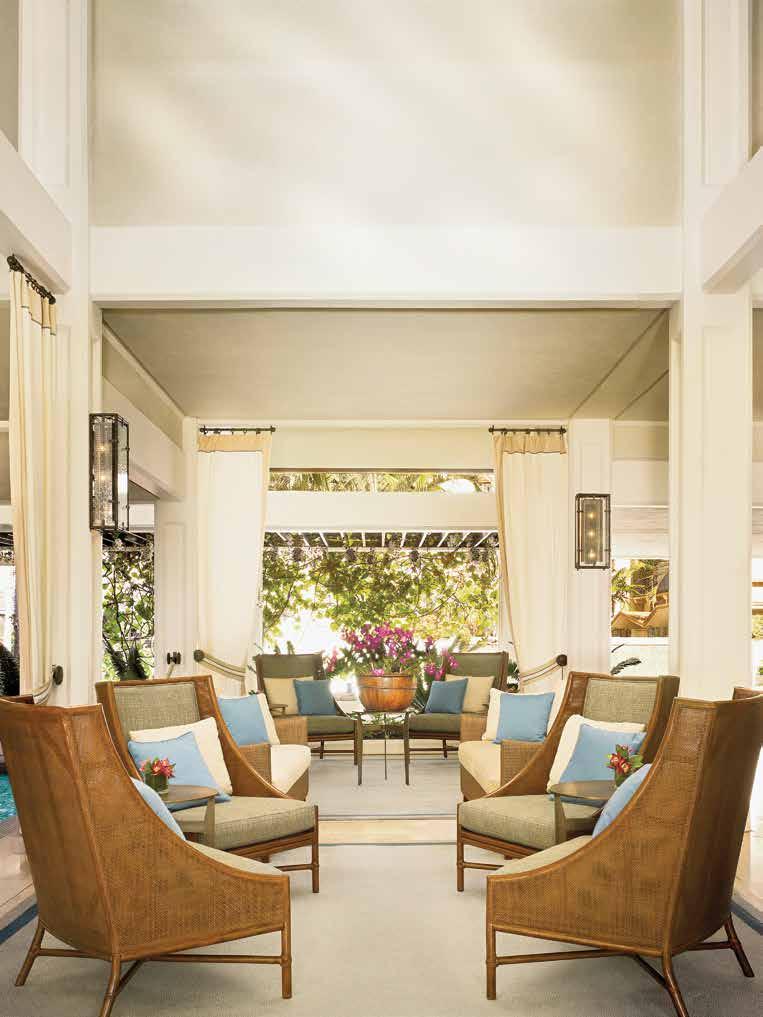
139

DINING
ダイニング
At Halekulani’s Waikīkī restaurants, awardwinning chefs create signature dishes from Hawai‘i’s freshest ingredients.
ハレクラニのレストランでは、数々の受賞歴を誇るシェフによる、ハワイの新鮮な素材を使ったオリジナル料理をご用意しています。
Each of Halekulani’s restaurants celebrates its own distinct style of cuisine, and all offer stunning views of the sea.
Select from La Mer for fine dining, Orchids for more casual elegance, and, reopening in November, House Without A Key for a relaxed ambience.
ハレクラニのレストランでは、美しいオーシャンビューとともに、それぞれに特徴のある 多彩な料理の数々をお楽しみいただけます。
ファインダイニングのラ メール、カジュアルでエレガントなオーキッズ、そして11月にリ ニューアルオープンするリラックスした雰囲気のハウス ウィズアウト ア キーでのお食 事をお楽しみください。
140 HALEKULANI GUIDE





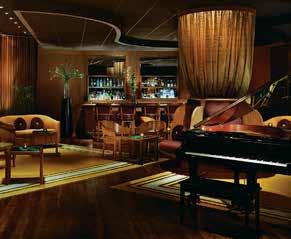
141 +
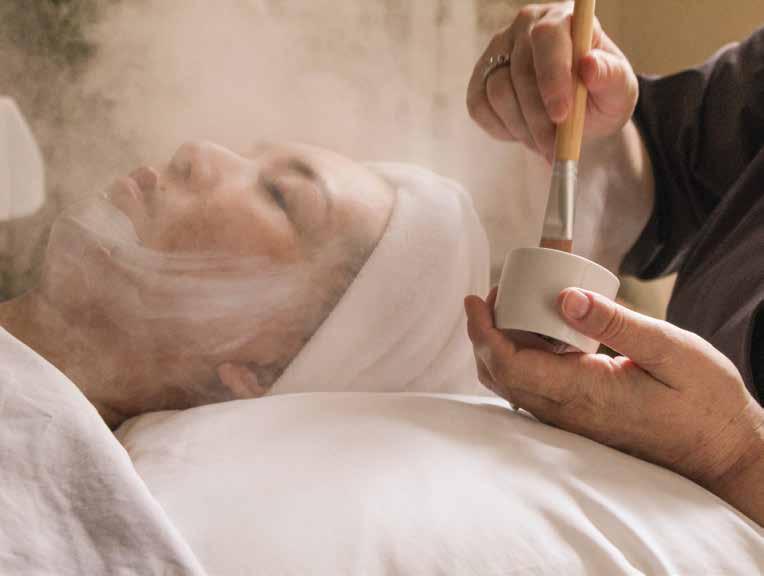
SPAHALEKULANI
スパハレクラニ
SpaHalekulani intertwines authentically crafted Polynesian therapeutic rituals with today’s purest products and proven techniques, elevating the spa experience to be both immersive and rejuvenating.
数々の賞を受賞しているスパハレクラニでは、オーガニックなプロダクトと施術師の確かな技術に、本格的なポリネシアの治療法を取り入れた、 心身に活力を与える深い癒しのスパトリートメントをご提供しています。
The award-winning spa is renowned for a commitment to harmoniously restoring the mind, body, and spirit of guests with a respite that is spiritual, cultural, and emotional.
心と身体の調和バランスを取り戻し、豊かなポリネシア文化の香るスピリチュアルな 安らぎのひとときをお楽しみください。
142 HALEKULANI GUIDE




143

A HUI HOU 144 IMAGE COURTESY OF HALEKULANI


 Ulrich Krauer
General Manager Halekulani
Ulrich Krauer
General Manager Halekulani









 Chanel
Chanel















 IMAGE BY JOSIAH PATTERSON
IMAGE BY JOSIAH PATTERSON
















 TEXT BY JOSH TENGAN
IMAGES BY MARK KUSHIMI BEAUTY AND BATIK
TEXT BY JOSH TENGAN
IMAGES BY MARK KUSHIMI BEAUTY AND BATIK




































 TEXT BY EUNICA ESCALANTE
TEXT BY EUNICA ESCALANTE


























 CYC big shirt dress from Bās Bookshop. Matt Bruening Kennedy jacket.
CYC big shirt dress from Bās Bookshop. Matt Bruening Kennedy jacket.

 Maile aloha shirt in Sage and Joey Trisolini jacket, both from Salvage Public.
Maile aloha shirt in Sage and Joey Trisolini jacket, both from Salvage Public.








 Hat, bandana, shirt, and jacket from Single Double.
Hat, bandana, shirt, and jacket from Single Double.
 Hat from Single Double. CYC x KarloBuenobello jacquard vest and CYC pleated shirt dress from Bās Bookshop.
Hat from Single Double. CYC x KarloBuenobello jacquard vest and CYC pleated shirt dress from Bās Bookshop.

 CYC kaleidoscope dye khadi pants and dress shirt from Bās Bookshop. Hat from Single Double.
CYC kaleidoscope dye khadi pants and dress shirt from Bās Bookshop. Hat from Single Double.




 TEXT
TEXT































